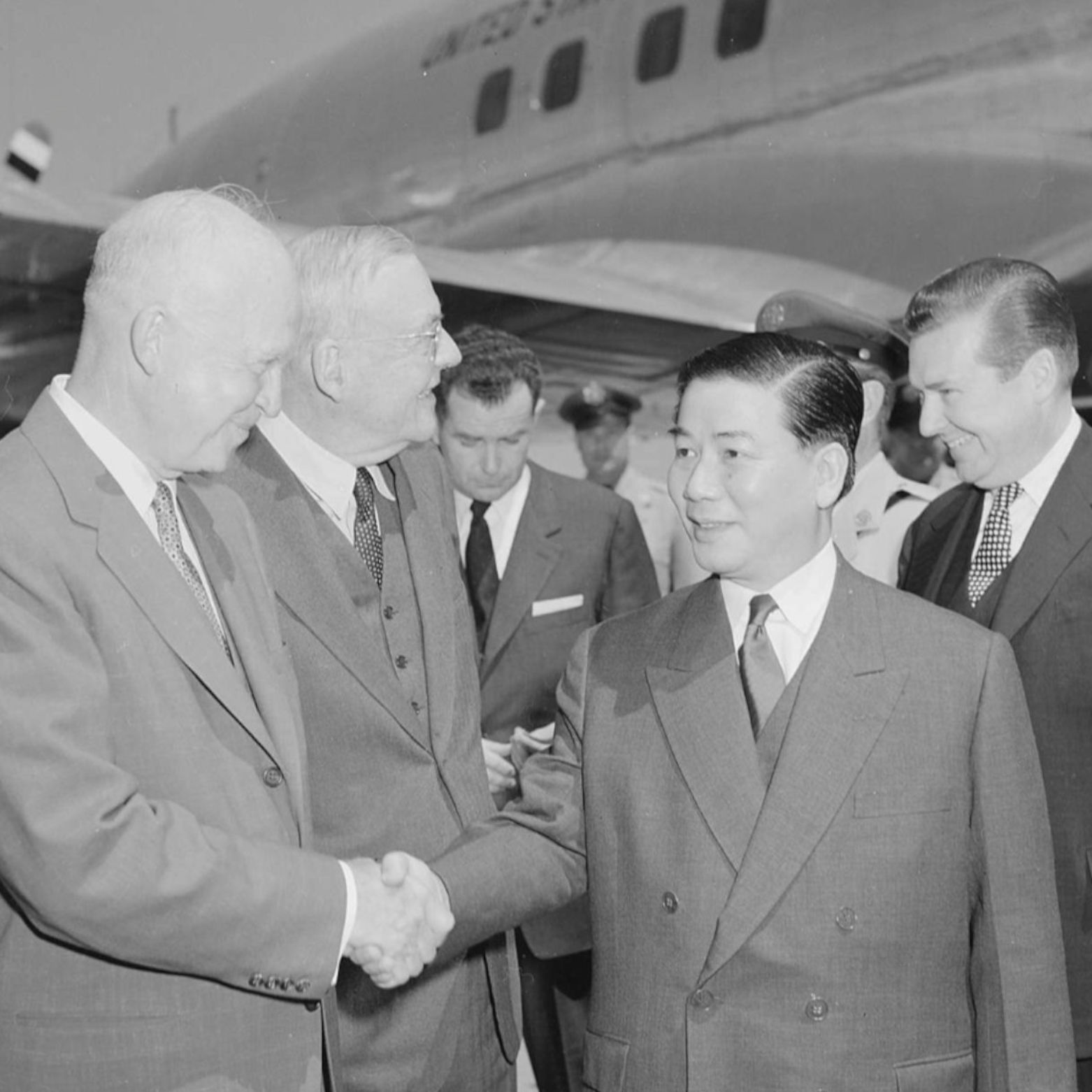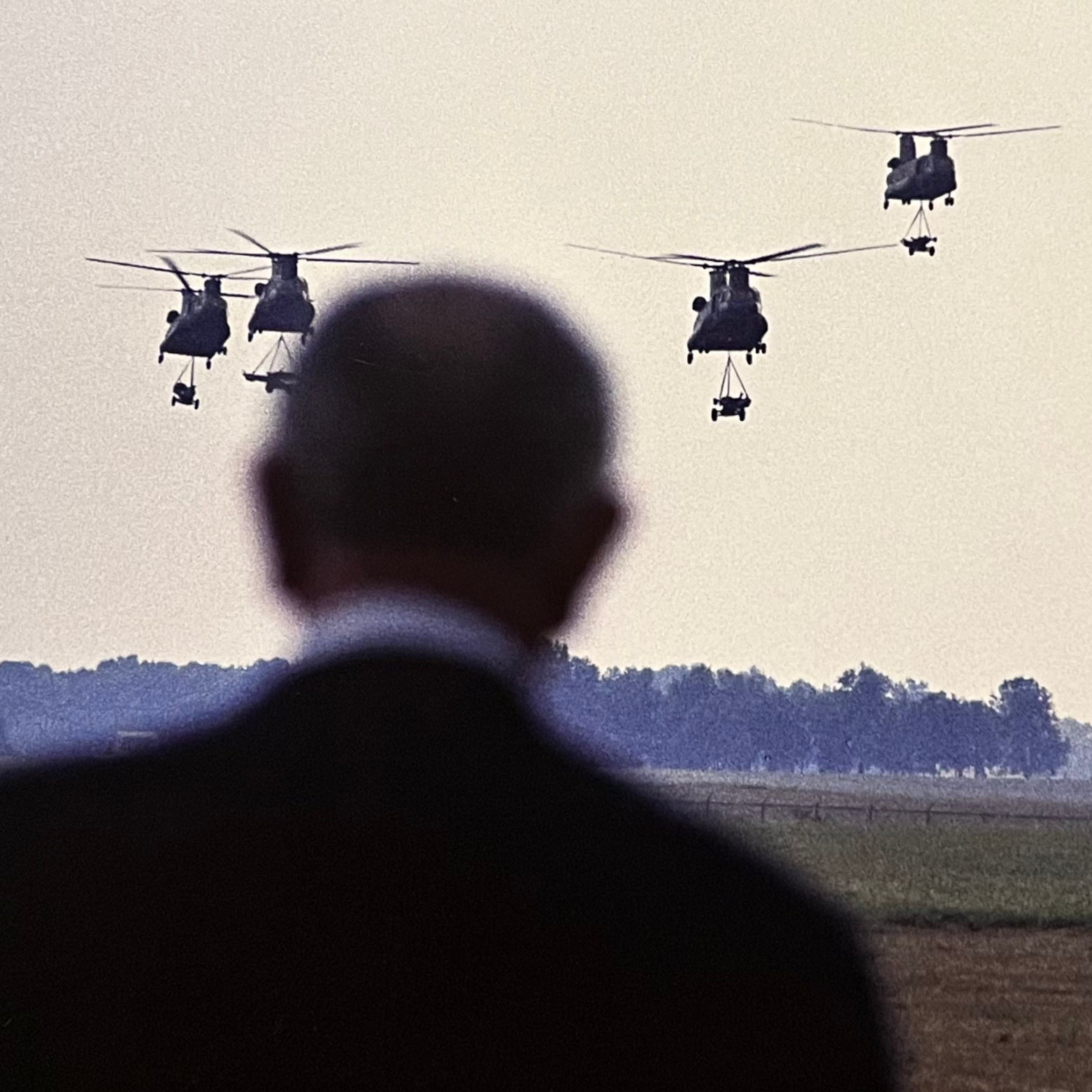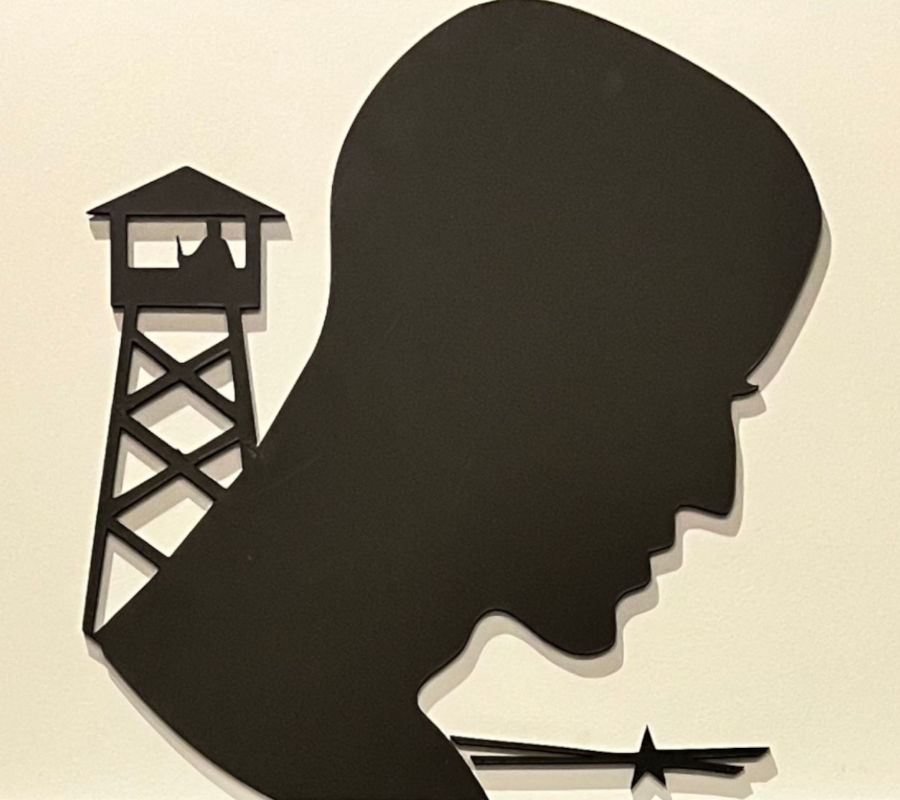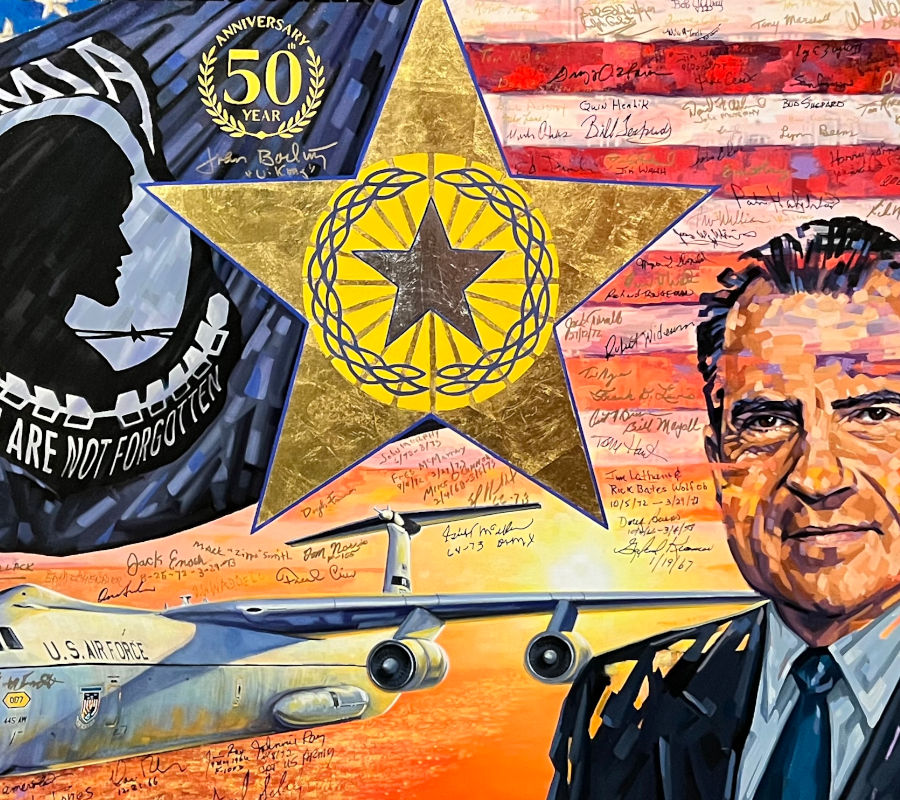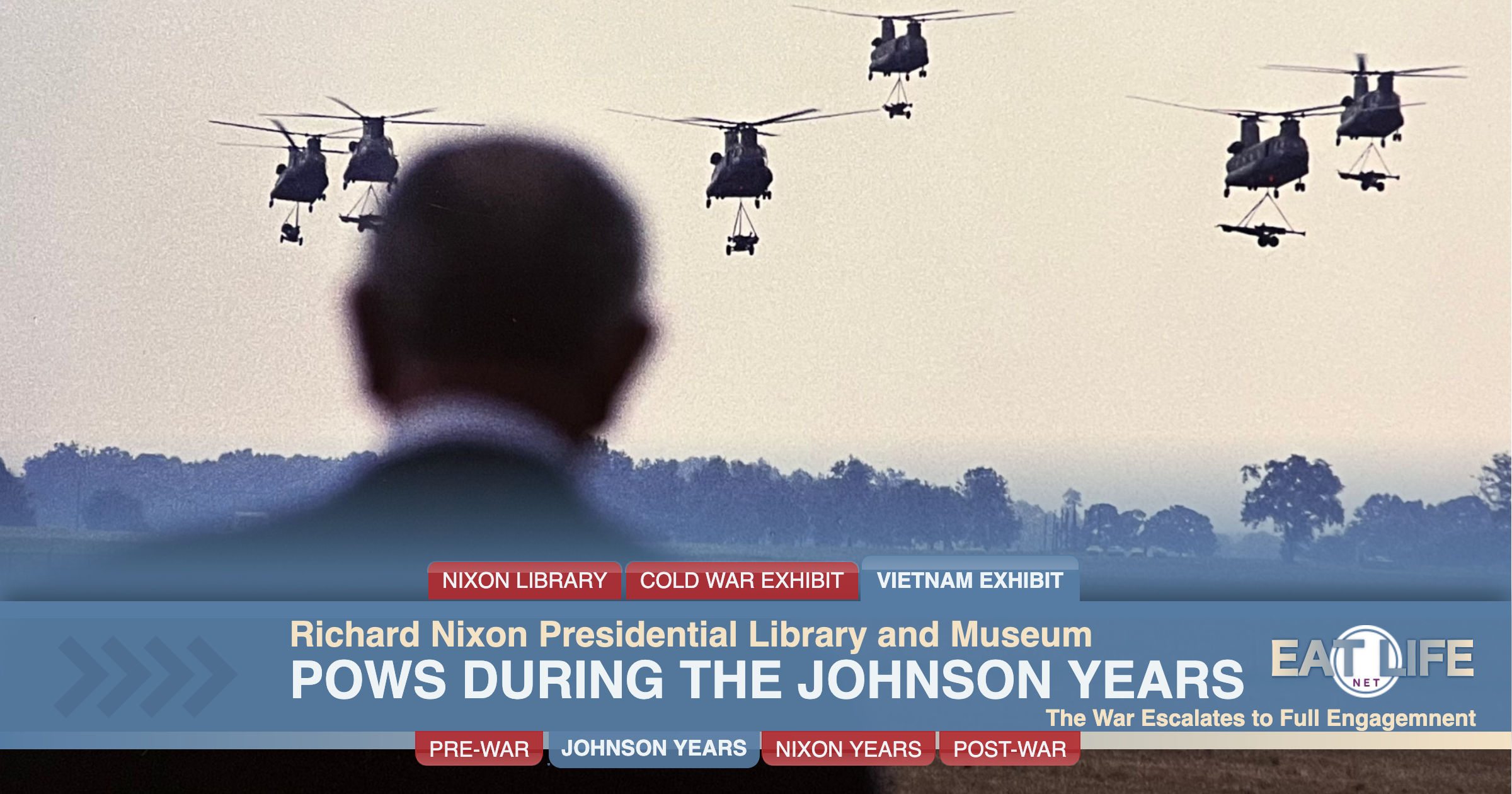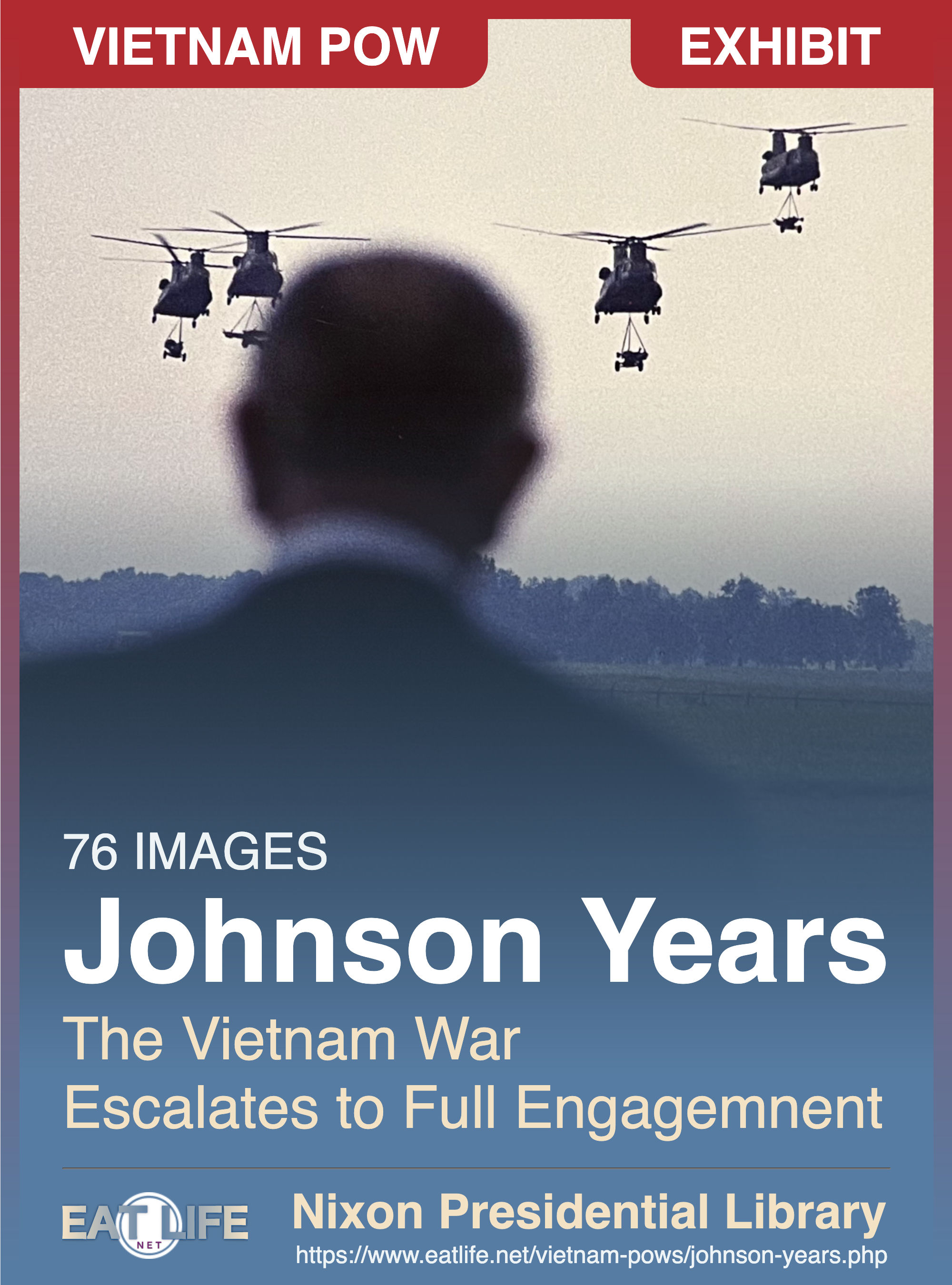VIETNAM EXHIBIT:
Lyndon B. Johnson Becomes President
After the assassination of President John F. Kennedy
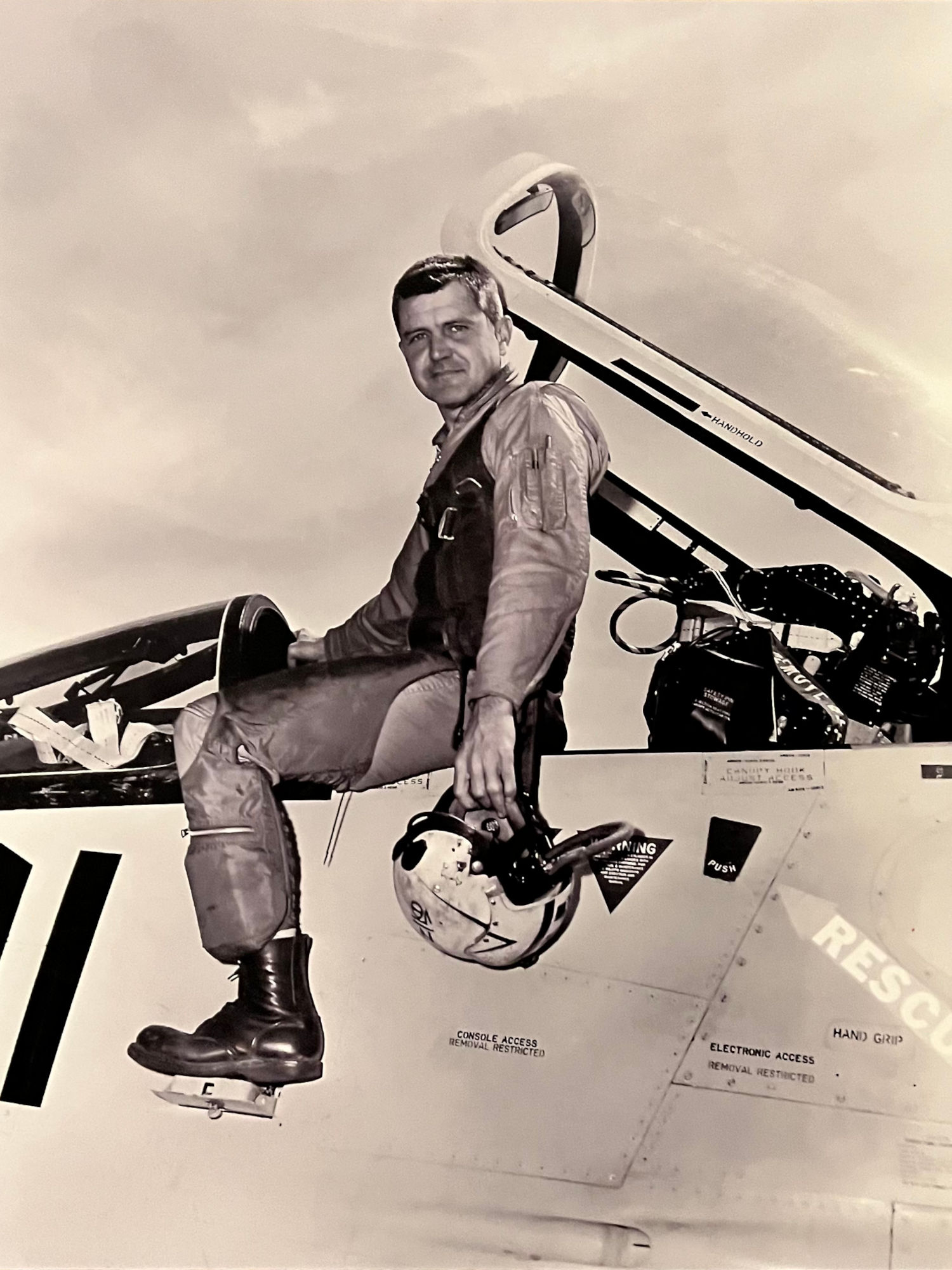
James Stockdale
Gulf of Tonkin
Naval aviator and future POW James Stockdale sits astride the open cockpit of an F-8 Crusader jet.
Welcome to the Hanoi Hilton
Hell's Hole
Among the 13 prison camps that housed American prisoners of war in North Vietnam, the Hanoi Hilton was the most notorious. It was built in stages from 1886 to 1901 by the French during their long colonial rule. Its name in Vietnamese is Hoa Lo, which translates to "fiery furnace" or "Hell's Hole." The POWs there would come to call it the Hanoi Hilton, in a supreme bit of irony.
On August 11, 1964, captured Navy pilot Lieutenant Junior Grade Everett Alvarez was the first American housed in the Hanoi Hilton. Over the course of the next nine years, nearly 600 POWs would live there in some of the most brutal, inhumane conditions ever endured by any American POWs in history. The last prisoner left the Hanoi Hilton on March 28, 1973.
Despite the deplorable conditions of the prison and the horrific treatment the POWs received, the prisoners managed to find ways to communicate with one another, support each other, and occupy their minds.
WIKIPEDIAEverett Alvarez Jr.
United States Navy officer who endured one of the longest periods as a prisoner of war in U.S. military history. Alvarez was the first U.S. pilot to be shot down and detained during the Vietnam War and spent over eight years in captivity, making him the second longest-held U.S. POWOn August 5, 1964, during Operation Pierce Arrow, Lieutenant Junior Grade Alvarez's Douglas A-4 Skyhawk was shot down in the immediate aftermath of what is known as the Gulf of Tonkin incident. Alvarez endured eight years and seven months of brutal captivity by the North Vietnamese at the Hoa Lo Prison (sarcastically known as the "Hanoi Hilton" by fellow POWs), in which he was repeatedly beaten and tortured. Alvarez was especially esteemed by his fellow prisoners because he was for almost a year the only aviator prisoner of war.
He was released on February 12, 1973 as part of the first group of American POWs repatriated under Operation Homecoming, after spending 3,113 days in captivity.
Recipient of
- The Silver Star
- Two Legions of Merit
- The Distinguished Flying Cross
- Two Bronze Star Medals
- Two Purple Hearts
Escalation
The largest escalation of American involvement in Vietnam took place under Kennedy's successor, President Johnson.
On October 21, 1964, Johnson said,
We are not about to send American boys 9 or 10,000 miles away from home to do what Asian boys ought to be doing for themselves.
Months later, on March 8, 1965, Johnson sent the first American regular combat troops. When he left office in January 1969, more than 540,000 American troops were fighting in Vietnam.
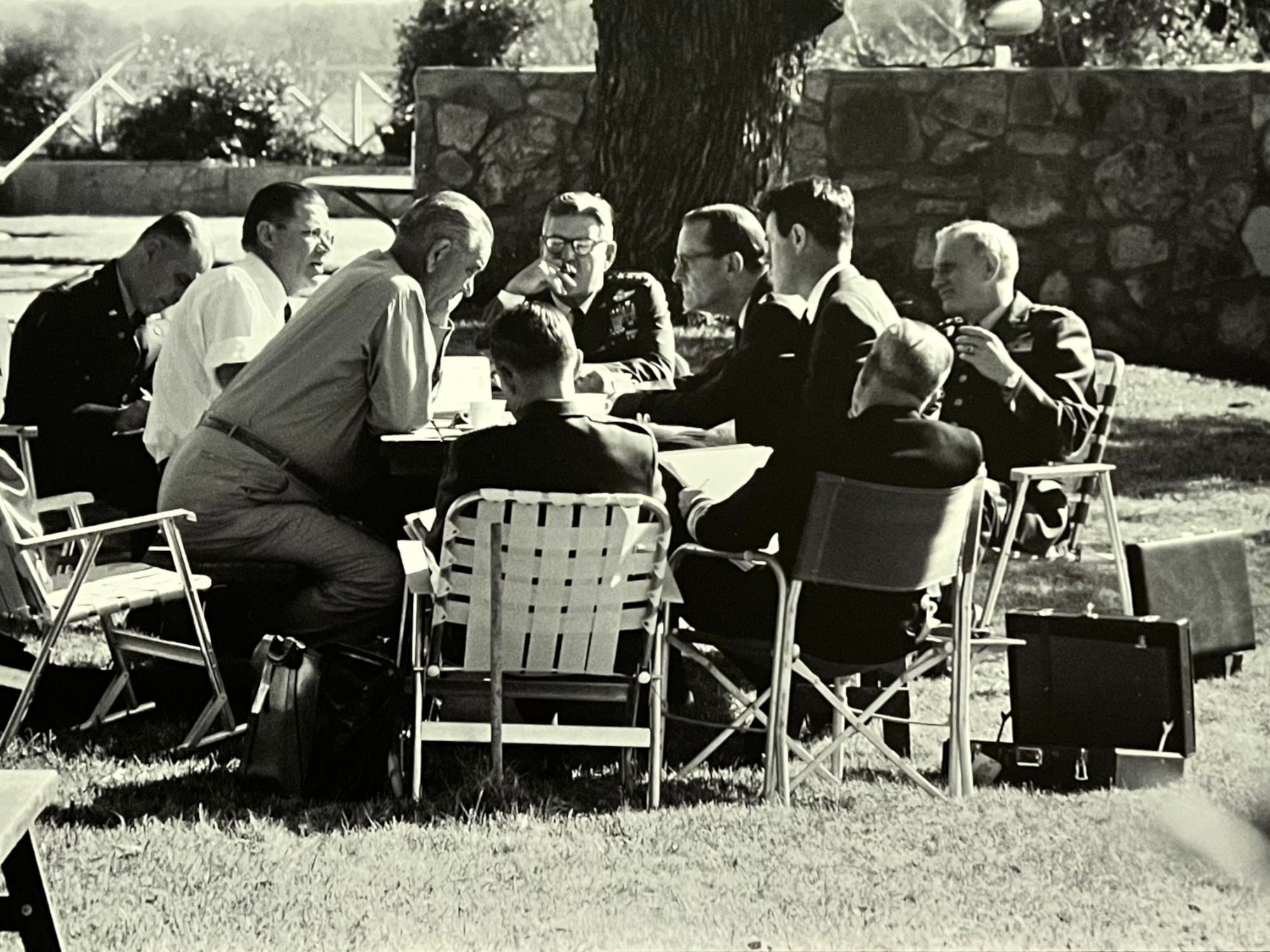
Joint Chiefs of Staff
LBJ Ranch, Texas
President Johnson meets with his highest level advisors, described as the best and brightest minds on Vietnam, at his ranch in Texas.
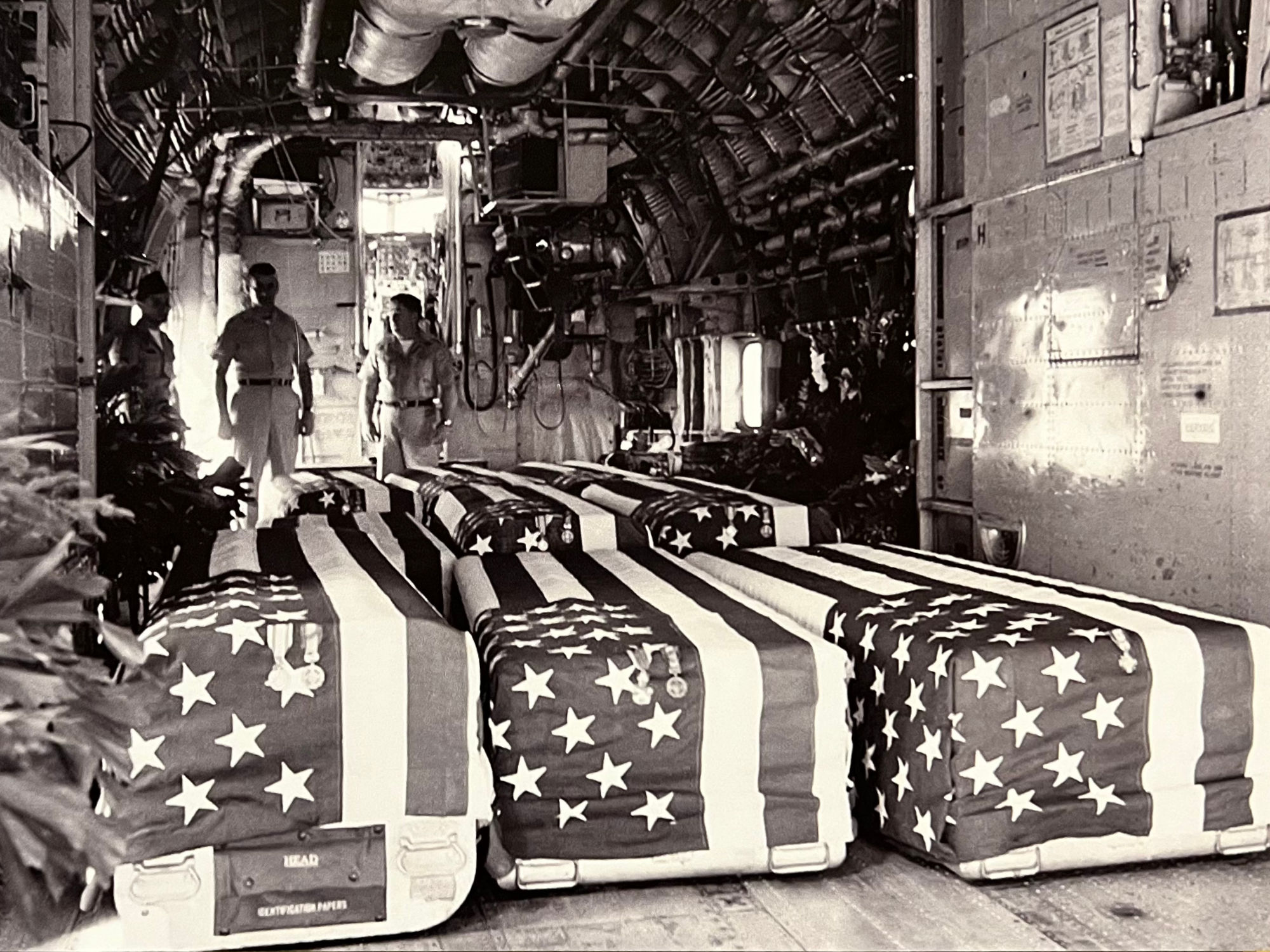
Ultimate Sacrifice
The remains of eight fallen soldiers lie in flag-draped coffins, awaiting return home after making the ultimate sacrifice in February 1965.
The Air War in Vietnam
President Johnson began the escalation of America's involvement in Vietnam.
- Johsnon ordered a massive increase in American combat troops, which eventually numbered more than 500,000 in the region.
- Johnson also initiated what has been described as
... one of the longest sustained bombing campaigns in history.
Operation Rolling Thunder
Began in March 1965 and continued until November 1, 1968
It was carried out from Air Force bases in South Vietnam and Thailand and from U.S. Navy aircraft carriers in the seas off the coast of Vietnam. The operation ended the day after President Johnson announced a halt to the bombing campaign. His hope that this would speed progress in ending the war was not realized.
The Ready Room
Aircraft carriers played an important role in the air war against North Vietnam.
Before every bombing mission, pilots and weapons officers would gather in one of the carrier's ready rooms. There, the flight leader would brief the aviators in his squadron about the upcoming mission. A squadron of fighter aircraft was usually comprised of 12 to 14 planes.
The briefings would include information about the targets of the mission. They would also be briefed on any intelligence about the enemy's air defense they might encounter, what kind of bombs and other weapons they would be carrying, and emergency procedures.
Aviators would return to the ready room after completing their mission to debrief.
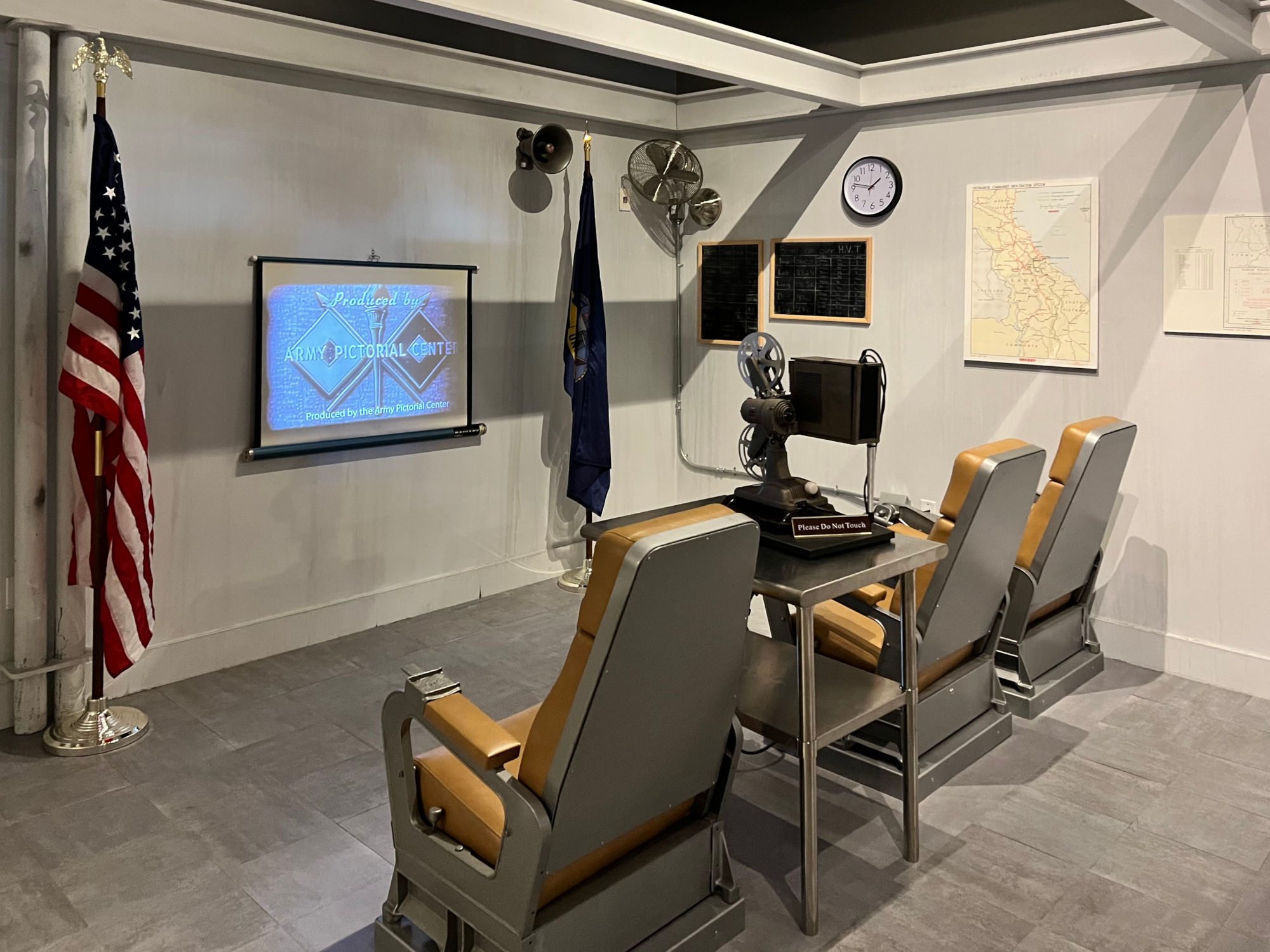
Aircraft Carrier Ready Room
Display Prop
A ready room also served as a lounge for its squadron. It was equipped with comfortable chairs and plenty of coffee. There, aviators could relax and socialize together when not flying, eating, or sleeping.
Call Signal Station
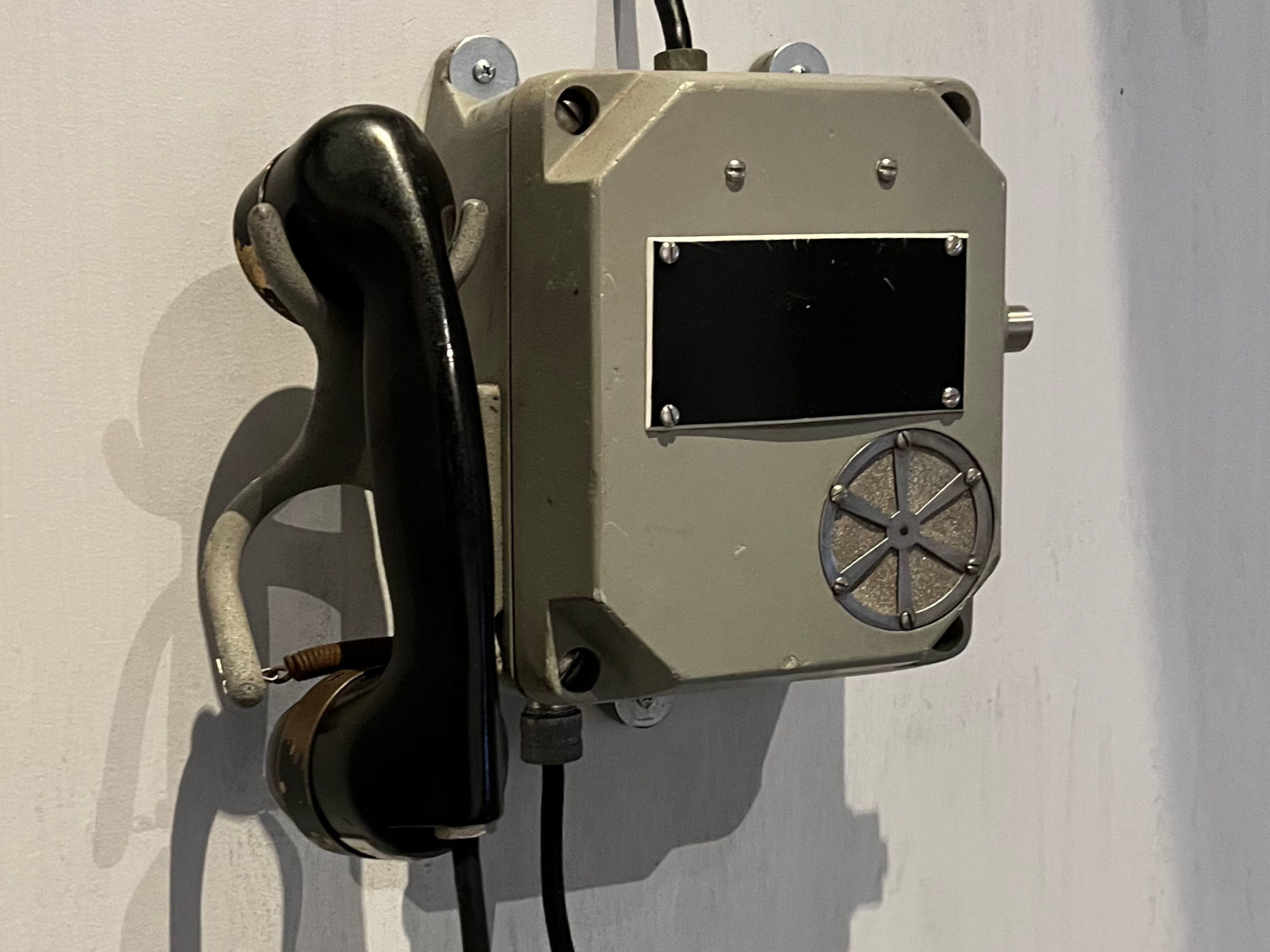
Those Who Fought
America's major involvement in the Vietnam War lasted from the introduction of regular combat troops in 1965 to the final withdrawal in 1973. During that time, 3.4 million members of the Armed Forces were deployed to Southeast Asia. About four of every ten service members during that eight-year period served in the region.
Most of those serving had voluntarily joined the armed services. When President Johnson escalated America's involvement, more troops were needed. The Selective Service - the federal agency responsible for the draft - dramatically ramped up the number of draftees.
The Draft
Young men aged 18 to 26 years were subject to the draft during this period. About 1.7 million were drafted into the armed forces. About nine percent of the 27 million young men eligible in America served in Vietnam.
Fighting with One Arm Tied Behind Your Back
In any military conflict, the fighting forces are provided with rules of engagement (ROE). These rules define what actions the military can and cannot take in conducting the war.
In the Vietnam War, the United States did not seek the military defeat of North Vietnam. Instead, it sought a negotiated peace which left both North and South Vietnam standing. Therefore, the rules of engagement for American forces in Vietnam were different - more restrictive - from those in previous wars.
From 1965 until 1968, during the Rolling Thunder air campaign, the rules of engagement placed numerous strategic targets in North Vietnam off-limits to bombing.
Major Ricky Drake wrote in 1992 that,
America's self-imposed, overly restrictive ROEs violated United States Air Force doctrine and greatly hindered the effective military execution of the Rolling Thunder air campaign.
The rules of engagement for American ground forces were also seen by some historians as limiting the effectiveness of the U.S. military. According to author Jesse Beckett, the
...US fought the Vietnam War with an arm tied behind its back.
Whether the rules of engagement in Vietnam reduced the effectiveness of America's military action continues to be studied and debated.
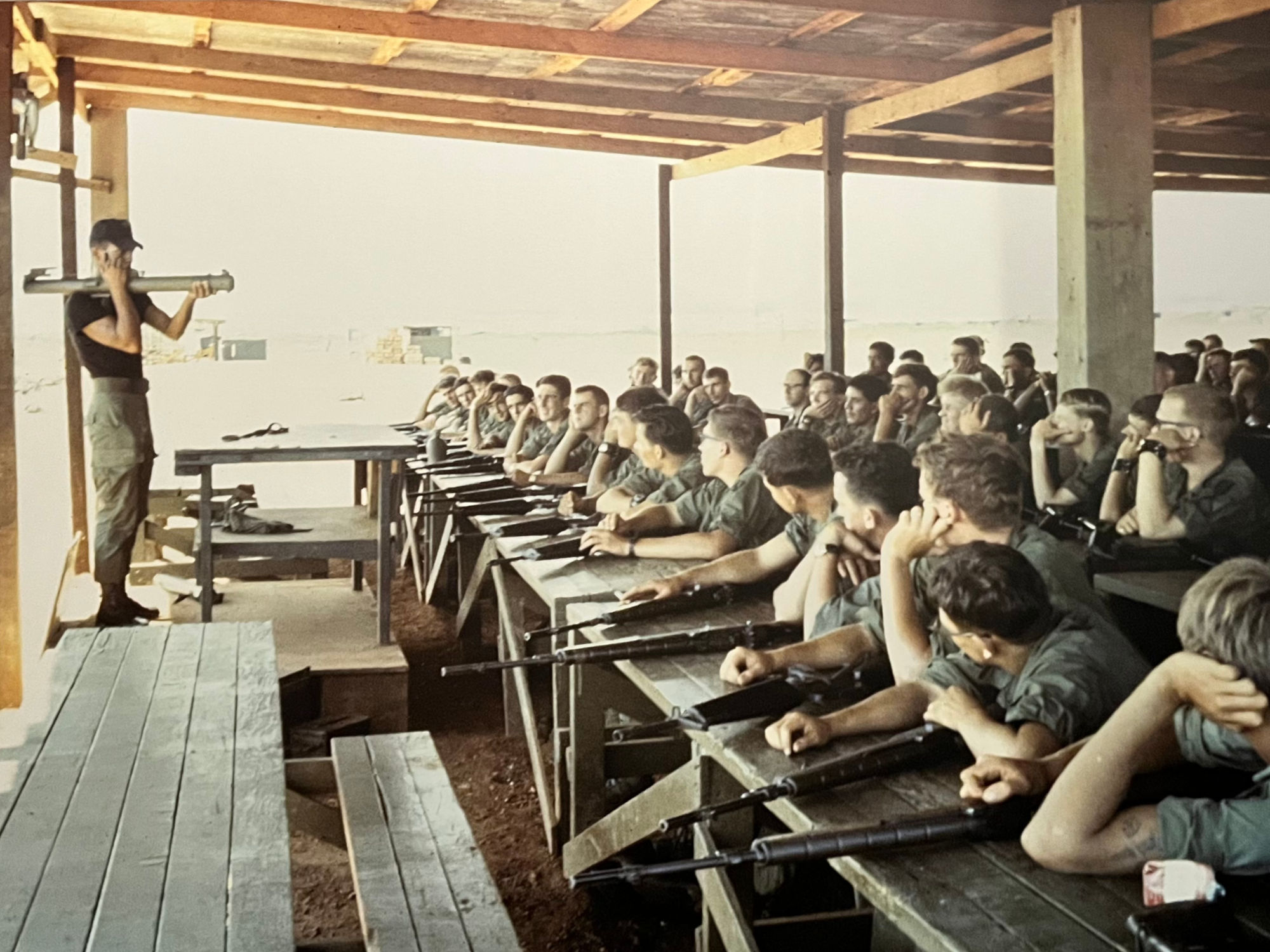
Anti-Tank Weapons Training
American troops receiving training on the use of anti-tank weapons.
The Mighty Mekong River
It flows through six countries. The river has played a major role in the history of Vietnam. Millions of people live in the Lower Mekong River Basin. They depend on the river for their livelihoods.
The Mekong Delta was considered to be "one of the most economically and strategically important areas of Southeast Asia during the Vietnam War." Six million people - 40 percent of South Vietnam's population - lived in the region. The delta frequently floods during monsoon season. This results in changes to the river's direction.
The Viet Cong had as many as 50,000 troops in this strategically important region. As early as 1965, the United States Navy began patrolling the river. They sought to keep the Viet Cong from moving forces and equipment along the river, attacking allied troops, disrupting commerce, and harassing civilians.
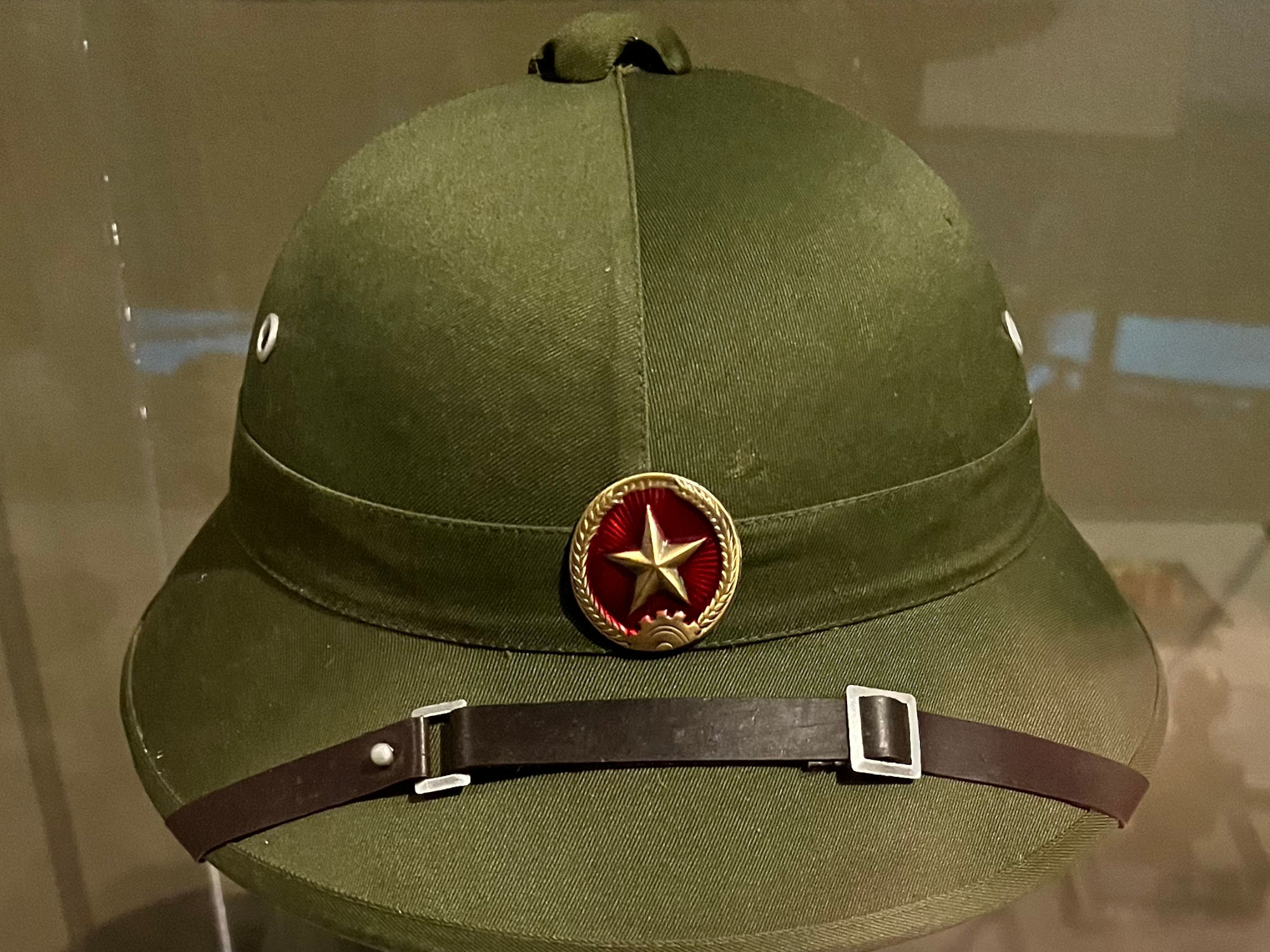
Pith Helmet
Viet Cong
Jungle green pith helmet with adjustable chinstrap and National Liberation Front (NLF) badge.
POW Prison Camps
The cells were small, poorly ventilated, and barely furnished. A single lightbulb burned 24 hours a day. The toilet was a rusty bucket. The bed was a concrete slab. The cells were hot and humid in the summer, and cold in the winter.
The prison was filthy. Huge rats and swarms of biting insects were inescapable, tormenting the men at all hours of the day and night.
The food was inadequate and largely inedible. Meals would include thin soup, stale bread, rice, and mystery meat. Water was barely drinkable. Disease and malnutrition were rampant. If medical care was provided, it was primitive at best.
Similar conditions existed at each of the other 12 POW camps.
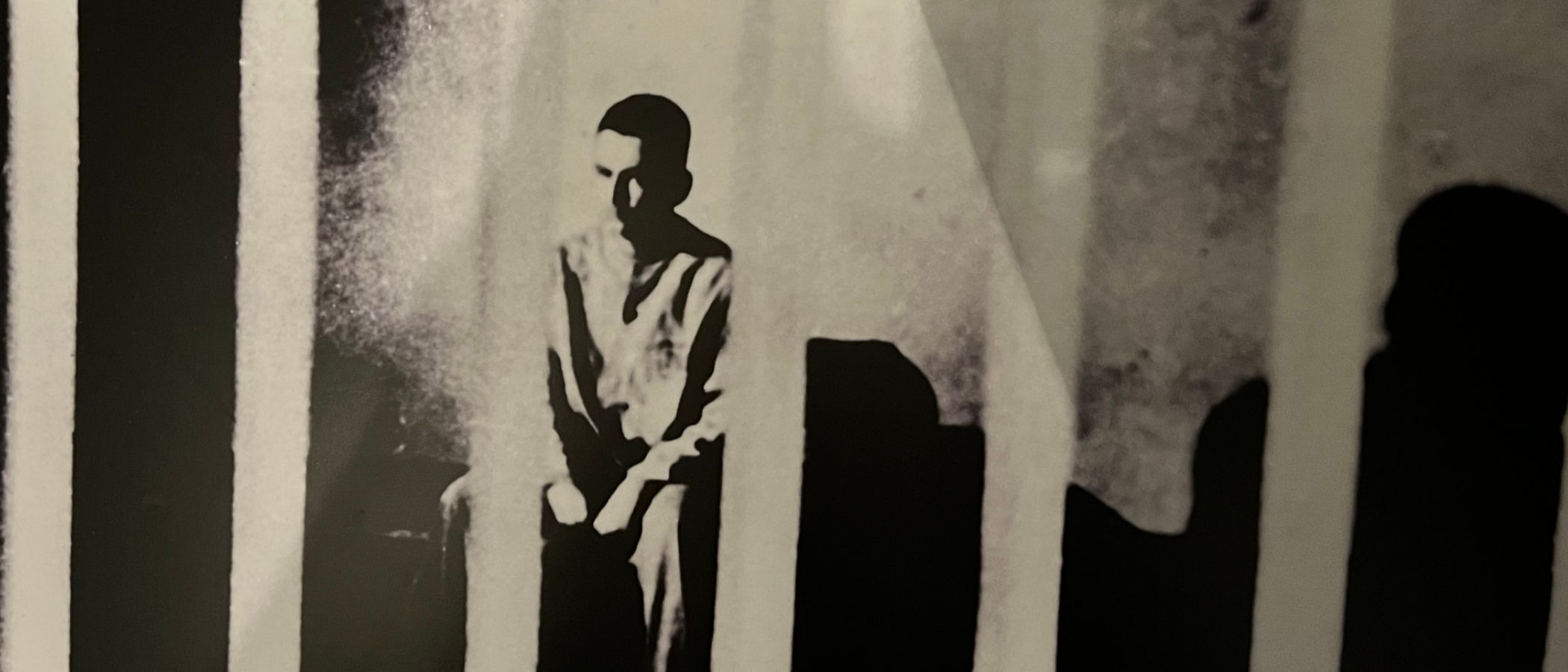
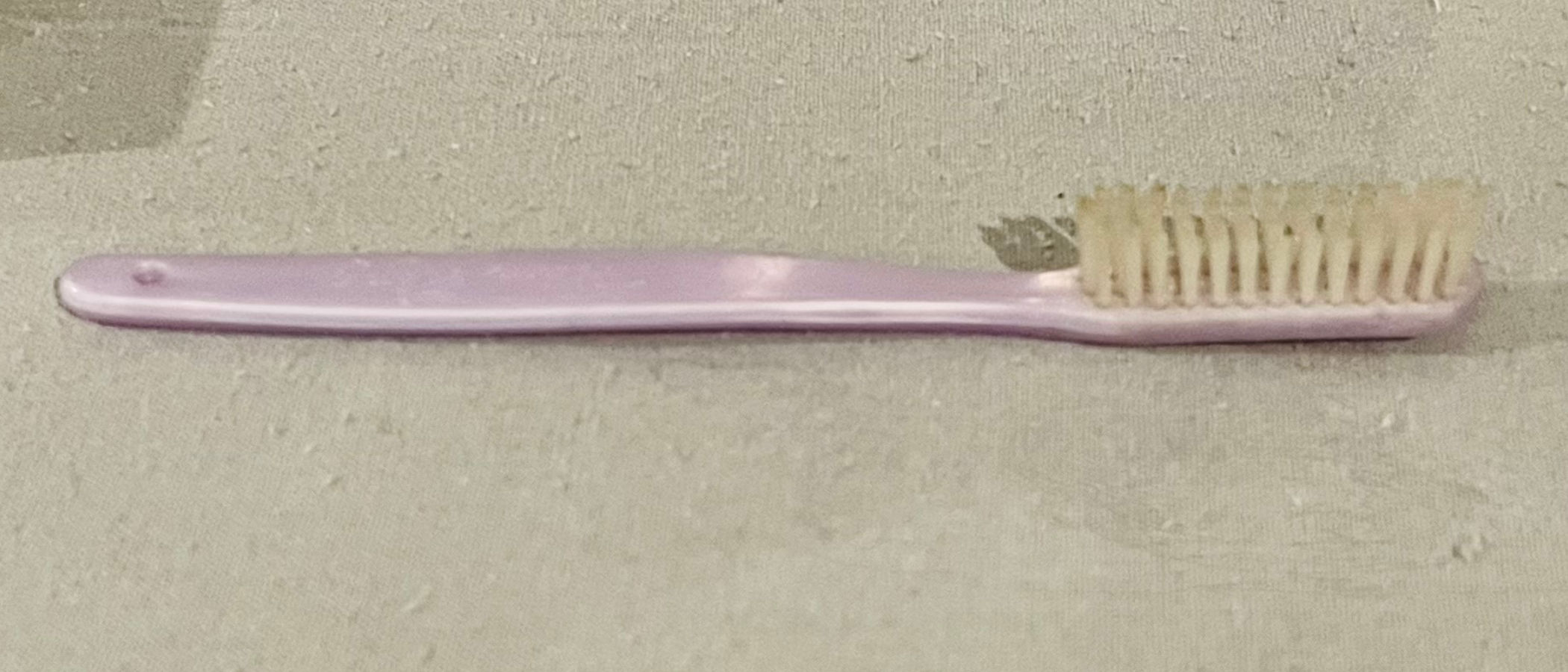
Toothbrush
Hanoi Hilton
Prisoners were issued minimal toiletries like this toothbrush, which broke after a few uses.
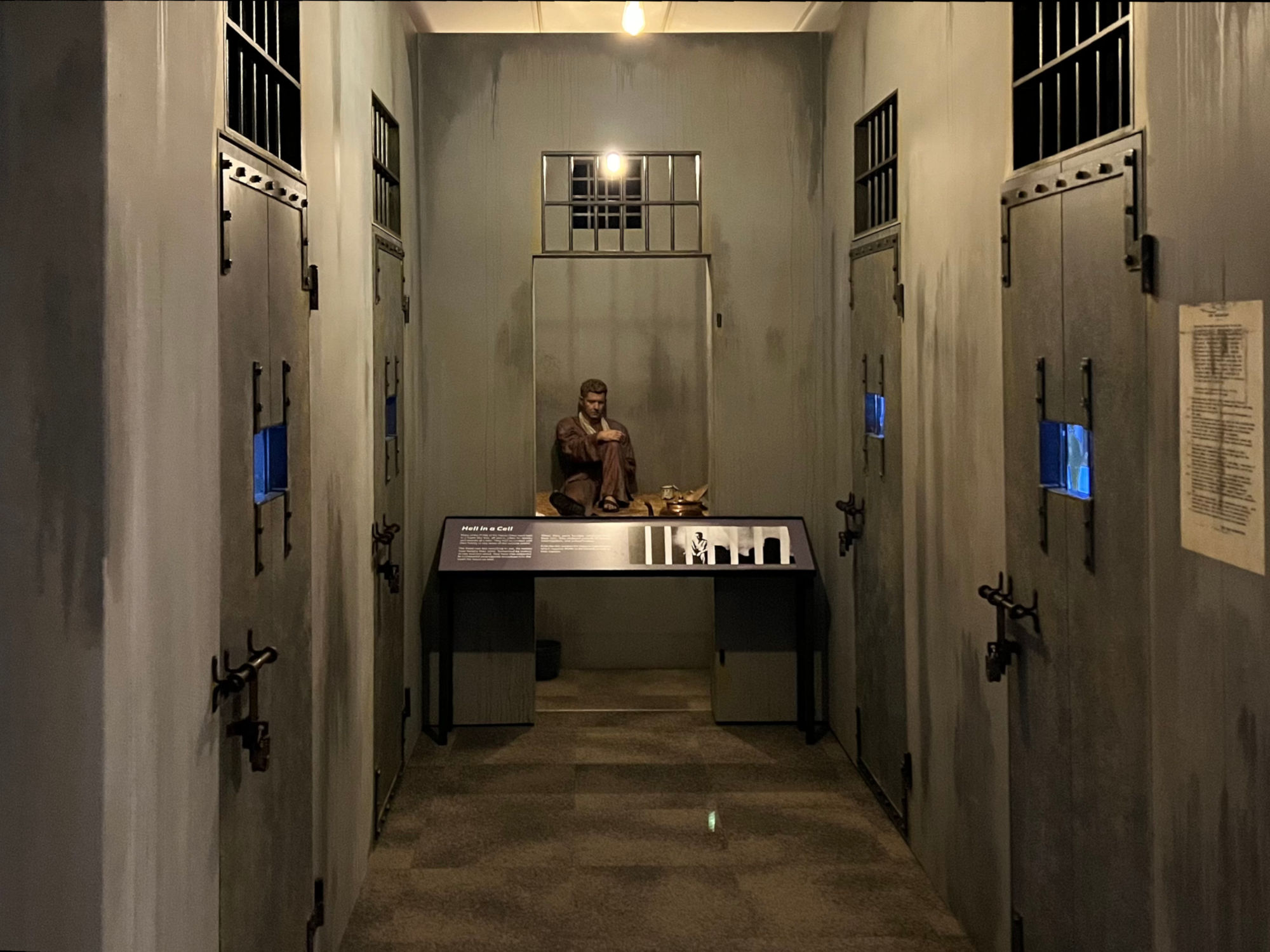
Hell in a Cell
Hanoi Hilton Prop
Many of the POWs at the Hanoi Hilton were held in a room like this, all alone, often for weeks and months at a time. They had no contact with their family or any news of the outside world.
The food was too revolting to eat, no matter how hungry they were. Tormented by insects as rats scurried about, they were also subjected to communist propaganda broadcast into the room for hours on end.
When they were forcibly removed from their cells, they endured periods of torture, interrogation, and indoctrination.
Cells like this violated the Geneva Conventions, which requires POWs to be treated as well as their captors.
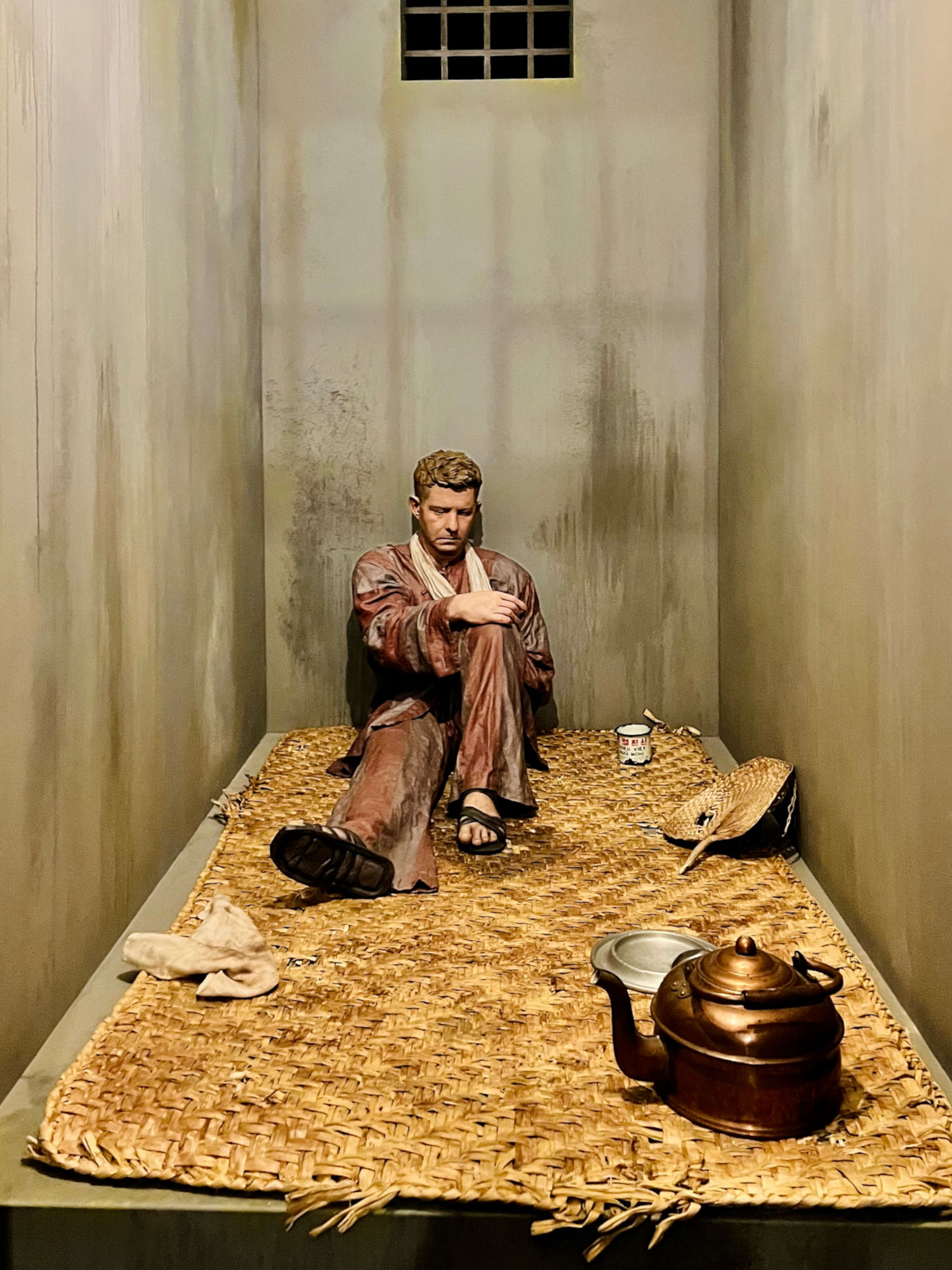
Prison Camp Regulations
American Servicemen participating in the war of aggression by U.S. administration in Vietnam and caught in the act while perpetrating barbarous crimes against the Vietnamese land and people, should have been duly punished according to their criminal acts: but the governemnt and people of Vietnam, endowed with noble and humanitarian traditions, have given those captured American servicemen the opportunity to benefit a lenient and generous policy by affording them a normal life in the detention camps as practial conditions of Viet-Nam permit it and conforming to situation in which the war is still on
Detainees are to observe and carry out the following regulations of the camp:
- Detainees must strictly obey orders and follow instructions given them by Vietnamese officers and army man on duty in the camp.
- Detainees must be polite towards every Vietnamese in the camp.
- Inside the detention rooms, as well as the outside when allowed, detainees must not make noise or create noise. Quarrel and fighting between detainees are forbidden. In time for rest, total silence is imposed.
- Detainees must not bring back to detention rooms any object whatsoever without the camp authorities permit it.
- In case of sickness or sign of sickness in felt, detainees must immediately inform the camp for the medical officer to check and cure.
- Detainees must assure hygiene of the camp, take care of personal items provided by the camp as well as of any other thing for collective use.
- In case of air alarm, detainees must keep order and silence, and follow the camp regulations on security.
- In need of something, detainees should address themselves to Vietnamese armymen standing nearby announcing two words "BAO CAO" (means "report"), and should wait if no English-speaking people was available yet.
- In the detention rooms, every detainees are equal with each other. Anyone does have right to free thinking, feeling, praying etc. and no one is permitted to coerce any other into following his own opinion.
- Violations of the regulations shall be punished.
The Camp Authorities
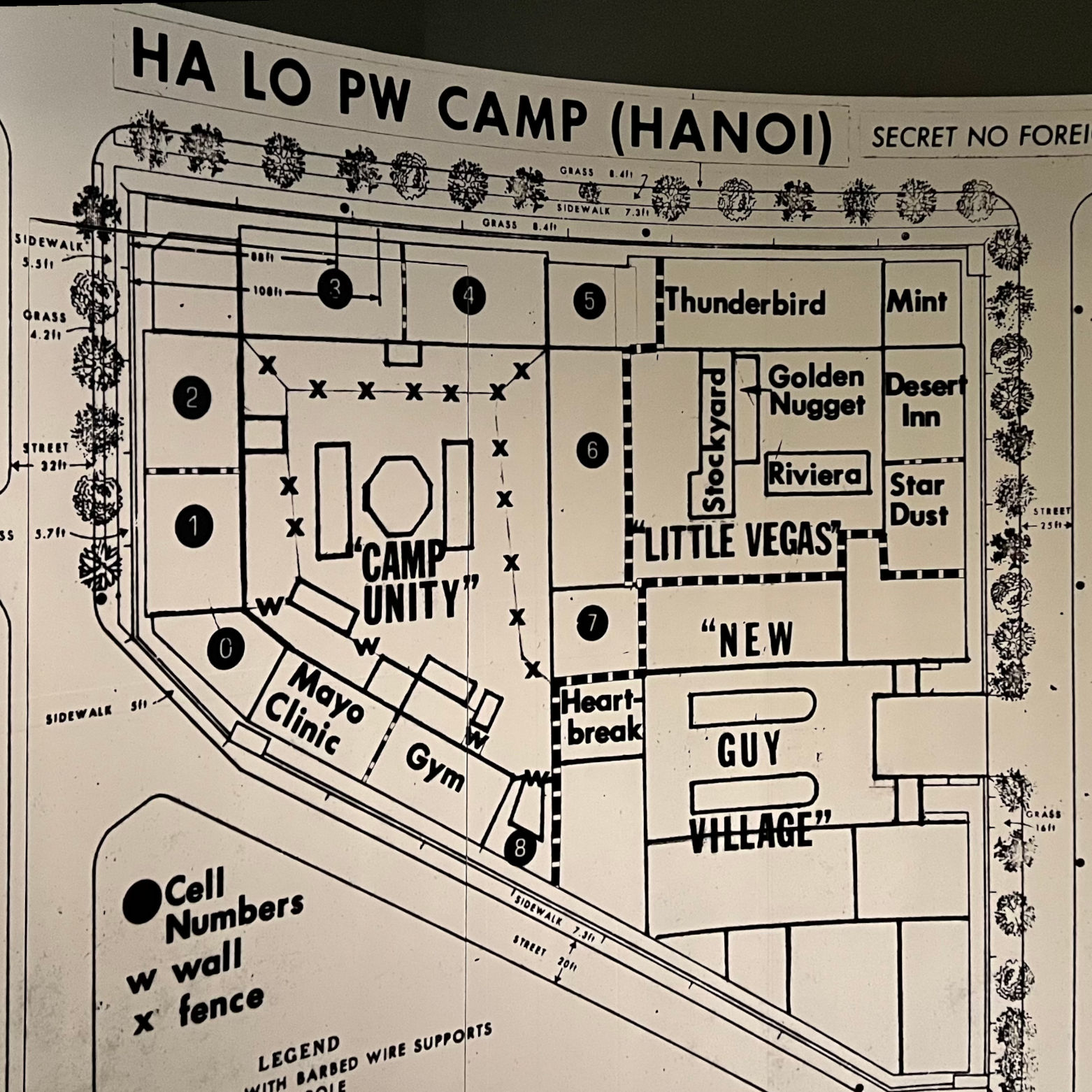
Communicating
The North Vietnamese made every effort to keep the prisoners from communicating with one another. The POWs, however, knew that keeping faith with their fellow captives required communication. They developed creative and effective ways of "talking" with each other.
The Tap Code
Shot down on April 4, 1965, Captain "Smitty" Harris was the sixth American taken prisoner by the North Vietnamese. Before being sent overseas, he had learned a tap code World War II POWs had used to communicate. Letters of the alphabet were represented on a simple 5x5 grid consisting of 25 squares (C and K occupied one square).
Stockdale, the highest-ranking prisoner at the Hanoi Hilton, reflected on the importance of the tap code,
Passing Notes
POWs would use what paper they could find to write notes. Although they didn't have access to pencils or ink, they would use cigarette ashes, soot from a burned match, mud, or even their own blood to write.
Air Force pilot Sam Johnson wrote of his time as a POW,
The Mute Code
POWs also used a version of American Sign Language to share news or other information.
- John M. McGrath
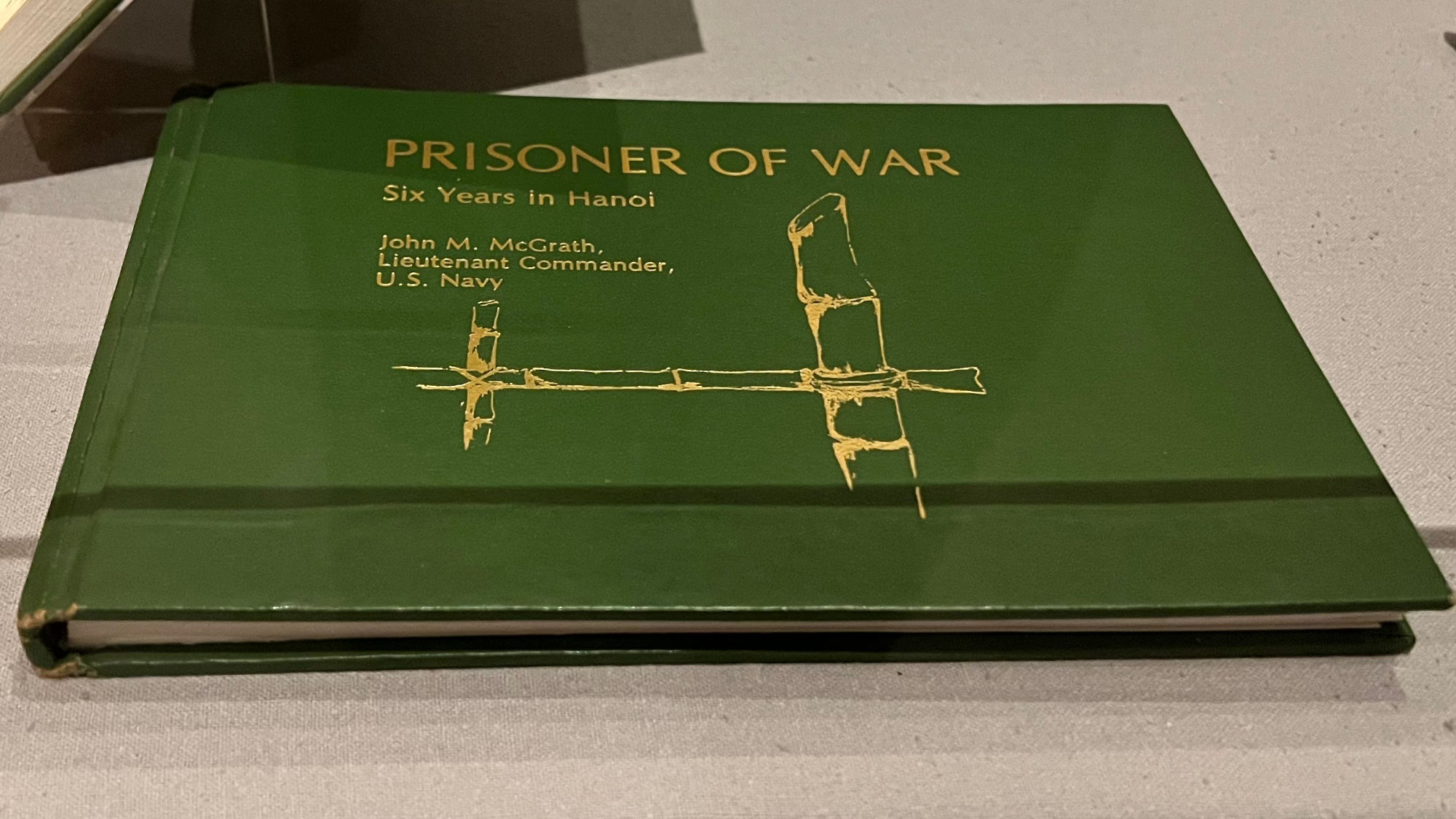
John M. Mcgrath
Prisoner of War: Six Years in Hanoi
Lieutenant Commander John M. McGrath was imprisoned for 2,075 days and subjected to squalid living conditions and torturous beatings by prison guards. After his release, he wrote an autobiographical account of his time as a POW at the Hanoi Hilton. The book contains an inscription by the author that reads
- AMAZON: Prisoner of War: Six Years in Hanoi. By John M. McGrath
[https://www.amazon.com/dp/1591145074]
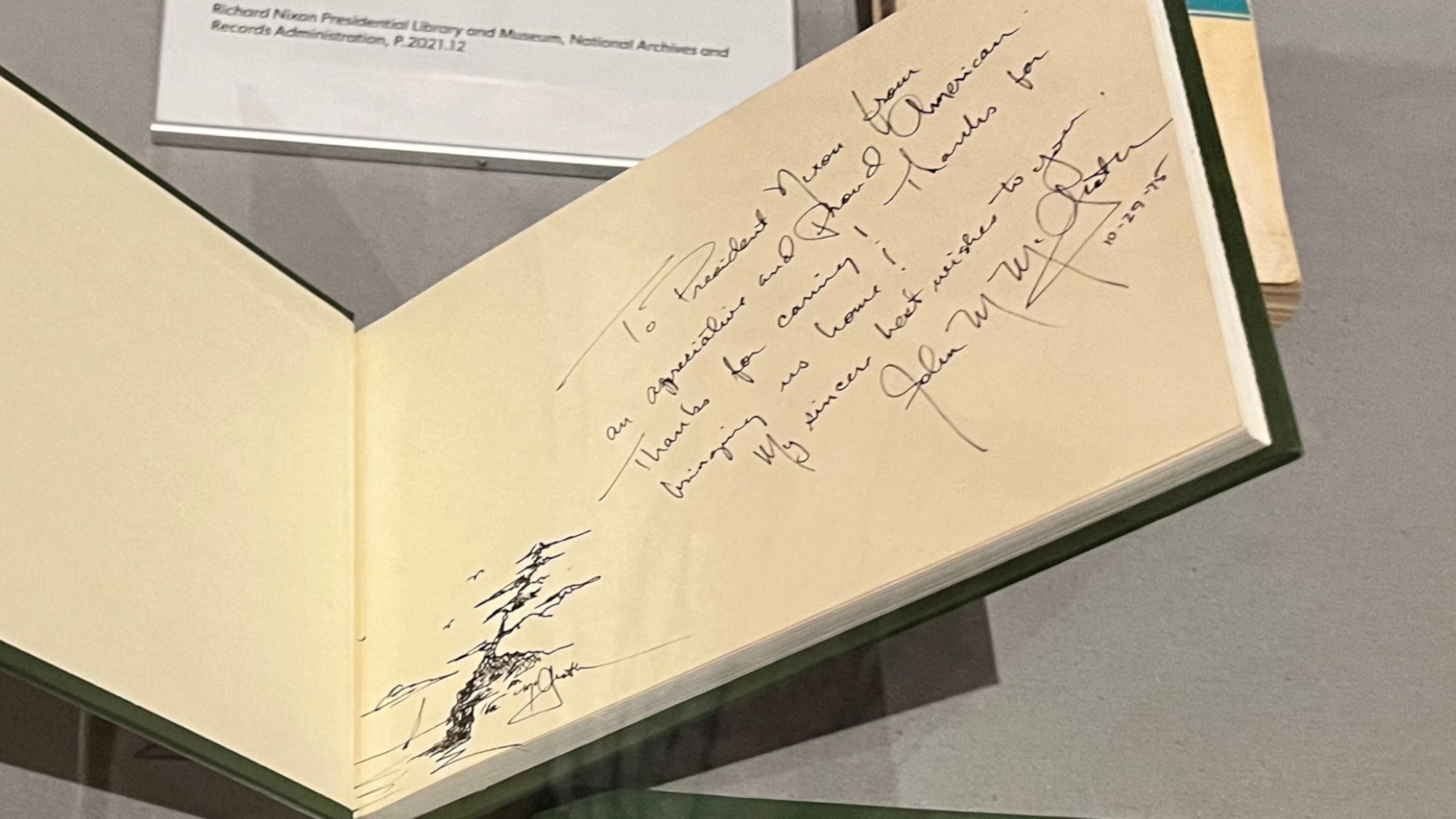
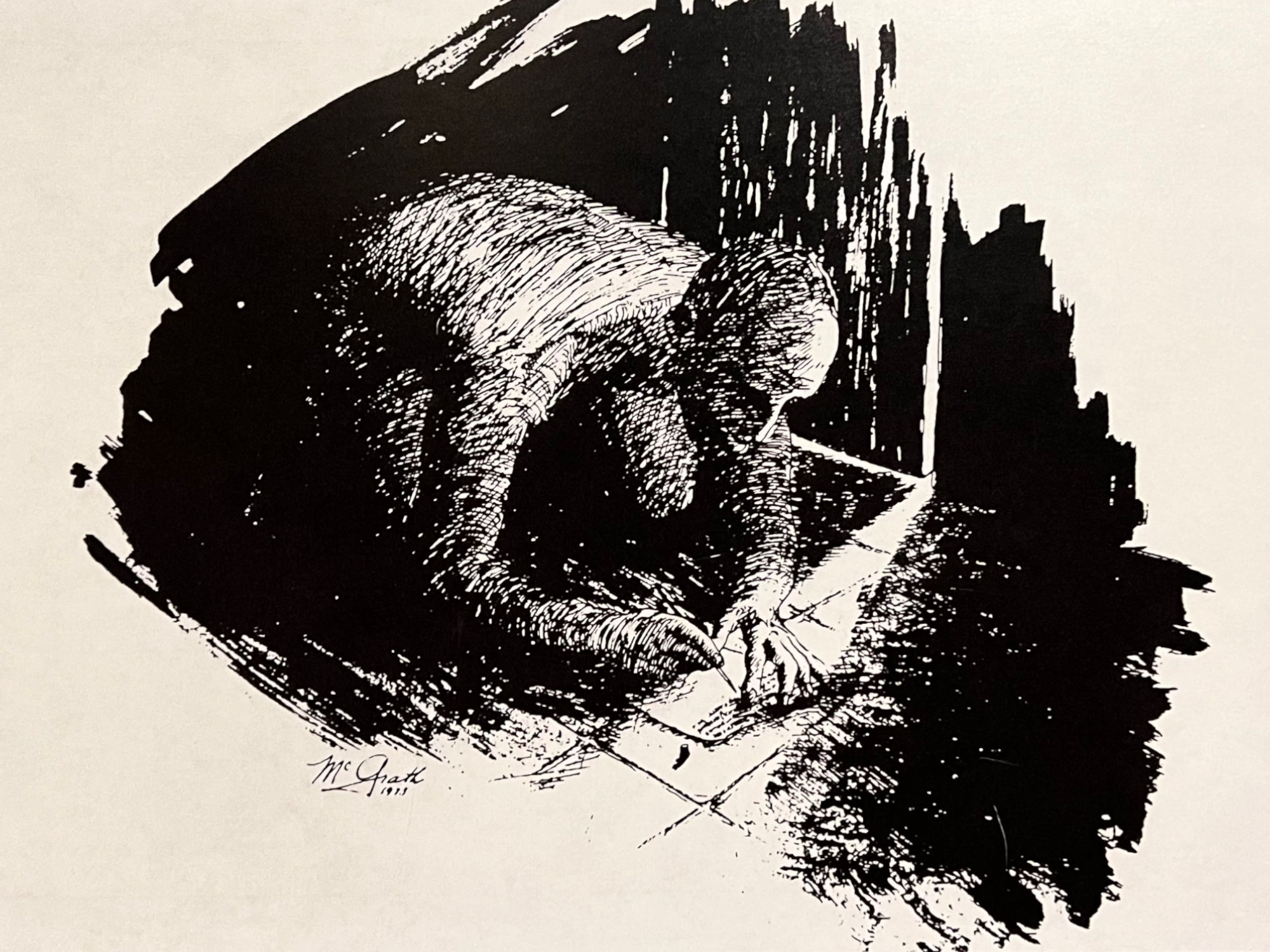
Passing Notes
From Prisoner of War: Six Years in Hanoi. By John M. McGrath
Some solitary confinement cells had no windows, forcing POWs to make the most of whatever indirect light reached their cell for written communication.
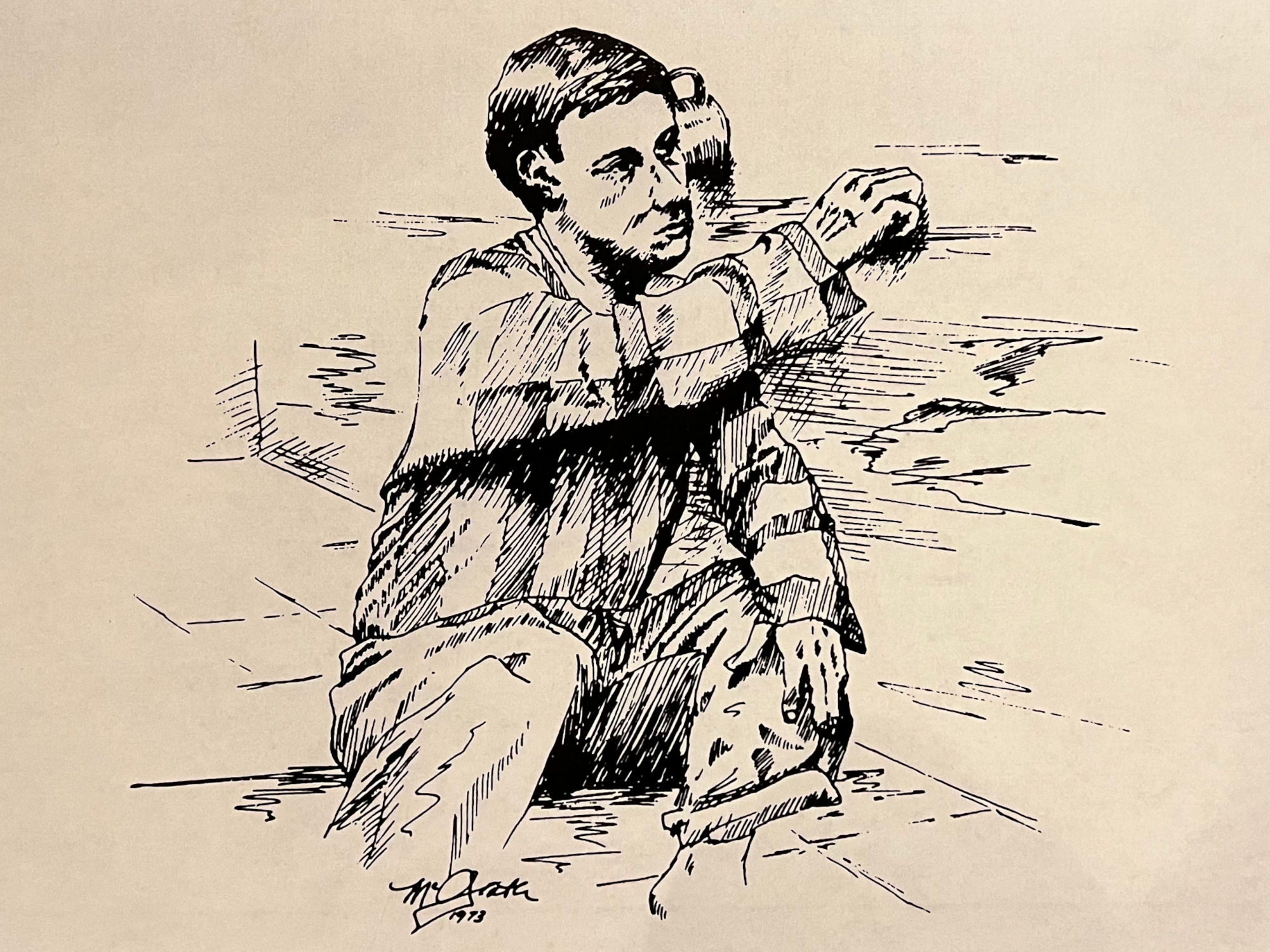
POW Tap Code
From Prisoner of War: Six Years in Hanoi. By John M. McGrath
An Illustration of a POW using his only possession, a rusty cup, to listen as he taps to other POWs.
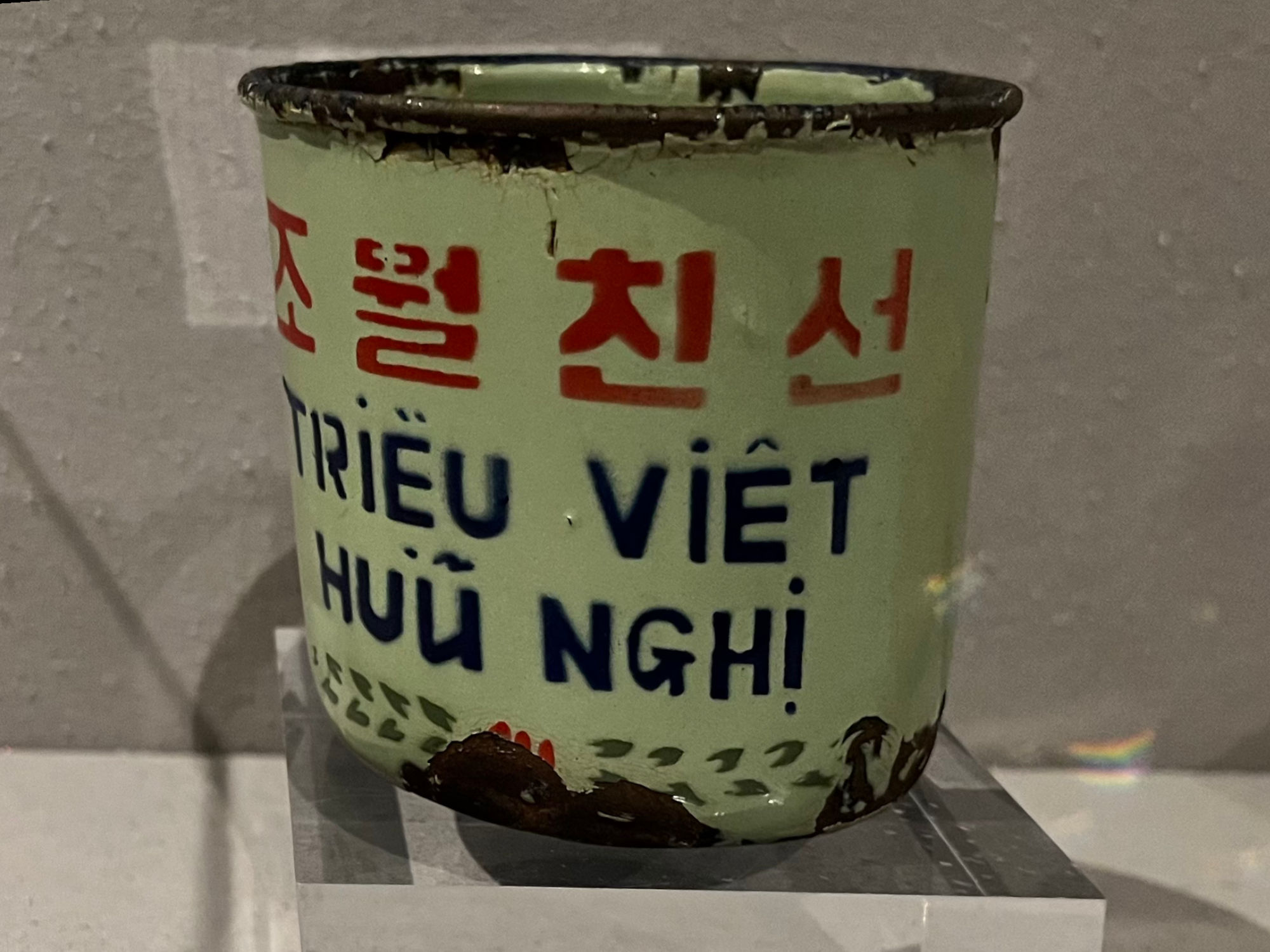
Tin Cup
Tap Code
This green enameled cup was issued to POWs during their internment; it was reportedly the only utensil prisoners were allowed to take with them when they were sent back to the United States.
- Text Reads: Vietnam and North Korea Together
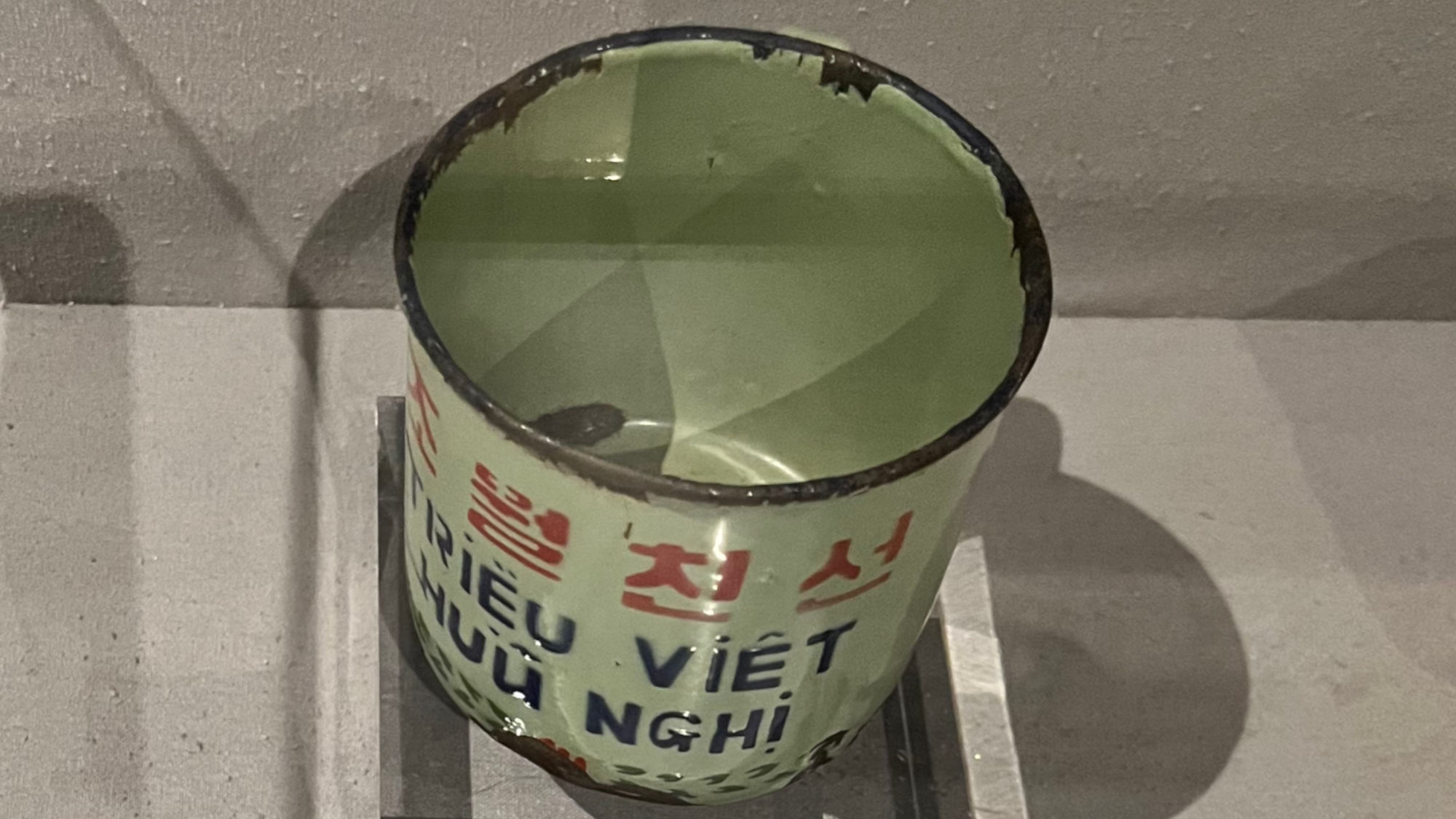
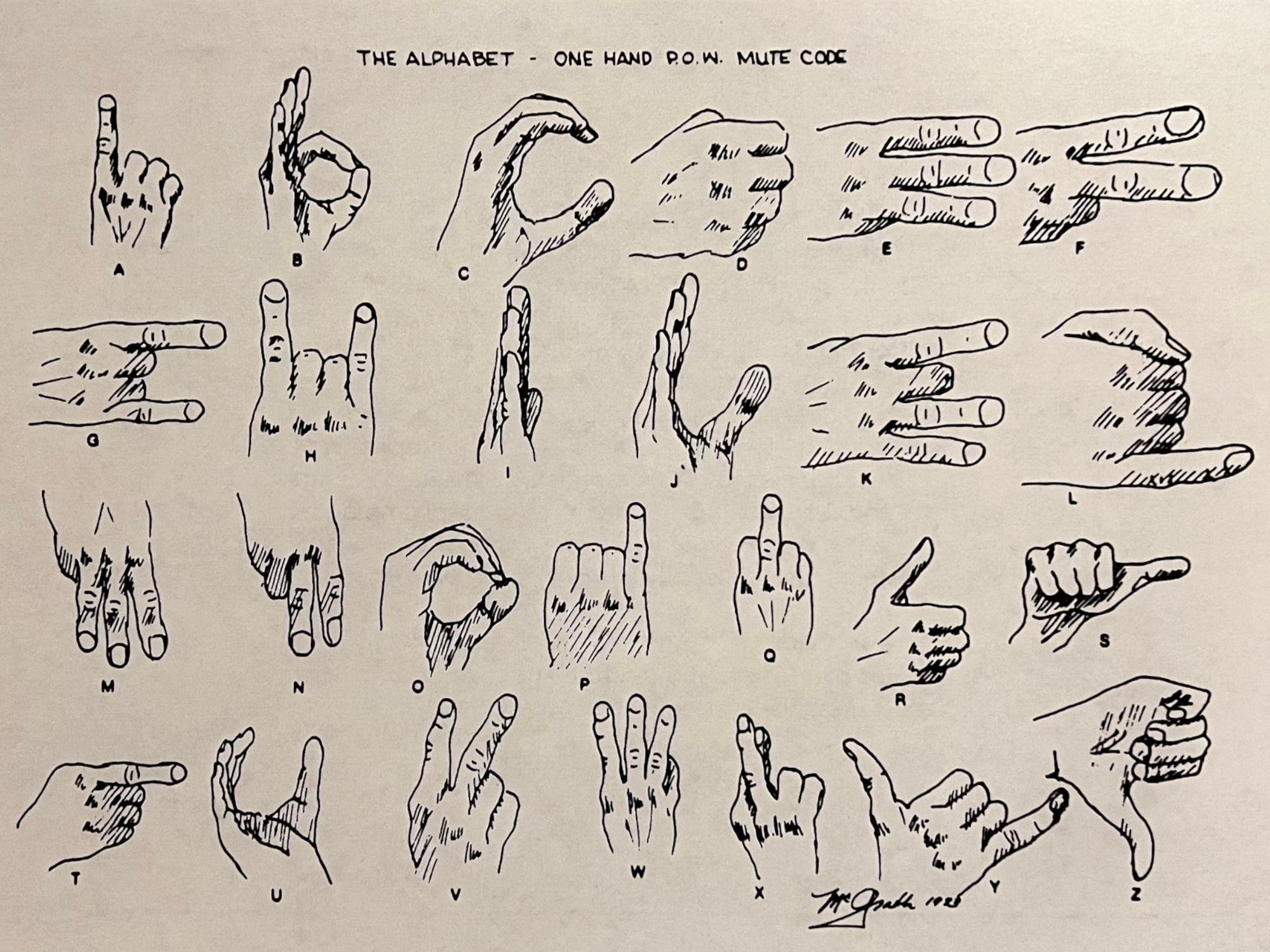
POW Mute Code
From Prisoner of War: Six Years in Hanoi. By John M. McGrath
A simplified version of sign language was used by POWs to communicate when tap code wasn't possible but a fellow POW was in sight, such as during their time outdoors.
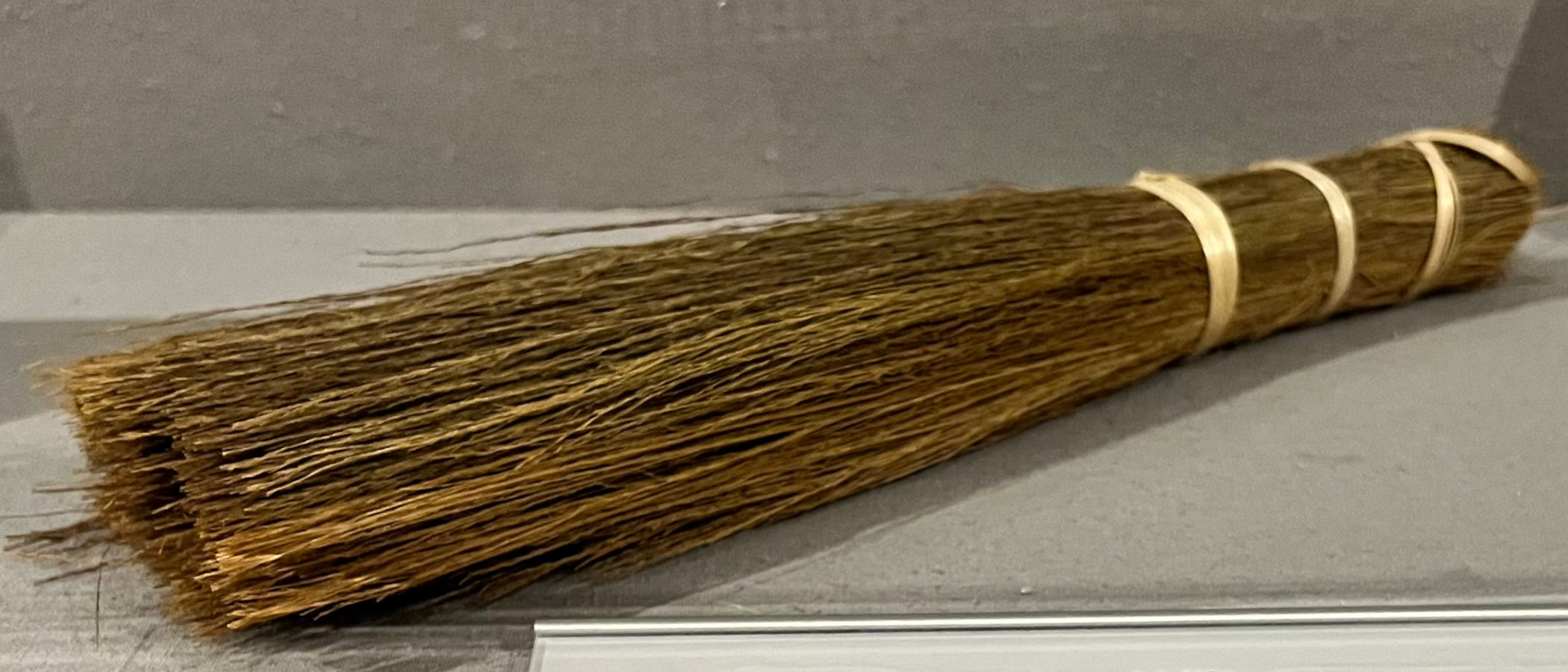
Tap Code Broom
Hanoi Hilton
A handheld broom made by a U.S. prisoner of war at the Hanoi Hilton for transmitting discreet messages throughout the prison camp. The sweeping of the broom transmitted the POWs' tap code.
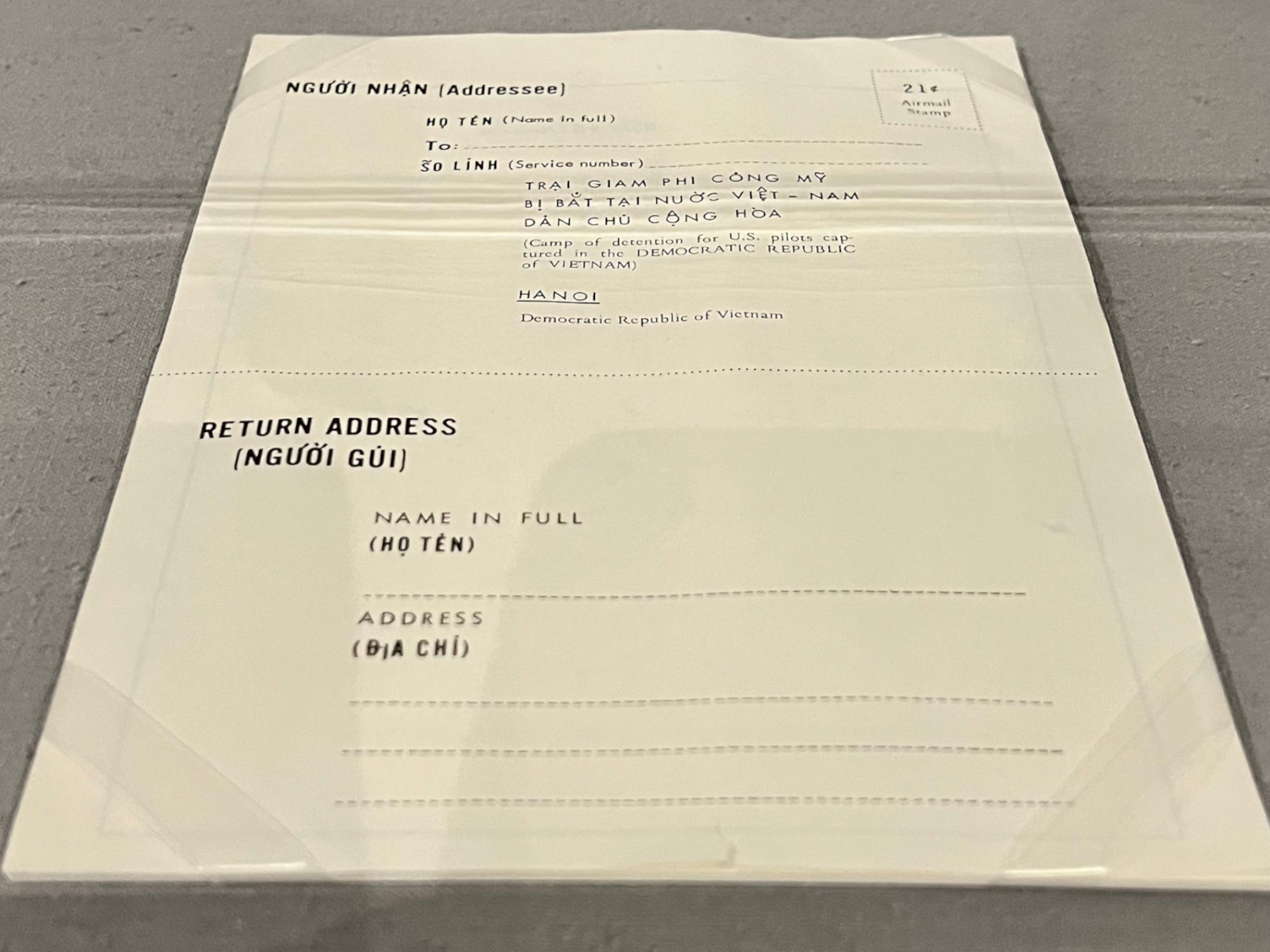
Raymond Merrit
Captured September 16 1965
- His F-105 Plane Shot Down he Ejected over North Vietnam
- POW 2,707 Days
- Released February 12, 1973
Prisoners of war typically received mail via humanitarian organizations like the International Red Cross. The Vietnam War, however, was an exception. North Vietnamese forces intentionally limited the distribution of mail among POWs as a way to break their spirit. This stationery was provided to POW families to write to their relatives.
WIKIPEDIAJames Bond Stockdale
United States Navy vice admiral and aviator who was awarded the Medal of Honor in the Vietnam War, during which he was a prisoner of war for over seven years.Stockdale was the most senior naval officer held captive in Hanoi, North Vietnam. He led aerial attacks from the carrier USS Ticonderoga (CVA-14) during the 1964 Gulf of Tonkin incident. On his next deployment, while commander of Carrier Air Wing Sixteen aboard the carrier USS Oriskany (CV-34), his A-4 Skyhawk jet was shot down in North Vietnam on September 9, 1965.
Gulf of Tonkin Incident
- On August 2, 1964, while on a DESOTO patrol in the Tonkin Gulf, the destroyer USS Maddox (DD-731) engaged three North Vietnamese Navy P-4 torpedo boats from the 135th Torpedo Squadron. As the torpedo boats turned for their North Vietnamese coastline, four F-8 Crusader fighter aircraft from USS Ticonderoga (CV-14) arrived, and immediately attacked the retreating torpedo boats. Stockdale (commander VF-51 (Fighter Squadron 51)) attacked torpedo boats T-333 and T-336.
- Two nights later, on August 4, 1964, Stockdale was overhead during the second reported attack in the Tonkin Gulf.
Prisoner of War
On September 9, 1965, while flying as the Carrier Air Wing Sixteen Commander from USS Oriskany on a mission over North Vietnam, Stockdale ejected from his Douglas A-4 Skyhawk, which had been struck by enemy fire and completely disabled. He parachuted into a small village, where he was severely beaten and taken prisoner.Stockdale was held as a prisoner of war in the Hoa Lo Prison (the infamous "Hanoi Hilton") for the next 7 1/2 years.
- As the senior naval officer, he was one of the primary organizers of prisoner resistance.
- Tortured routinely and denied medical attention for the severely damaged leg he suffered during capture.
- Stockdale created and enforced a code of conduct for all prisoners, which governed torture, secret communications, and behavior.
- In the summer of 1969, he was locked in leg irons in a bath stall and routinely tortured and beaten. When told by his captors that he was to be paraded in public, Stockdale slit his scalp with a razor to purposely disfigure himself so that his captors could not use him as propaganda. When they covered his head with a hat, he beat himself with a stool until his face was swollen beyond recognition.
- When Stockdale was discovered with information that could implicate his friends' so-called "black activities", he slit his wrists so they could not torture him into confession.
- During the course of his captivity, due to torture, his leg was broken twice.
- Stockdale was one of eleven U.S. military prisoners known as the Alcatraz Gang. Because they had been resistance leaders they were separated from other captives and placed in solitary confinement in "Alcatraz", a special facility in a courtyard behind the North Vietnamese Ministry of National Defense, located about one mile away from Hoa Lo Prison. In Alcatraz, each of the prisoners was kept in an individual windowless and concrete cell measuring 3 by 9 feet (0.9 by 2.7 m) with a light bulb kept on around the clock, and locked in leg irons each night.
One of the most highly decorated officers in the history of the Navy with twenty six personal combat decorations.
- Two Distinguished Flying Crosses
- Three Distinguished Service Medals
- Two Purple Hearts
- Four Silver Star Medals
- Three Bronze Star Medals
- The Medal of Honor
Stockdale's Wife Sybil
Early in Stockdale's captivity, his wife, Sybil Stockdale, organized The League of American Families of POWs and MIAs, with other wives of servicemen who were in similar circumstances. By 1968, she and her organization, which called for the president and the U.S. Congress to publicly acknowledge the mistreatment of the POWs (something that had never been done despite evidence of gross mistreatment), gained the attention of the American press. Sybil Stockdale personally made these demands known at the Paris Peace Talks.
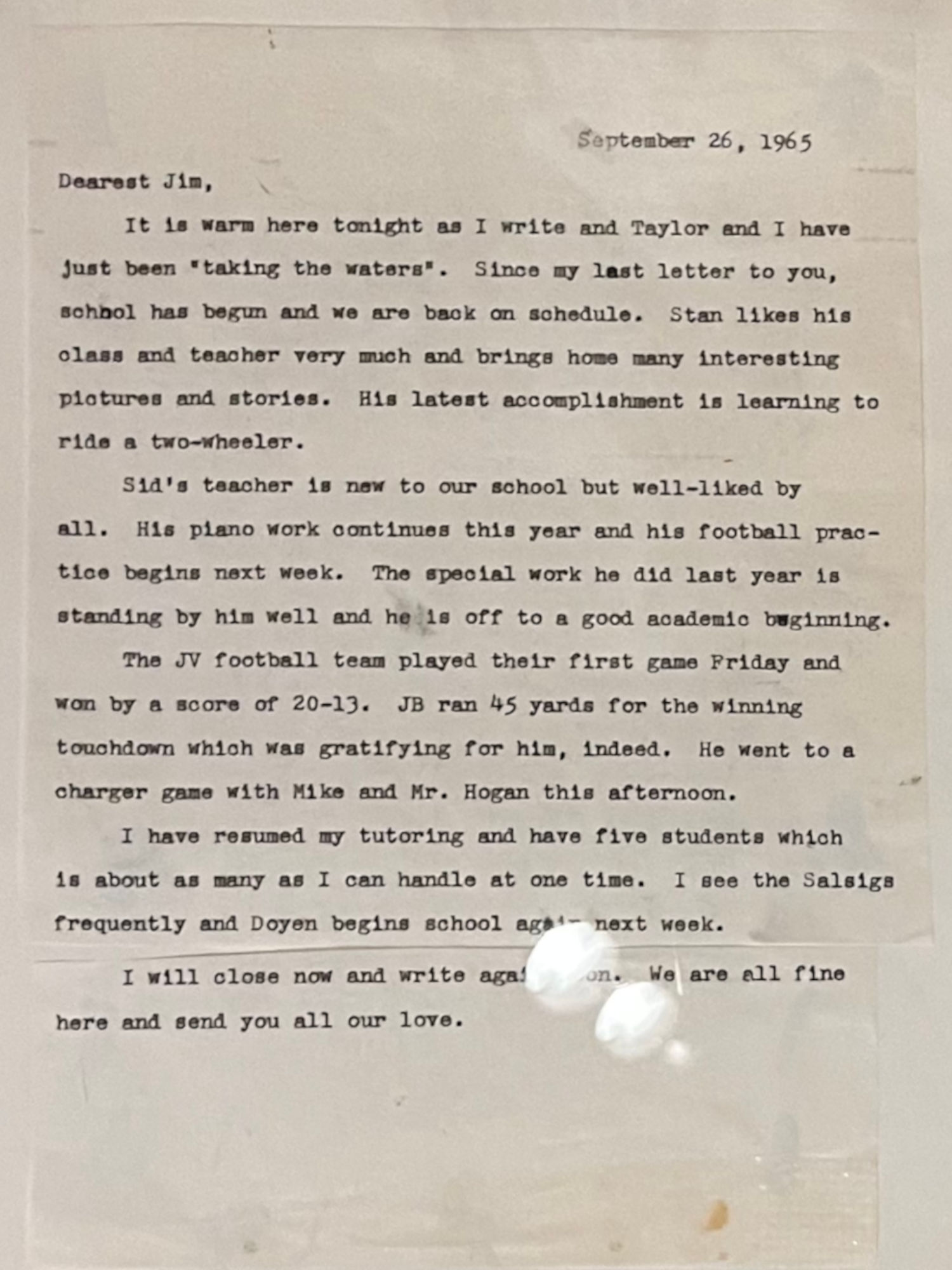
Letter From Sybil to Jim
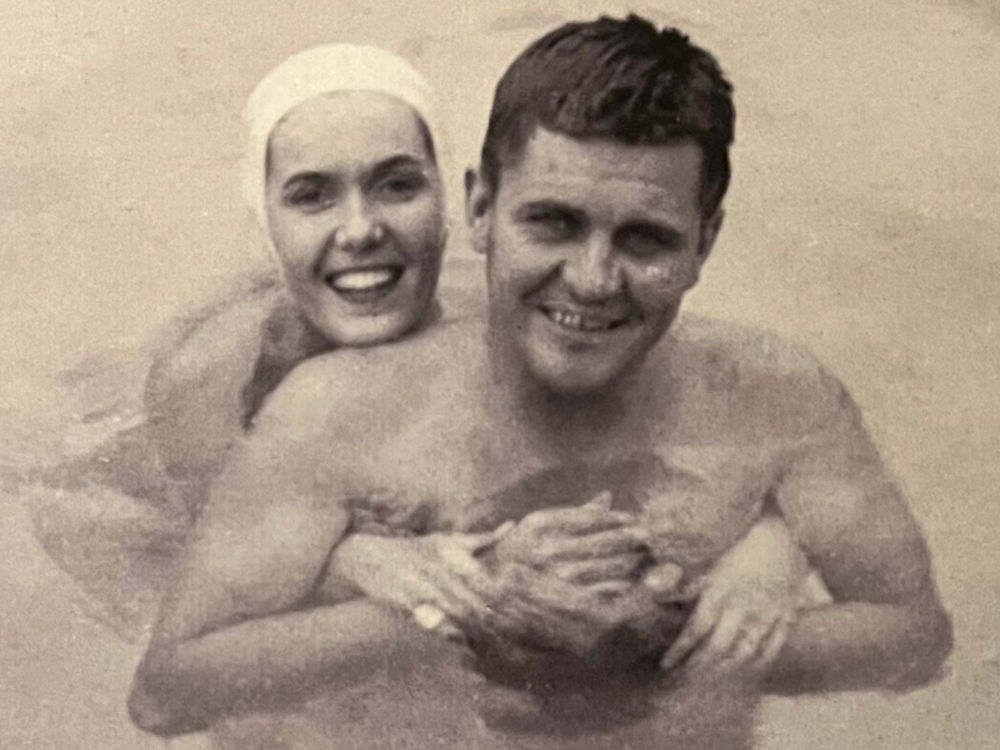
Memories
James Stockdale and his wife Sybil
Memories of loved ones helped POWs endure captivity. During her husband's incarceration, Sybil Stockdale organized The League of American Families of POWs and MIAs.
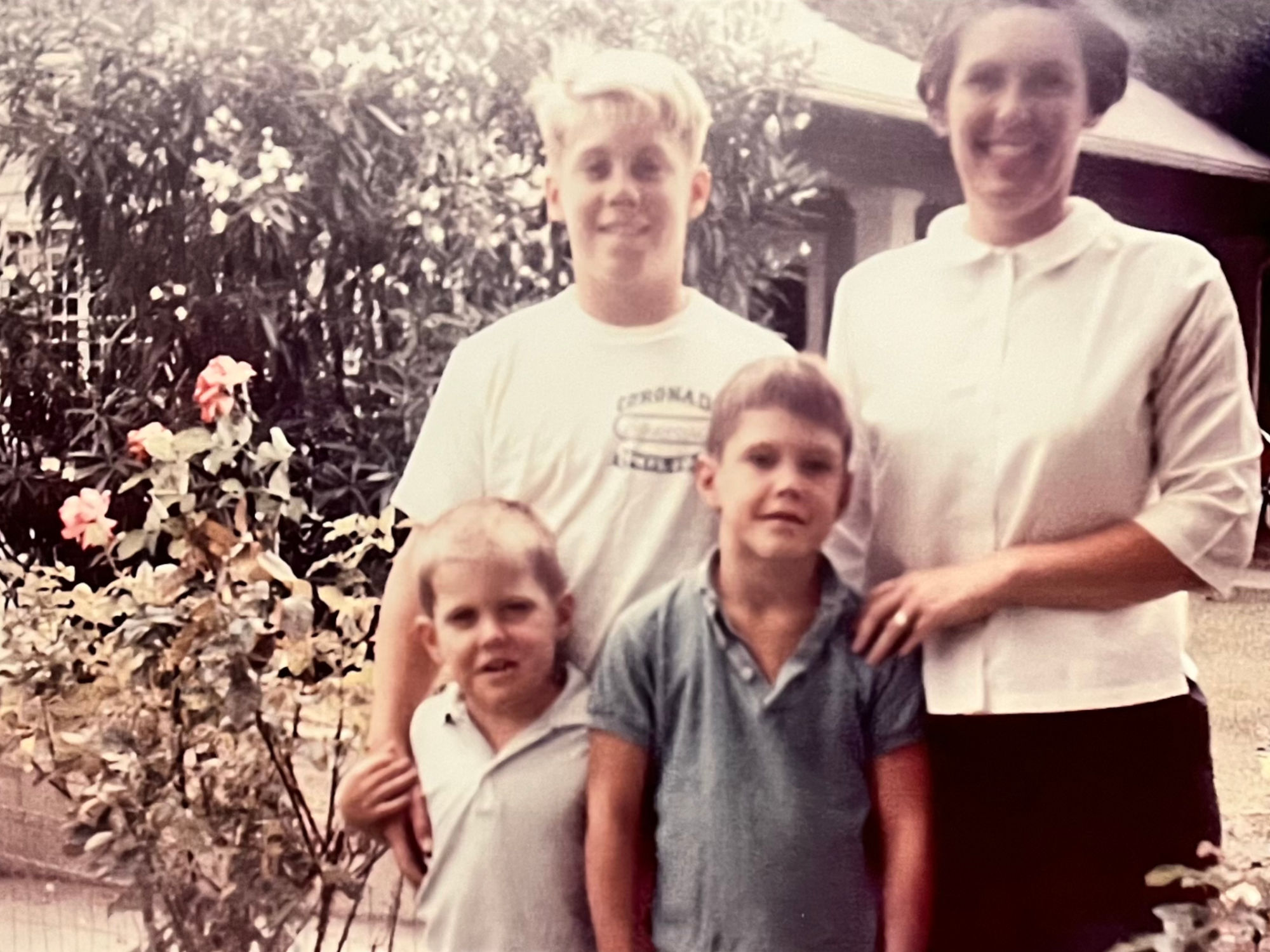
Stockdale Family
A portrait of the Stockdale family
Still in captivity, James Stockdale is missing from the photograph.
Torture of the Mind
Physical torture was not the only weapon the North Vietnamese used to break the will and the spirit of their prisoners. They also made extensive use of psychological torture in violation of the Geneva Conventions.
- POWs were denied the ability to correspond with their loved ones at home.
- They were kept in solitary confinement, often for many months.
- The programs of the Vietnamese propagandist, "Hanoi Hannah," which often included anti-war songs recorded by American musicians, were piped into the prisons.
Speeches by some American political activists were used by the North Vietnamese in an effort to undermine morale. After their release, two POWs would tell President Nixon that they had heard" ...tapes of messages from Ramsey Clark, Jane Fonda, and other peacenik groups, but they had nothing but contempt for them."
Yet, the POWs developed ways to counteract the mental torture inflicted on them. They found ways to communicate with each other. They developed a method of playing chess with the person in the cell next to them. They taught one another math, history, Bible verses, and poetry.
When their captors uncovered these forbidden activities, punishment followed. But when the beatings were done, the POWs didn't give up. They went right back to doing the activities for which they had been punished.
In the words of the poem Invictus, the POWs were "bloodied but unbowed."
"Your Move"
Chess in the POW Camps
POWs found that keeping their minds occupied during the long hours they were left alone in their cells helped to keep them sane. Everett Alvarez Jr. would relieve the tedium by solving complex math problems. He also played chess against himself on a chess board made from a piece of cardboard and scraps of paper cut into different shapes to serve as the pieces. He eventually found someone to play against.
Other POWs also found playing chess to be important to their mental health while in captivity. They used what materials were available to craft chess sets including dried bread, rough toilet paper, cloth, used leather, and rubber from a bicycle tire.
Alvarez would recall:
Invictus
By William Ernest Henley
1875
Out of the night that covers me,
Black as the pit from pole to pole,
I thank whatever gods may be
For my unconquerable soul.
In the fell clutch of circumstance
I have not winced nor cried aloud.
Under the bludgeonings of chance
My head is bloody, but unbowed.
Beyond this place of wrath and tears
Looms but the Horror of the shade,
And yet the menace of the years
Finds and shall find me unafraid.
It matters not how strait the gate,
How charged with punishments the scroll,
I am the master of my fate,
I am the captain of my soul.
"War Criminals"
Defying the Geneva Conventions
The International Committee of the Red Cross (ICRC) wrote to the governments of the United States, North Vietnam, South Vietnam, as well as the NLF. The ICRC reminded them of their obligation to follow the Geneva Conventions governing the treatment of prisoners, including the requirement to treat POWs humanely.
North Vietnam and the NLF replied that they were not obligated to follow the Geneva Conventions. North Vietnam said it would
...regard the pilots who have carried out pirate-raids ... as major war criminals.
The NLF stated that it
...was not bound by the international treaties
because it had never subscribed to them. Each falsely claimed that the POWs would be treated well.
Despite their assurances, North Vietnam and the NLF regularly violated nearly every provision of the Geneva Conventions. POWs were tortured, denied proper medical care, provided little food, and exploited for propaganda purposes. They were denied the basic human rights to which they were entitled.
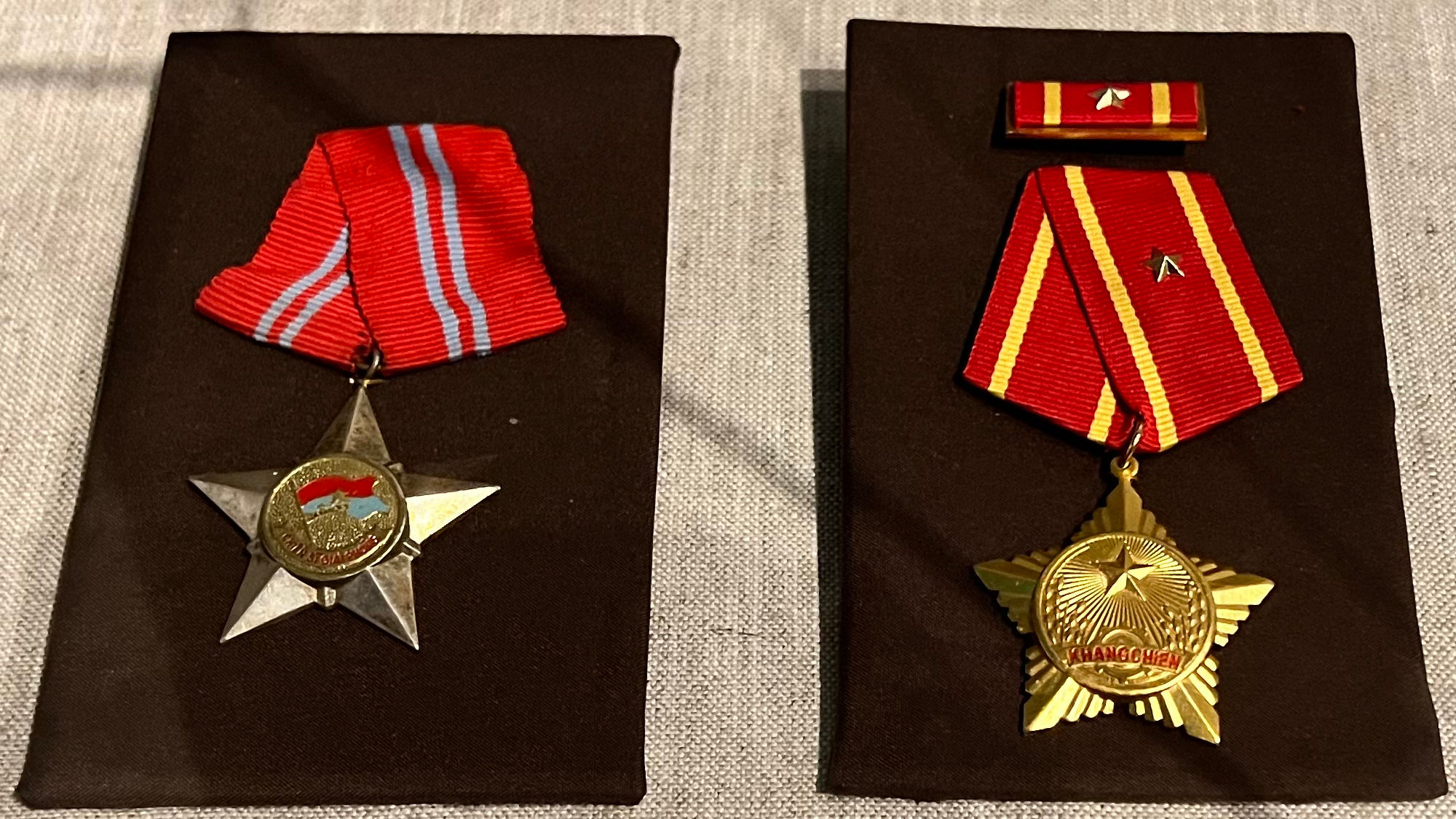
North Vietnamese Medals
Viet Cong
The National Liberation Front (NLF) of South Vietnam
Known colloquially as the Viet Cong, issued medals like this second-class award to those who fought behind enemy lines. The words "Chien Si Giai Phong" translate to "Soldier of Liberation."
Resistance Order of the Democratic Republic of Vietnam
Medals were awarded to fighters with meritorious achievements and services in the Vietnam War. Resistance medals had three classes determined by the number of stars on the medal stub and strip. The single star on this medal indicates a third-class designation.
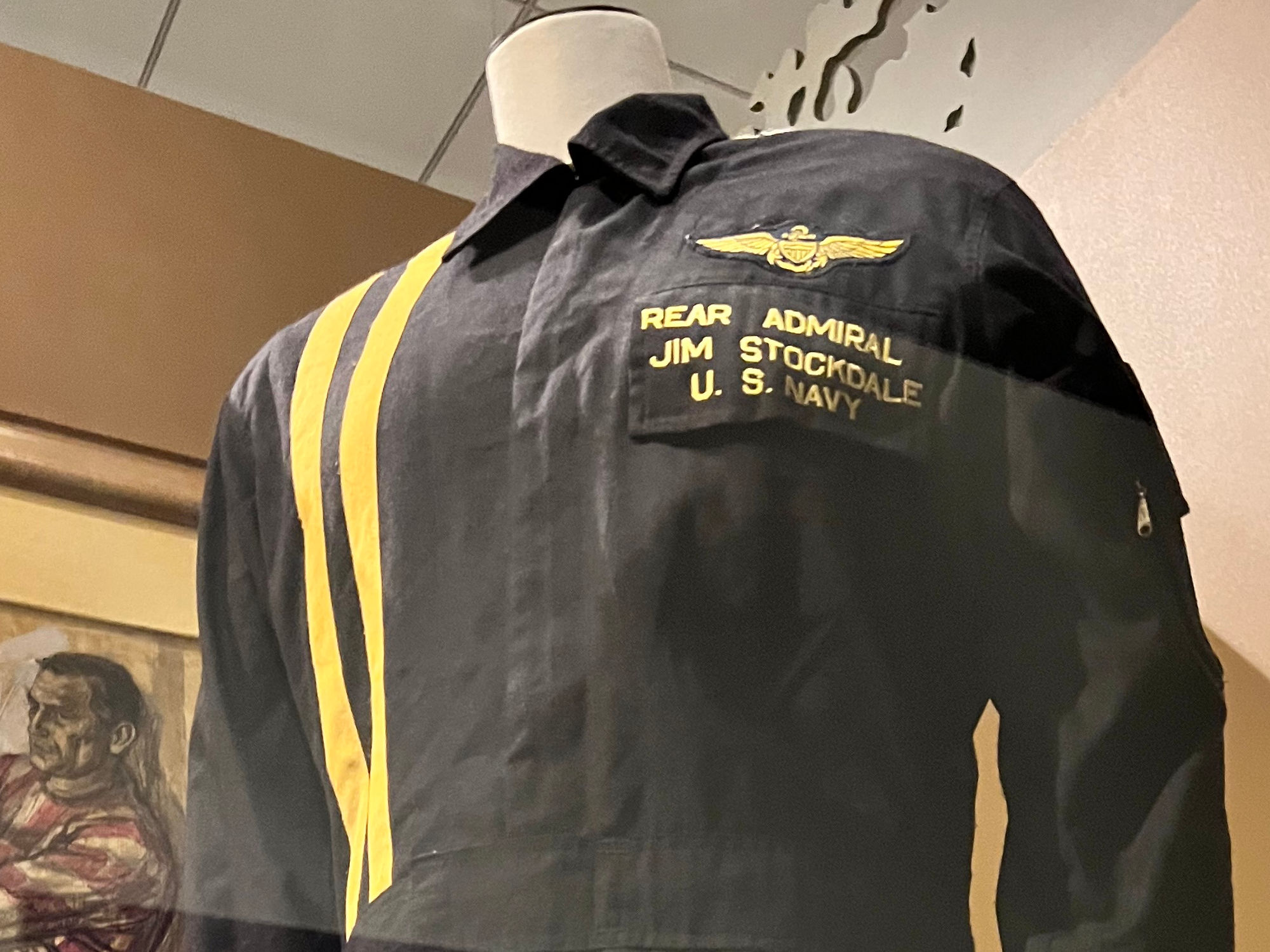
James Stockdale
Hanoi Hilton
On September 9, 1965, Commander James Stockdale was shot down in his A-4 Skyhawk by North Vietnamese anti-aircraft fire. He suffered a broken bone in his back and shattered knee, and he was taken to Hoa Lo Prison as a Prisoner of War. During his nearly eight years of captivity, Commander Stockdale was tortured more than 15 times. While at Hoa Lo, he developed a set of rules that dictated prisoner behavior, and created a secret communication system.
Commander James Stockdale held the distinction of being the most senior naval officer at the Hanoi Hilton. He became known as one of the 11 members of the "Alcatraz Gang," a group of men placed in solitary confinement for being prisoner resistance organizers.
POWs and Propaganda
The North Vietnamese political leadership knew that they would be unable to win a victory on the battlefield over the United States, which possessed military superiority. They did, however, believe they could defeat the United States if they could erode political support for the war through the effective use of propaganda.
Shortly after Navy Commander James Stockdale was shot down in September 1965, a senior North Vietnamese military officer told him
We will win the war on the streets of New York.
Among the propaganda weapons they sought to use were the POWs themselves.
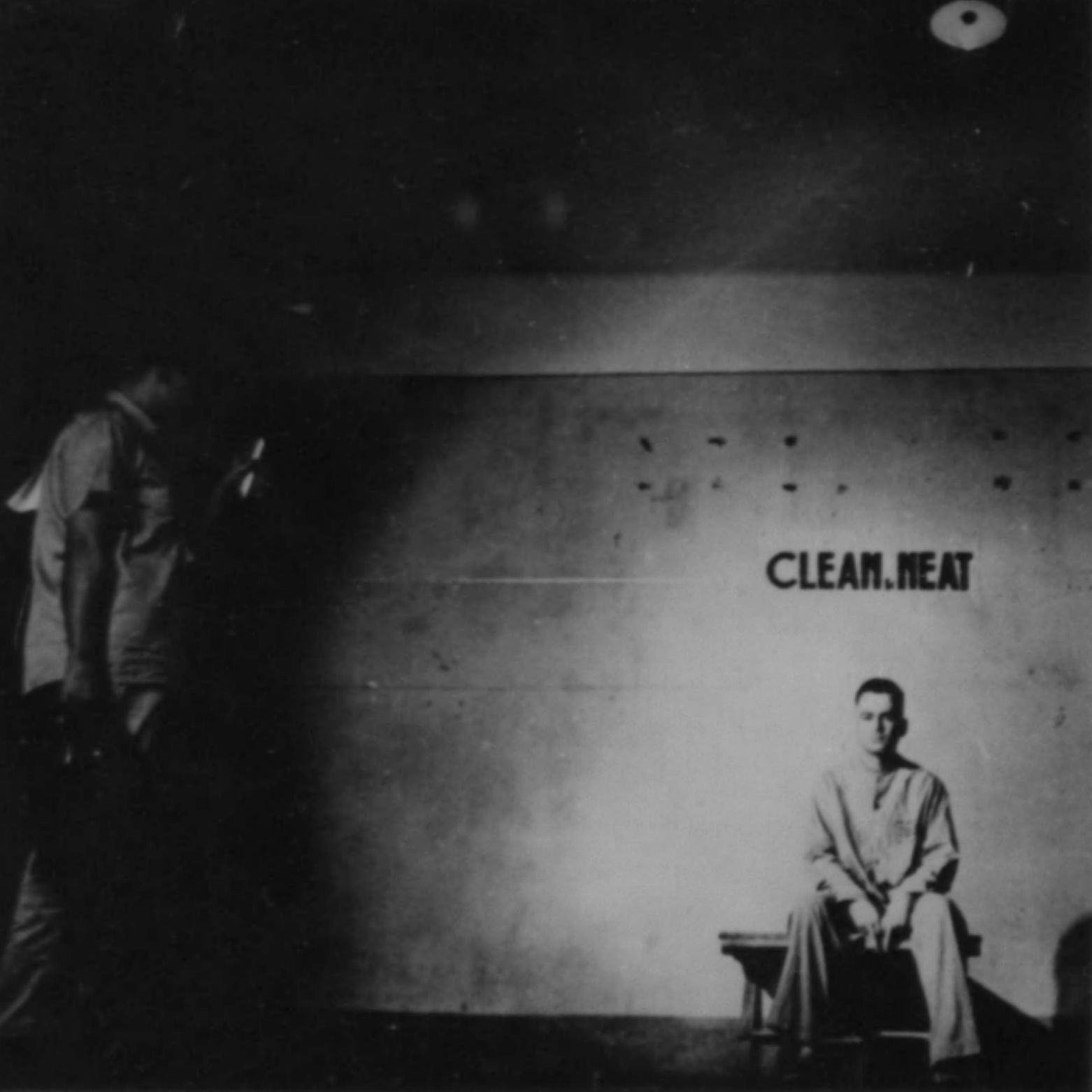 One of the goals of Hanoi's leadership was to convince the American public that the POWs were treated well in captivity. They would stage photographs to make it appear as if prisoners were healthy and well fed. Under threat of torture, they forced POWs to record statements criticizing the United States' involvement in the war. The prisoners found creative ways to frustrate their captors' efforts. In one famous photograph, American POW Paul Galanti was interviewed by East German media. Galanti sat with his hands hanging between his knees with both middle fingers extended towards the camera.
One of the goals of Hanoi's leadership was to convince the American public that the POWs were treated well in captivity. They would stage photographs to make it appear as if prisoners were healthy and well fed. Under threat of torture, they forced POWs to record statements criticizing the United States' involvement in the war. The prisoners found creative ways to frustrate their captors' efforts. In one famous photograph, American POW Paul Galanti was interviewed by East German media. Galanti sat with his hands hanging between his knees with both middle fingers extended towards the camera.
The North Vietnamese didn't know the subliminal message he was sending while being filmed. However, when the photo ran on the cover of LIFE magazine, people in the United States knew exactly what the gesture meant.
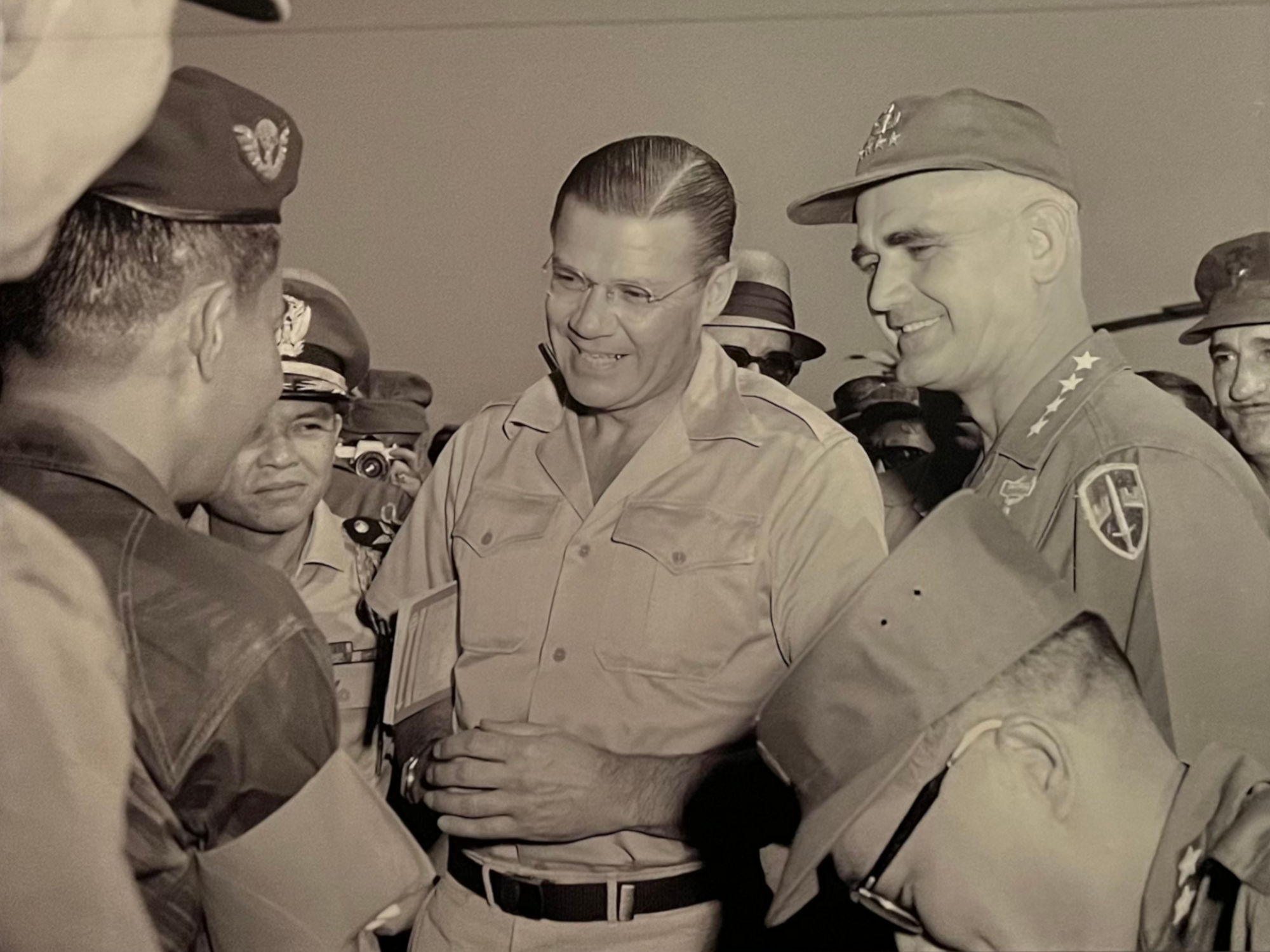
Mcnamara & Westmoreland
In Danang
Secretary of Defense Robert McNamara and General William Westmoreland, Vietnam Assistance Command Commander, meet with Danang Area Corps Commander General Thi on condition of the war in Vietnam.
Arrival at Camp
No Red Carpet Welcome
In October 1965, two days after I was shot down northeast of Hanoi, I arrived at Hoa Lo Prison - the infamous "Hanoi Hilton," so nicknamed by U.S. prisoners of war. I was put in a small, filthy cell, and it was certainly the worst place I had ever been in my life. The smell from the waste bucket was bad enough, but there was another, older smell that was much worse. I smelled the misery soaked into the walls, and I felt it radiate from the narrow concrete bunks.
The cell was in a cellblock that Americans called "Heartbreak Hotel," and I found it totally appropriate. I was there for about two weeks.
Each Heartbreak cell was made up of two concrete slabs with a narrow space between them. Each slab had built-in leg-irons that could be locked and unlocked with a metal tongue that ran through the wall and could be operated from the passageway. There was also a viewing port at the end of the slab that widened pyramid-like through the wall so a guard could view most of the cell from the outside. During those two weeks in Cell No. 2, I spent hours each day in interrogations, usually followed by additional time in the leg-irons as punishment for my "bad attitude."
RELATED: [https://www.amazon.com/dp/1682478254]
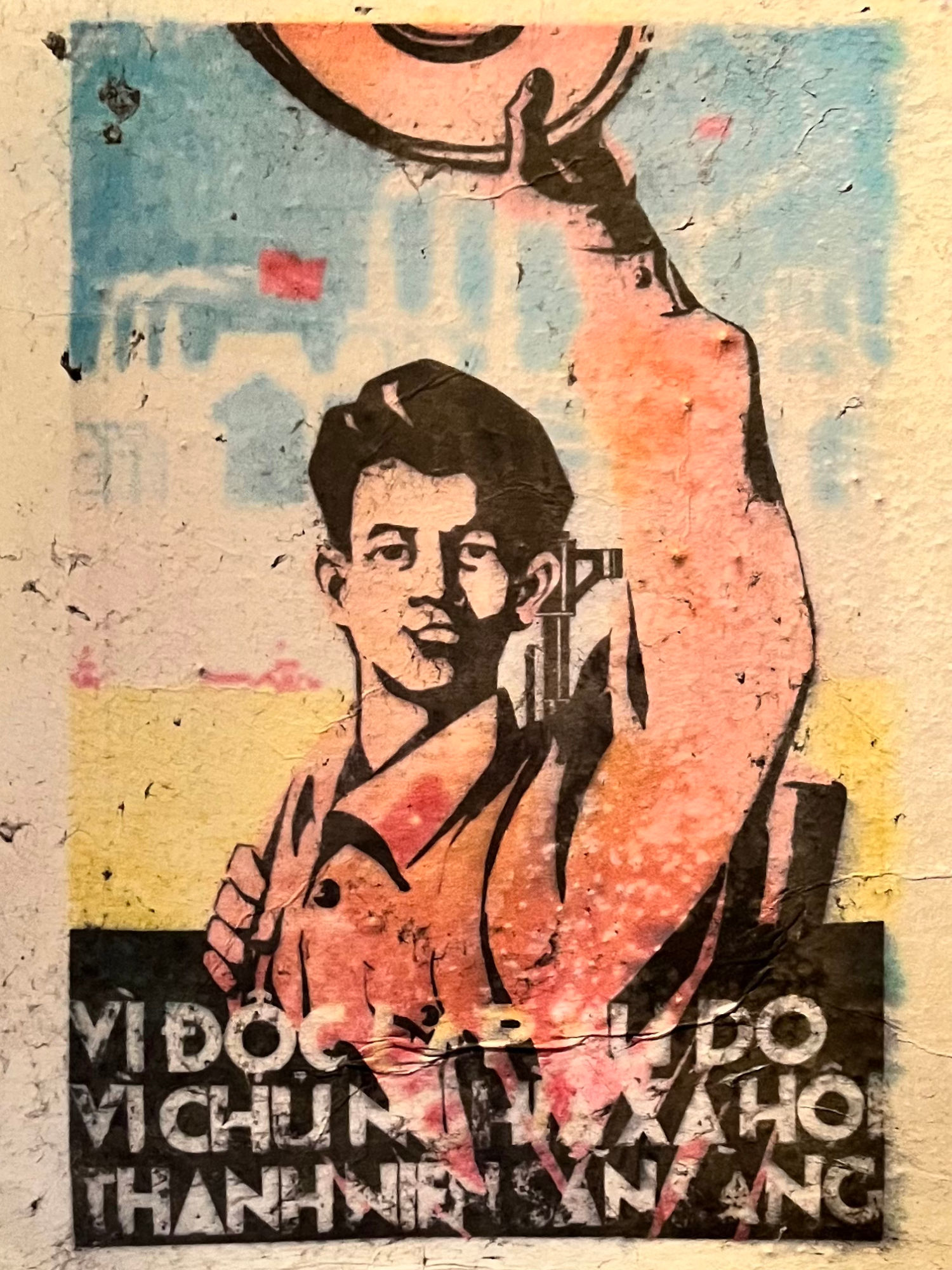
Propaganda Poster
North Vietnamese
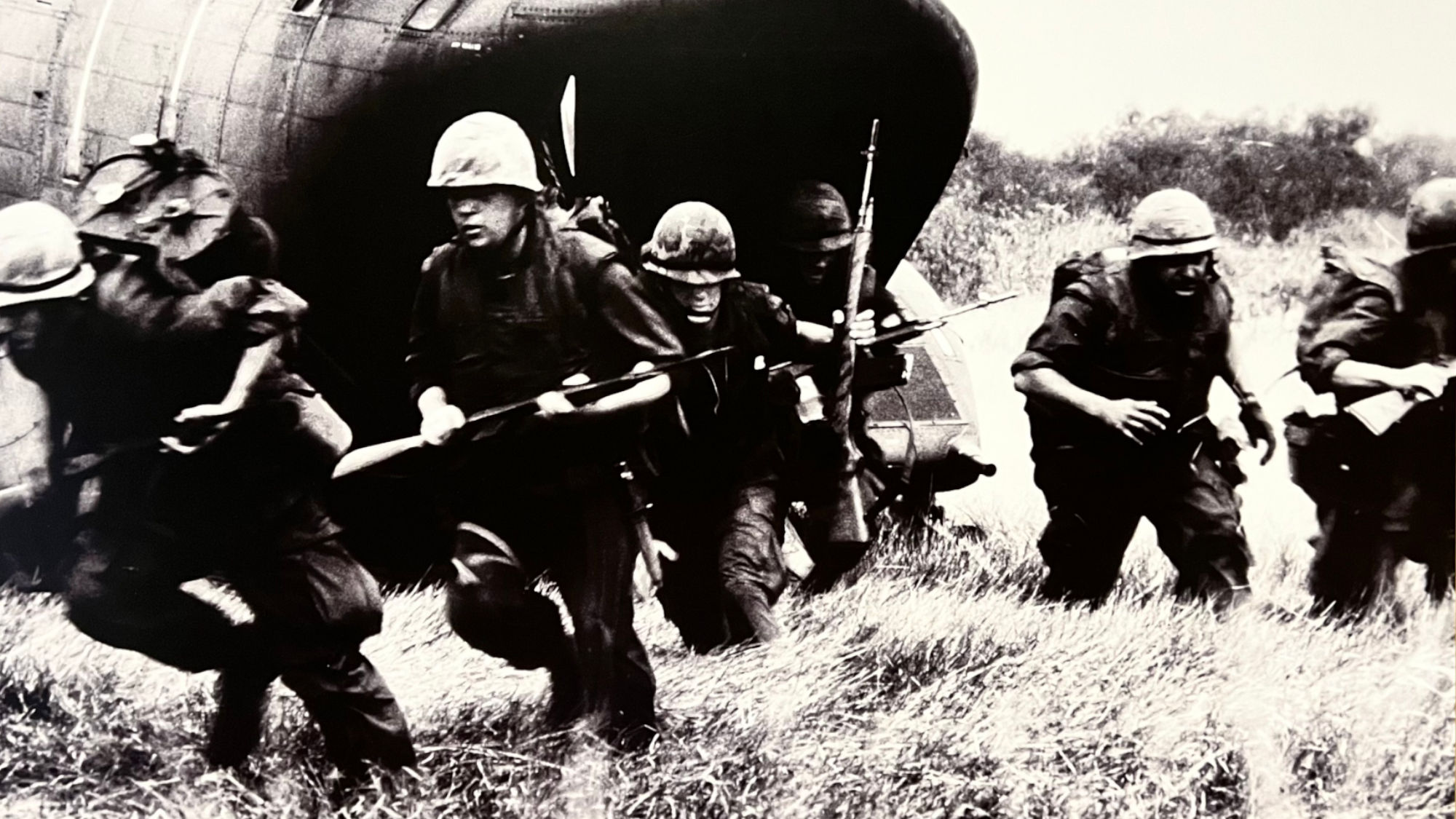
Marines
Viet Cong
Marines rush out of a helicopter during a vertical assault against the Viet Cong on March 26, 1966.
Viet Cong
North Vietnamese Liberation Front Communist Movement that fought in South Vietnam as Guerrillas as well as Regular Army Units. AKA the Liberation Army of South Vietnam (LASV)
Not Just a Letter Home
Sybil Stockdale
U.S. Navy aviator James Stockdale was shot down over Vietnam on September 9, 1965. Back home in California, Stockdale's wife, Sybil, was told that he was missing. Seven months would pass before she would know whether her husband was dead or alive.
On April 16, 1966, two letters addressed from Hanoi arrived in her mailbox. The letters were from her missing husband. After reading and rereading the letters, she informed the local Naval Intelligence office of their contents.
It turned out that Stockdale's letters weren't just simple notes home. They contained a code that provided the Navy with important information about what the POWs were enduring at the hands of their captors.
Naval Intelligence enlisted Mrs. Stockdale in a plan to exchange letters, using a code based on personal history with her husband. The plan was risky. If the North Vietnamese discovered that the Stockdales were exchanging coded messages, they would likely kill their prisoner immediately.
Over the next seven years, the Stockdales corresponded in code. Mrs. Stockdale would later admit that writing the coded letters caused her severe emotional distress. But the information contained within essentially gave the Pentagon a spy inside the Hanoi Hilton.
When Sybil Stockdale died in 2015, Senator McCain, who had been imprisoned alongside her husband said,
Sybil's selfless service and sacrifice fighting for American prisoners of war ...has left an indelible mark on the nation that will never be forgotten.
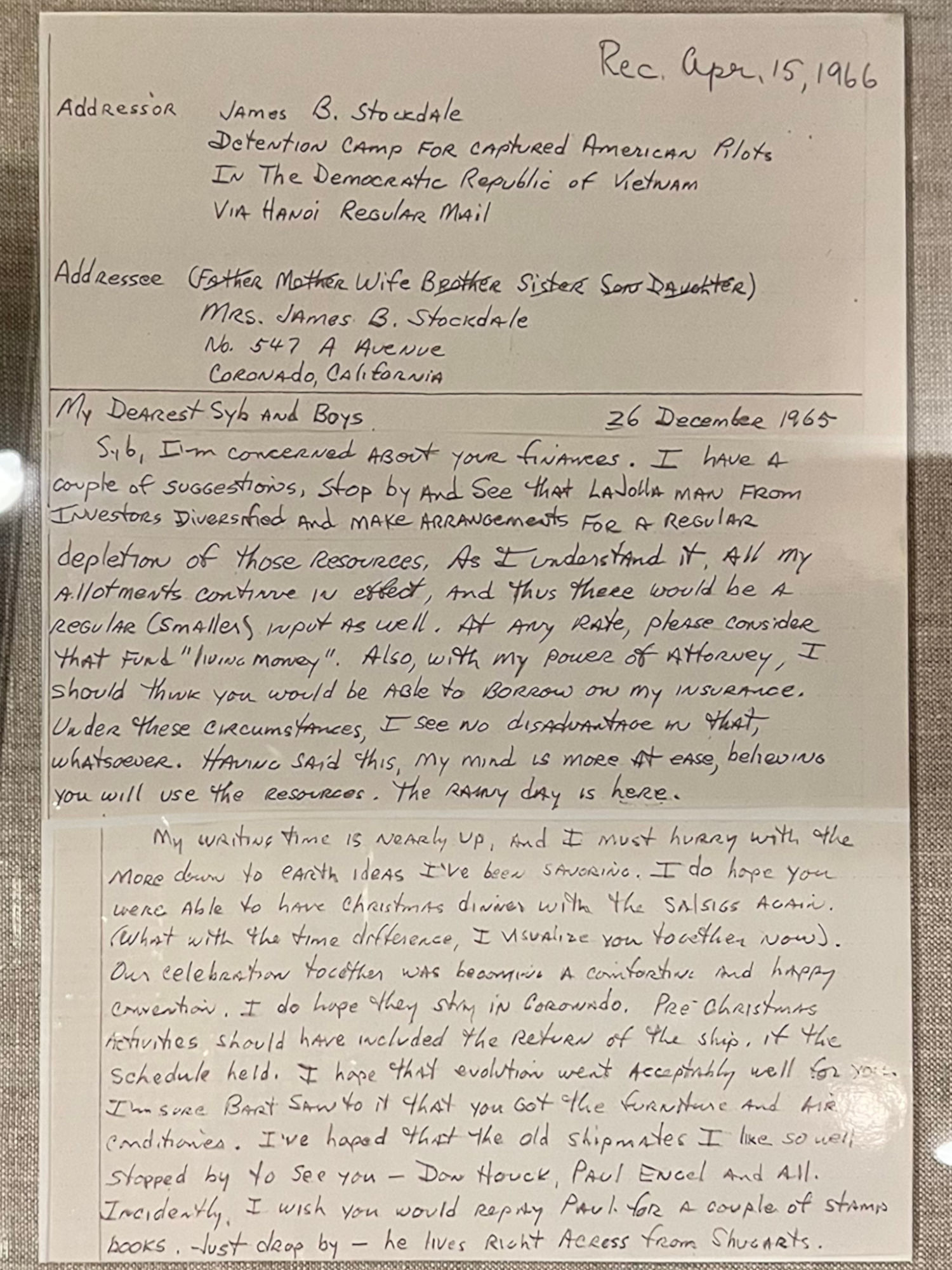
My Dearest Syb and Boys
26 December 1965
Paragraph 3
Syb, I'm concerned about your finances. I have a couple of suggestions, stop by and see that LaJolla man from investors diversified and make arrangements for a regular depletion of those resources, as I understand it, all my allotments continue in effect, and thus there would be a regular (smaller) input as well. At any rate, please consider that fund "living money". Also, with my power of attorney, I should think you would be able to borrow on my insurance. Under these circumstances, I see no disadvantage in that, whatsoever. Having said this, my mind is more at ease, believing you will use the resources. The rainy day is here.
Paragraph 7
My writing time is nearly up, and I must hurry with the more down to earth ideas I've been savoring. I do hope you were able to have Christmas dinner with the Salsigs again. (What with the time difference, I visualize you together now). Our celebration together was becoming a comforting and happy connection. I do hope they stay in Coronado. Pre-Christmas activities should have included the return of the ship, if the schedule held. I hope that evolution went exceptionally well for you. I'm sure Bart saw to it that you got the furniture and air conditioners. I've hoped that the old shipmates I like so well stopped by to see you - Don Houck, Paul Encel and all. Incidentally, I wish you would repay Paul for a couple of stamp books. -just drop by - he lives right across from Shugarts.
In this fascimile of James Stockdale's December 26 letter to Sybil, he encourages her to repay a loan to a local family. This was a coded message confirming that the soldier who was a member of that household was currently being held at the Hanoi Hilton.
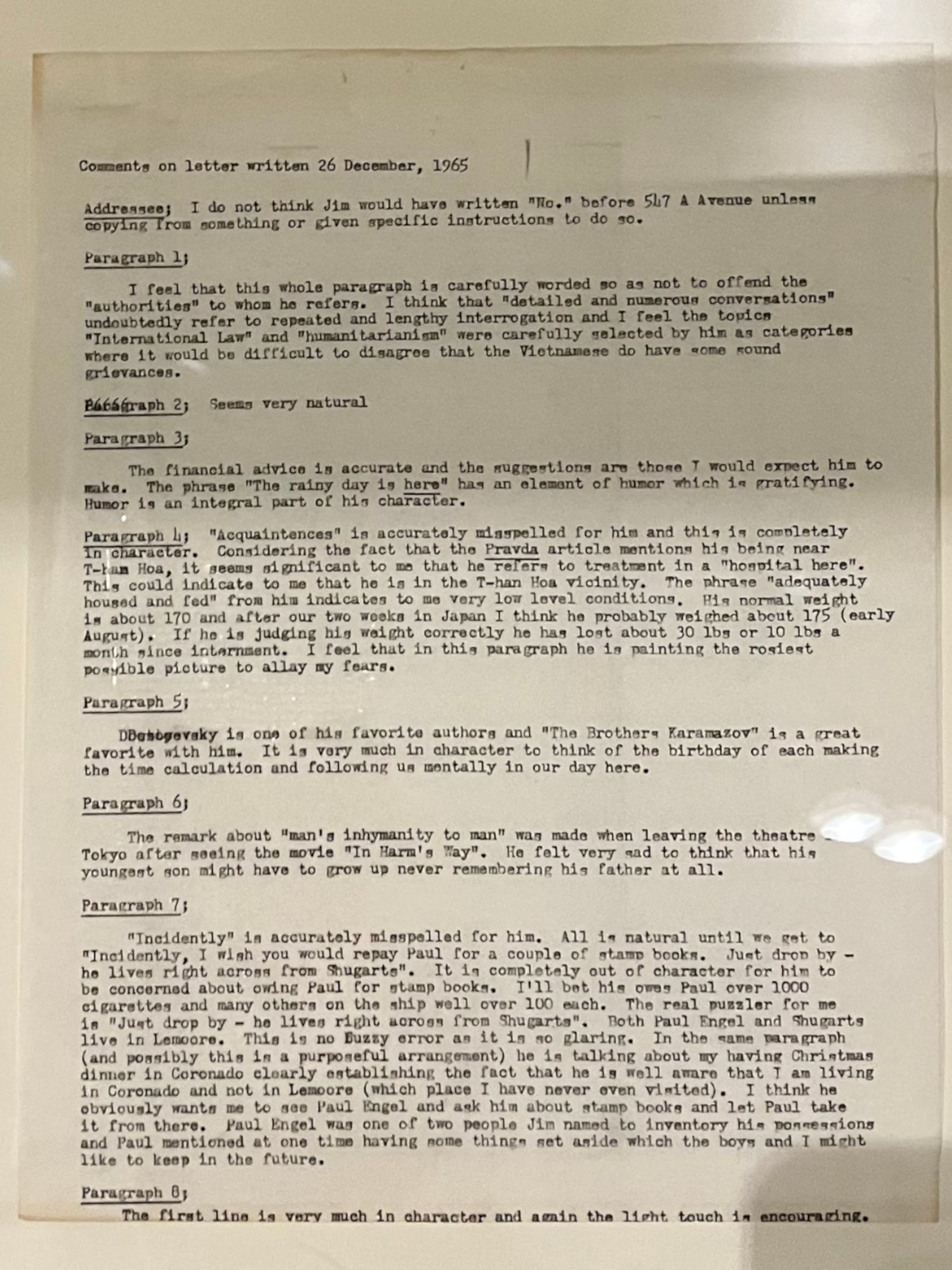
December Letter Comments
Sybil Stockdale's Comments on James Stockdale's December 26 1965 Letter
She worked closely with the CIA to create coded letters back to her husband in an attempt to extract clandestine information. In one paragraph analysis, Sybil calls out Commander Stockdale's use of punctuation and suggests further examination of that section of the letter.
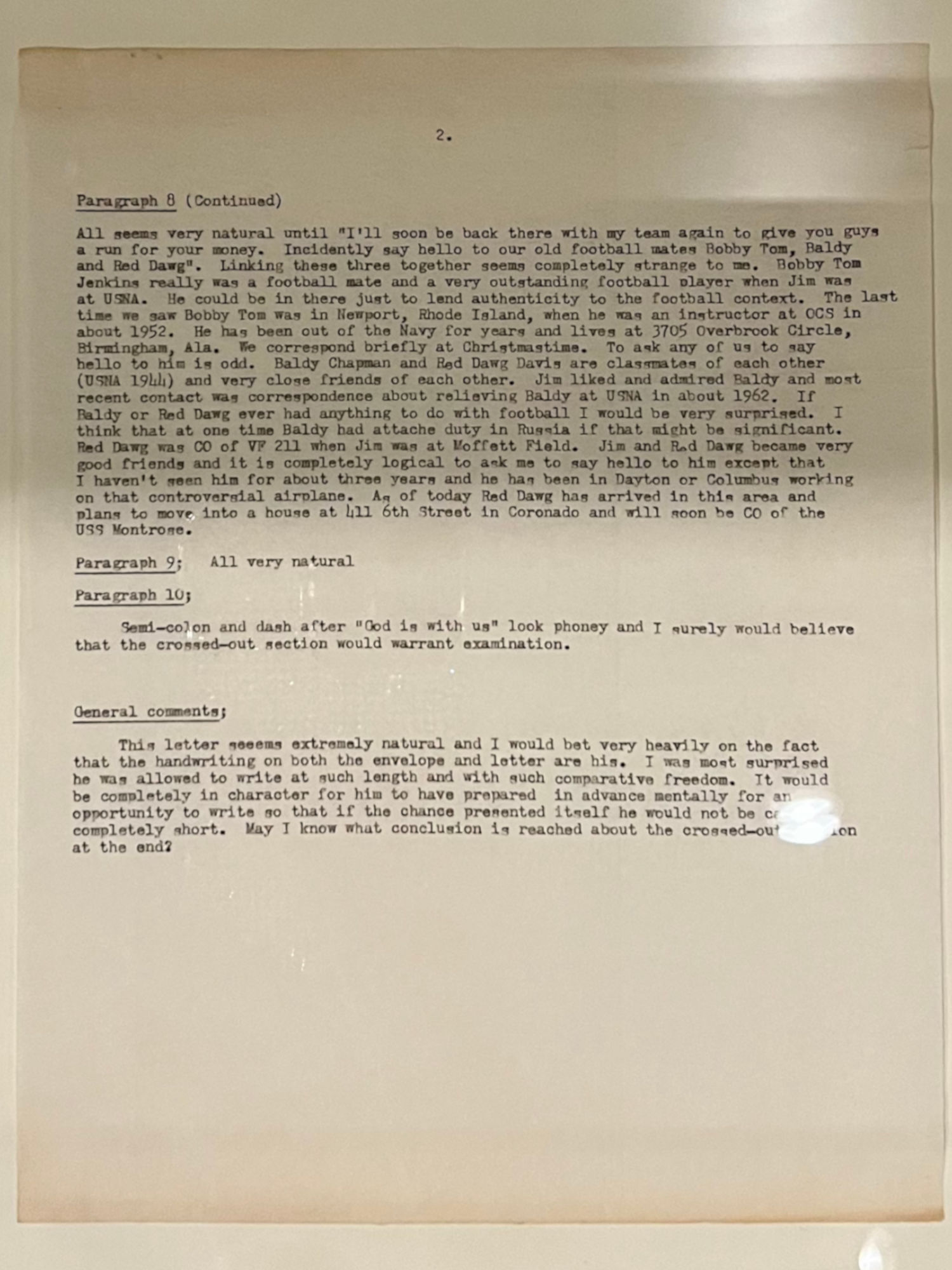
T-O-R-T-U-R-E
Jeremiah Denton
In early May 1966, POW Jeremiah Denton was forced by his North Vietnamese captors to be interviewed on camera by a japanese journalist. Shot down ten months earlier, Denton knew that if he didn't say exactly what was expected of him, he would be tortured by the prison guards who had already proven their abilities to inflict great pain.
- Commander Jeremiah Denton, U.S. Navy
As the North Vietnamese had hoped, Denton said he was being treated well, although it was obvious by his appearance that he was not. But he refused to criticize the United States on camera, denying the Vietnamese a propaganda victory.
To demonstrate that he was being forced to sit for the interview, Denton blinked the word "TORTURE" in Morse Code directly into the camera.
The Vietnamese did not realize the subliminal message Denton was sending and did not stop the interview, which soon aired on Japanese television. But U.S. Naval Intelligence saw the message he was sending with his eyes. For the first time, the Pentagon had confirmation that American POWs were being tortured.
WIKIPEDIAJeremiah Andrew Denton Jr.
During the Vietnam War, Denton spent almost eight years as an American prisoner of war (POW) in North Vietnam after the A-6 Intruder he was piloting suffered severe damage resulting from a defective bomb, which detonated as he released his payload in 1965.His 34-year naval career included service on a variety of ships and on aircraft, including airships. Denton served as a United States Naval Aviator during the Vietnam War. In February 1965, he became the Prospective Commanding Officer of Attack Squadron Seventy-Five serving aboard aircraft carrier USS Independence (CV-62).
On July 18, 1965, Commander Denton was piloting his A-6A Intruder jet (BUNO 151577) while leading a 28-aircraft bombing mission over North Vietnam off the Independence which was stationed in the South China Sea. He and LTJG Bill Tschudy, his bombardier/navigator, were forced to eject from their plane, damaged by one of their own Mark 82 bombs exploding shortly after its release after which it went down out of control near the city of Thanh Hoa in North Vietnam. Both men were quickly captured and taken prisoner.
- Denton and Tschudy were held as prisoners of war for almost eight years, four of which were spent in solitary confinement.
- During the Hanoi March in July 1966, he and over 50 other American prisoners were paraded through the streets of Hanoi and beaten by North Vietnamese civilians.
- As one of the earliest and highest-ranking officers to be taken prisoner in North Vietnam, Denton was forced by his captors to participate in a 1966 televised propaganda interview which was broadcast in the United States. While answering questions and feigning trouble with the blinding television lights, Denton blinked his eyes in Morse code, spelling the word "T-O-R-T-U-R-E"-and confirming for the first time to U.S. Naval Intelligence that American POWs were being tortured.
- He was the first of the American POWs released by Hanoi to step off an American plane during Operation Homecoming on February 12, 1973.
Shot Down and Captured!
Anti-Aircraft Weapons
The United States flew hundreds of thousands of air missions over Vietnam from 1964 to 1973. The U.S. had an advantage over North Vietnam in the air - advanced equipment, superior tactics, and better intelligence. Nevertheless, aided by anti-aircraft weapons supplied by both the Soviet Union and the People's Republic of China, North Vietnam succeeded in shooting down American aircraft.
Colonel James Lamar was shot down in North Vietnam on May 6, 1966, during his 101st mission. He described the experience years later:
As his plane was going down, Lamar ejected. He woke up with a broken arm and his parachute hanging from a tree. A group of Vietnamese peasants found Lamar. They turned him over to the North Vietnamese army.
Lamar was tortured by his captors. They unsuccessfully attempted to get him to lure other American aviators into an ambush. Having failed to break him, Lamar was then taken to Hanoi. There he was held in the notorious "Hanoi Hilton" POW prison. Lamar was released and returned home in 1973 at the end of the war.
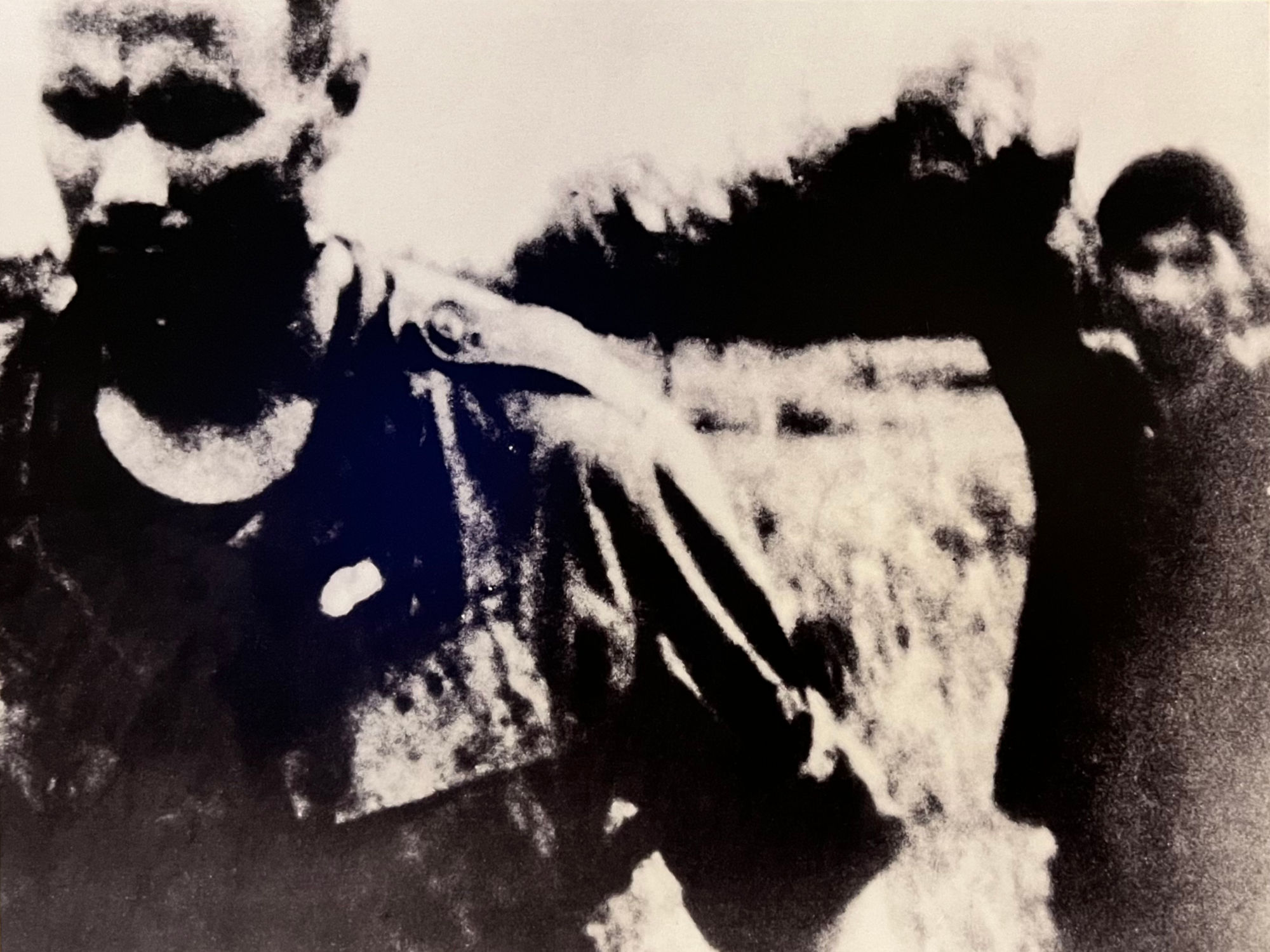
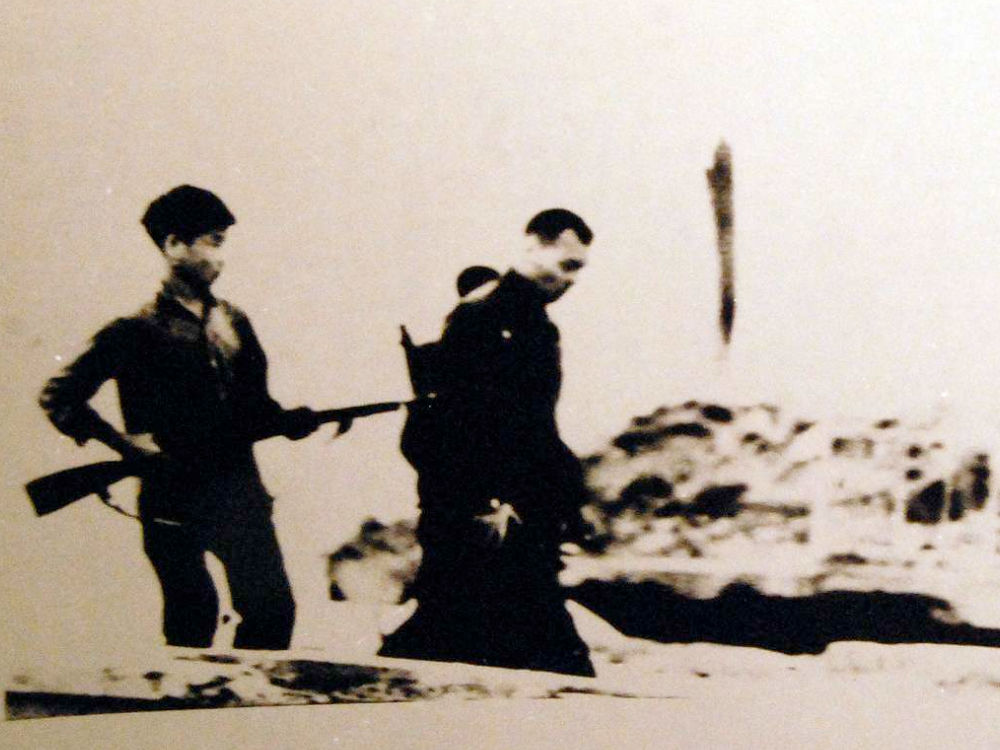
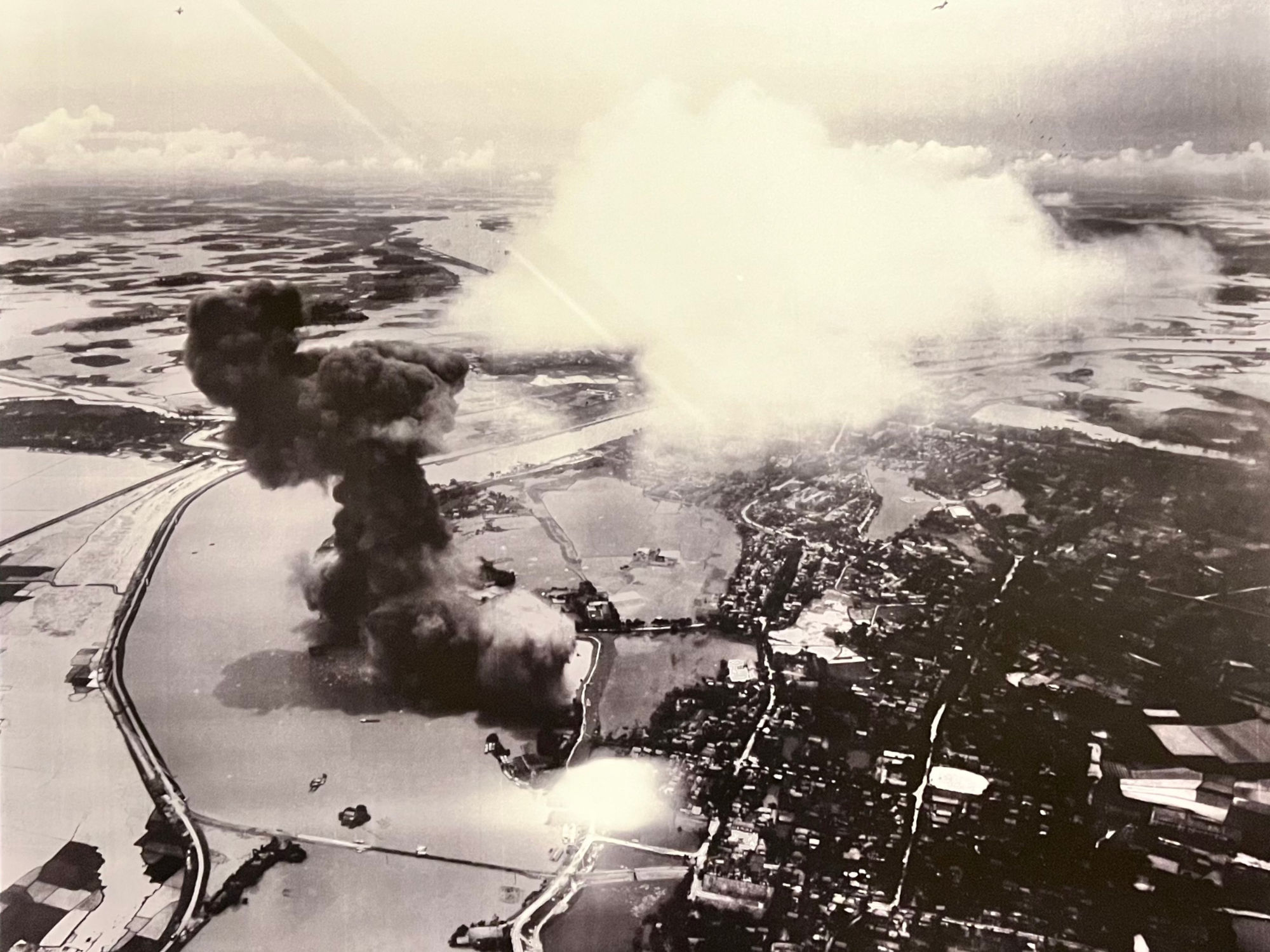
U.S. Bombing Raid
Giang Fuel Storage Area, North Vietnam
A U.S. bombing raid on a North Vietnamese oil depot. Such facilities were vital in keeping the Vietnamese war machine running.
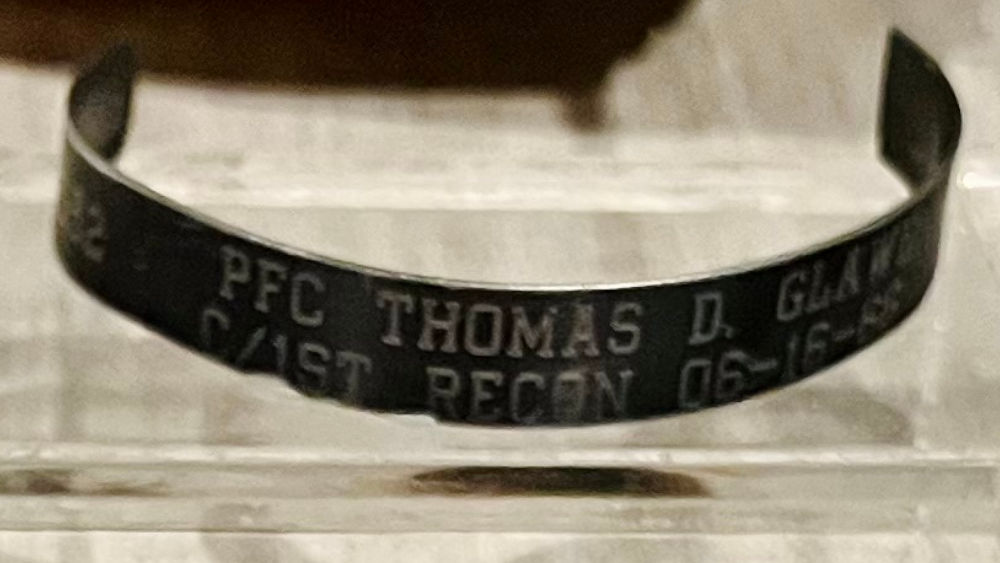
Thomas Duane Glawe
The Battle of Hill 488
Black POW bracelets denoted those servicemen killed in action. Private First Class Thomas Duane Glawe was 18 years old when he was mortally wounded on June 16, 1966 at the Battle of Hill 488. The bracelet also bears Private Glawe's rank, unit, date, and location of loss.
Tommy,
I wore this bracelet to keep you close to my heart. One day it broke and fell from my wrist. I think it was your way of saying let go.
Your friend & brother Jack
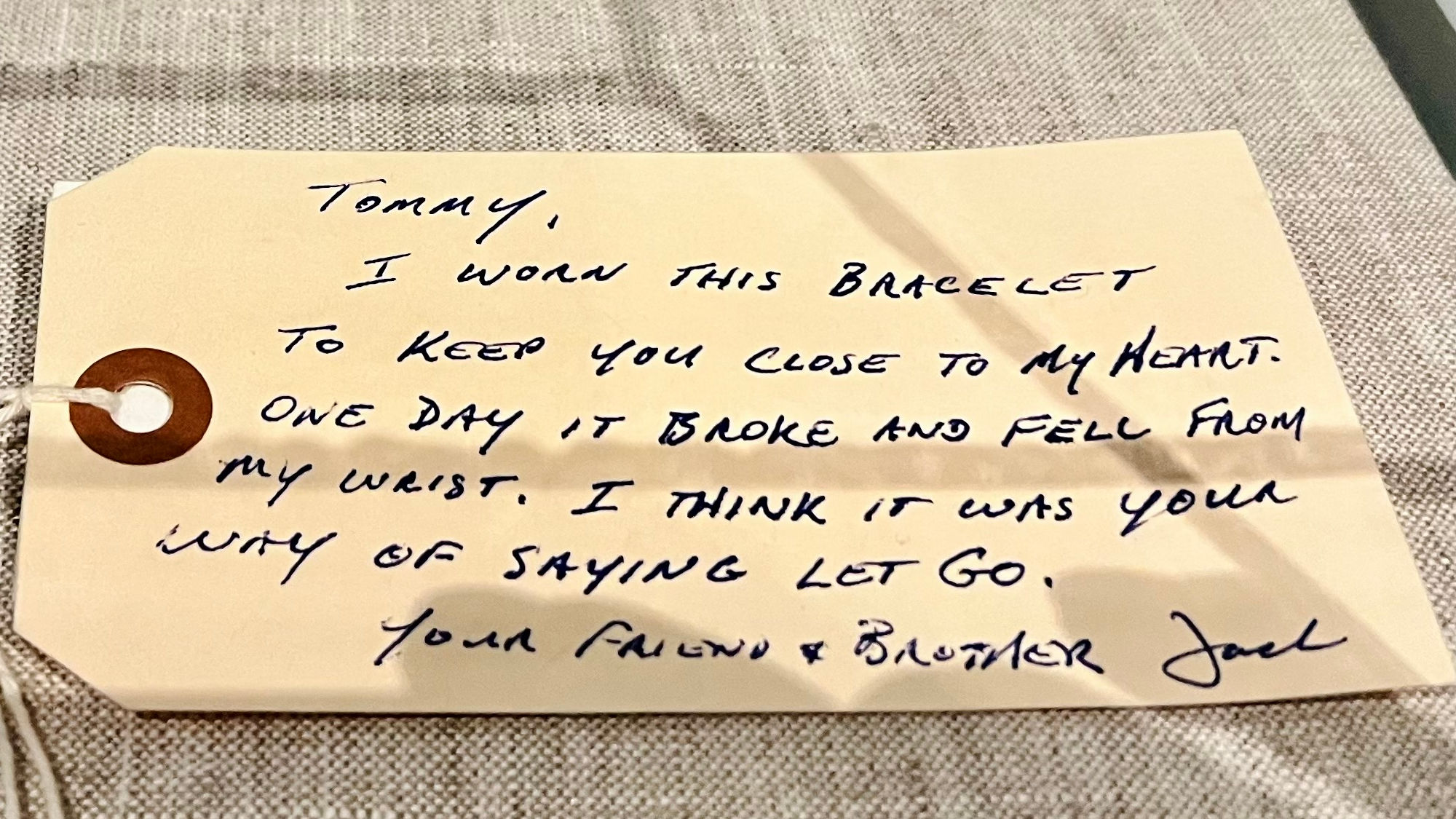
WIKIPEDIAThe Battle of Hill 488
Vietnam War military engagement that took place on the night of 15�16 June 1966. A small United States Marine Corps (USMC) reconnaissance platoon inflicted large casualties on regular People's Army of Vietnam (PAVN) and Viet Cong (VC) fighters before withdrawing with only a few dead.
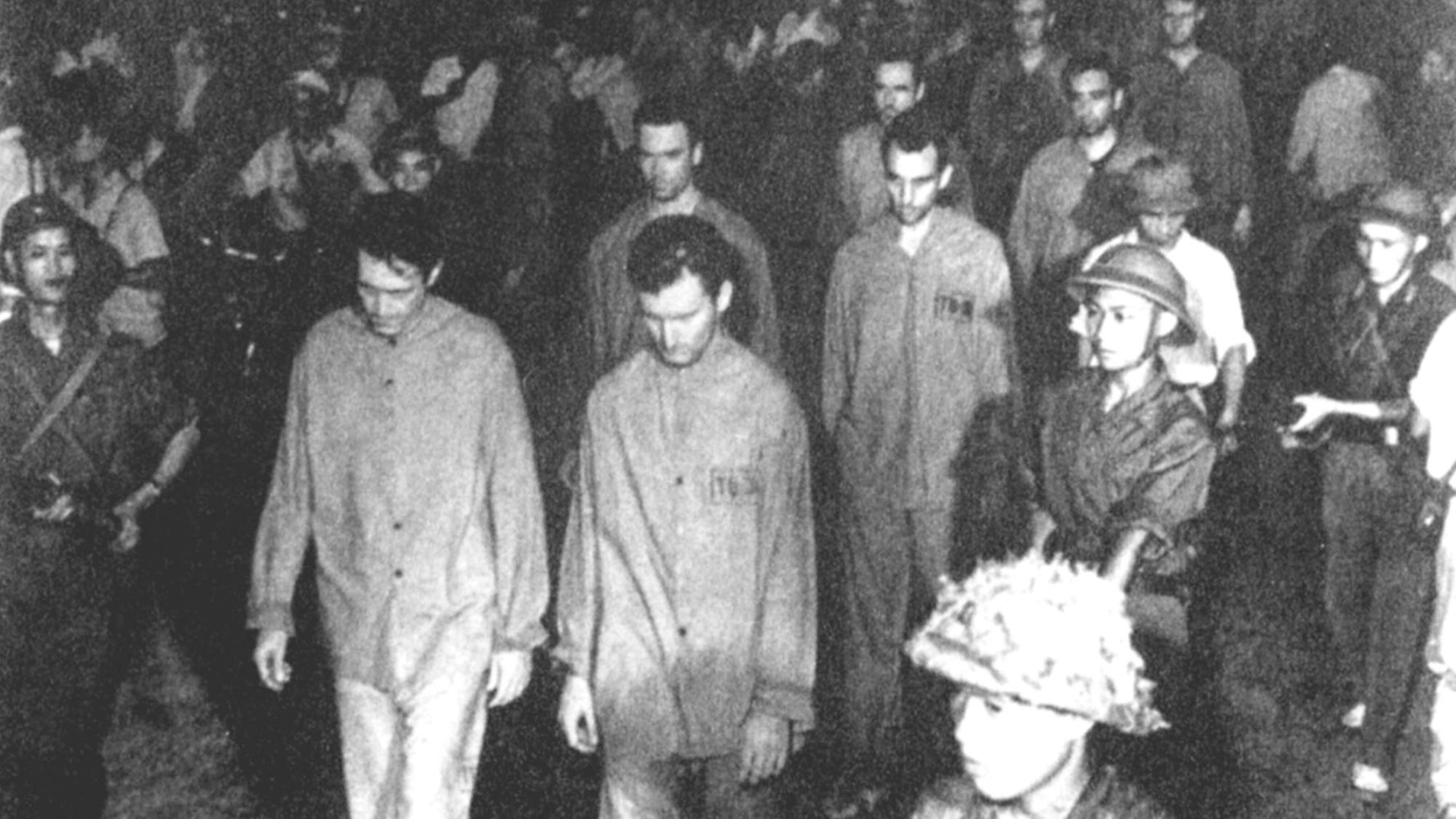
POW Parade
Hanoi March
American POWs were forced to walk handcuffed in pairs through the streets of Hanoi, in July 1966. The march was a propaganda parade in an attempt to humiliate the POWs and break their will to resist.
The were paraded before angry crowds, where loudspeakers blared insults and encouraged the crowd's abuse. Many in the crowd attacked the POWs.
- Richard Kiern
- Kile Berg
- Robert Shumaker
- "Smitty" Harris
- Ronald Byrne
- Lawrence Guarino
Those at Home
Every prisoner of war and every warrior missing in action had family and friends back home in the United States who were deeply worried about them. The North Vietnamese refused to abide by the Geneva Conventions, including provisions that would provide families with information about the status of their loved ones.
The North Vietnamese refused to provide the names of every POW held. They refused to allow neutral observers to inspect their prisons. They denied prisoners the right to correspond with their families within a week of their capture.
As a result, family members were often left for months without any information about the fate of their loved ones. Government officials working for President Johnson brushed them off, saying that going public would endanger the lives of others.
Historian Heath Hardage Lee wrote in her book, The League of Wives:
By late 1966, the realization was sinking in among the POW and MIA wives that they were low priority on the Johnson administration agenda
This "benign neglect," as one wife put it, would galvanize the wives of the POWs and MIAs to action on behalf of their imprisoned or missing husbands.
RELATED: [https://www.amazon.com/dp/1250161118]
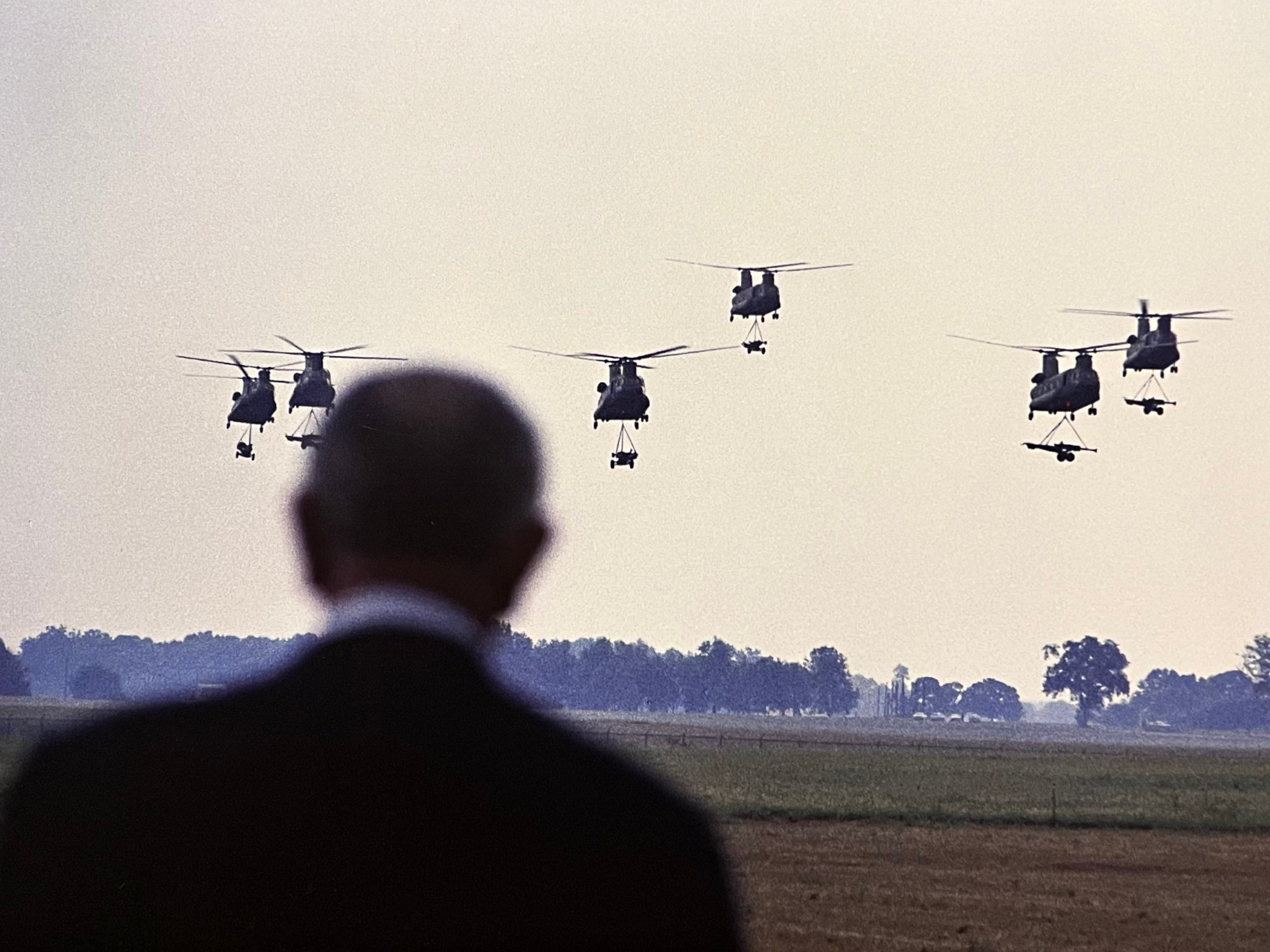
President Johnson
President Johnson visits troops in Fort Campbell, Kentucky
Helicopter Flight Exercise
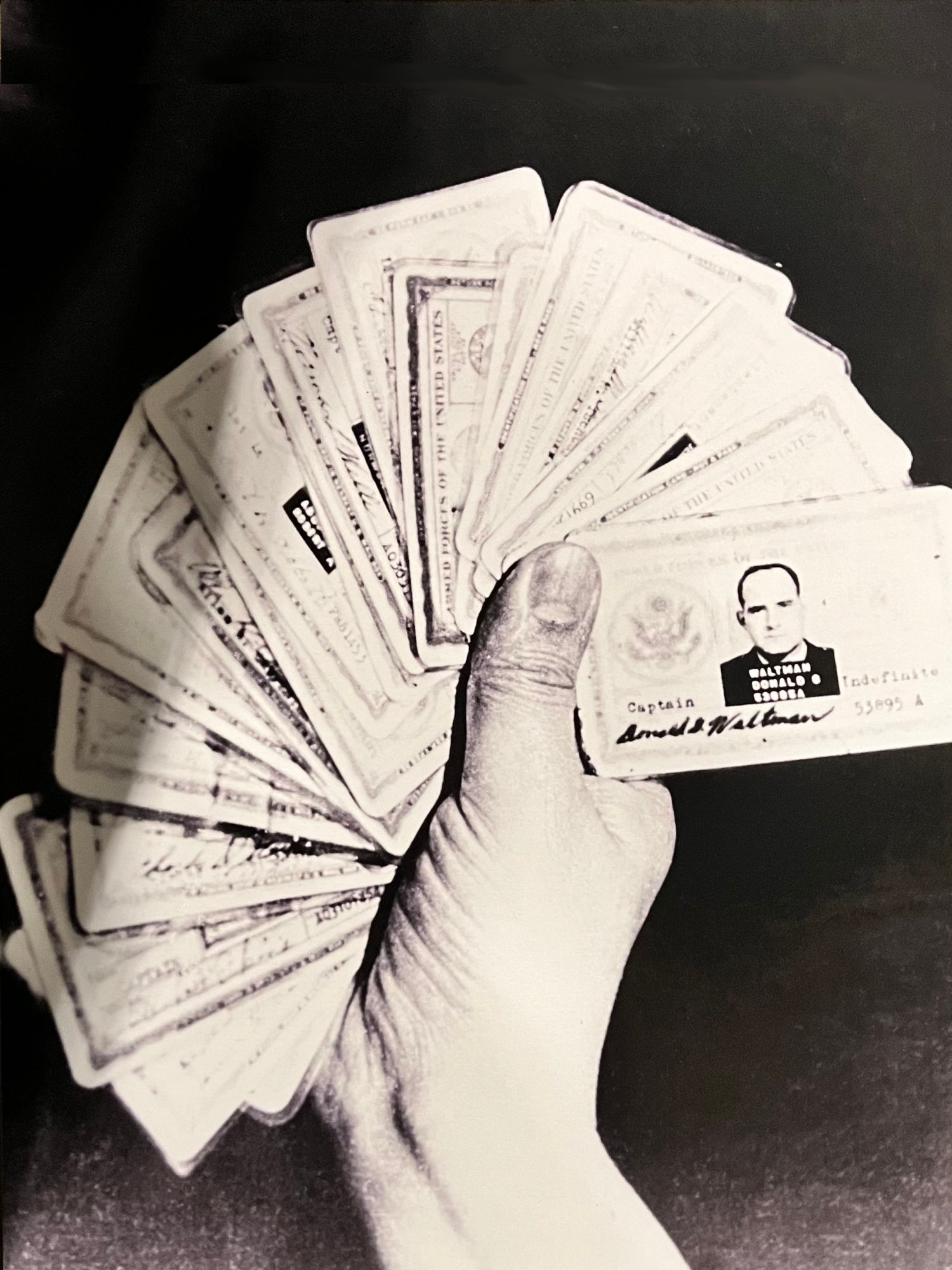
Donald Waltman
- Shot Down September 19 1966
- Released March 4 1973
A handful of official ID cards from captured POWS being exhibited as a war trophy. U.S. Air Force Captain Donald Waltman's ID is seen on top the stack.
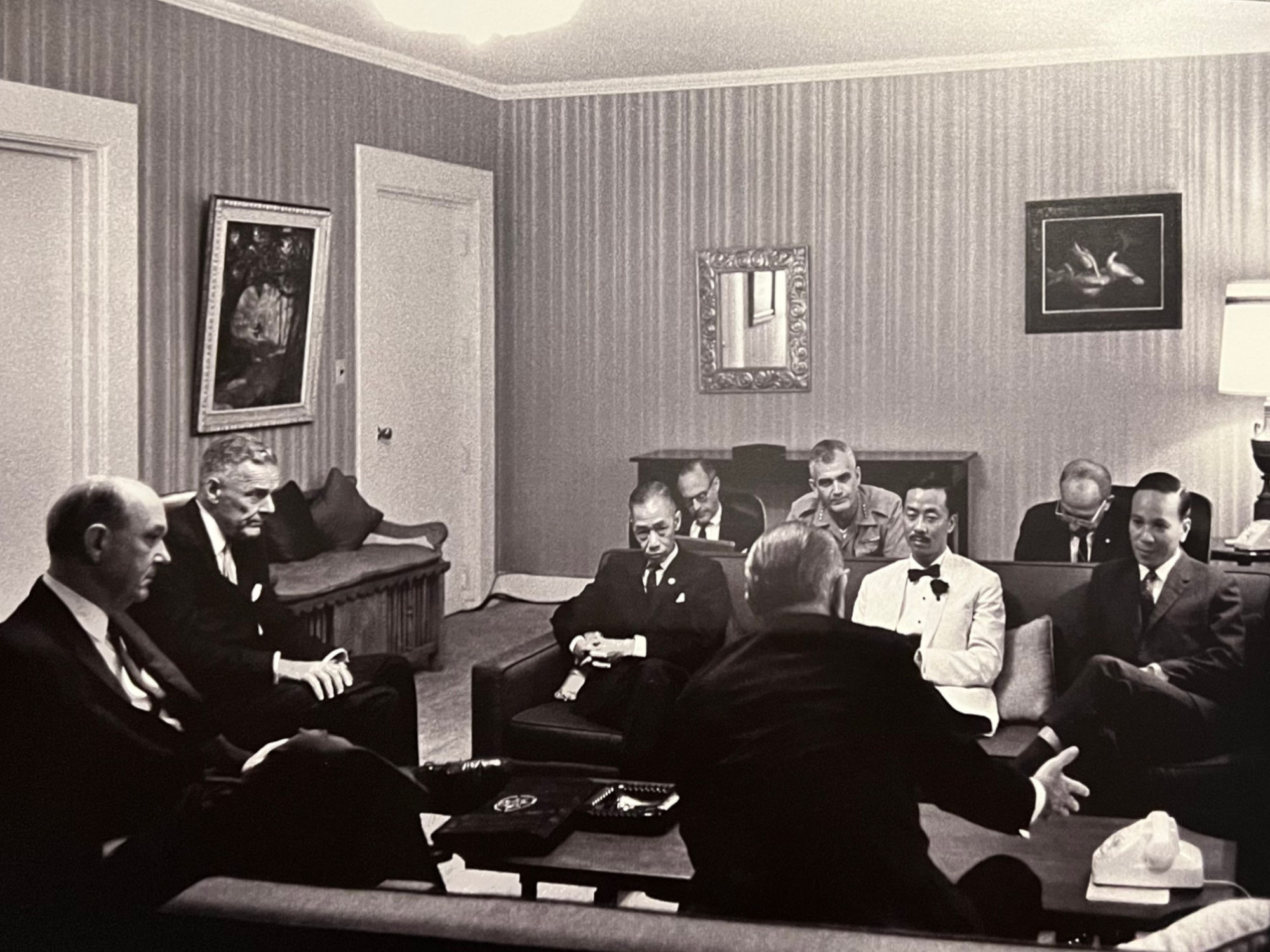
Johnson & Thieu
City of Manila, Philippines
President Johnson discusses the status of the war with South Vietnam's President Thieu at the Manila Conference, October 23, 1966
- Secretary of State Dean Rusk
- Ambassador Henry Cabot Lodge
- Unknown
- Robert Komer
- President Lyndon B. Johnson
- General William Westmoreland
- Prime Minister Nguyen Cao Ky (South Vietnam)
- Walt Rostow
- Lieutenant General Nguyen Van Thieu (South Vietnam)
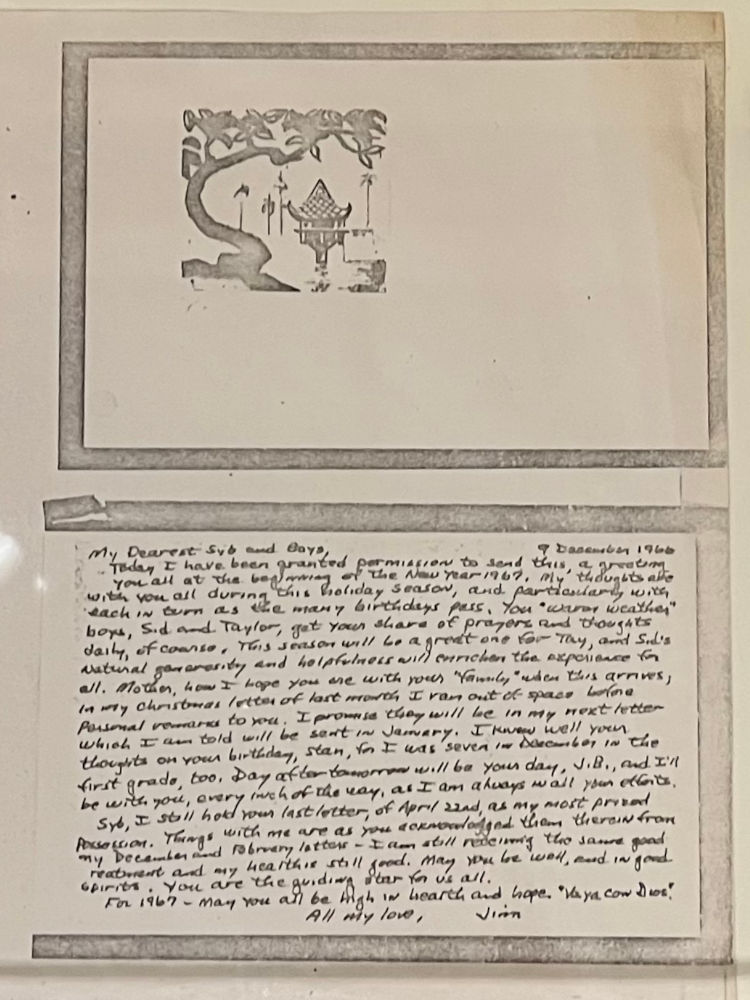
My Dearest Syb and Boys
9 December 1966
Today I have been granted permission to send this, a greeting to you all at the beginning of the New Year 1967. My thoughts are with you all during this holiday season, and particularly with each in turn as the many birthdays pass. You "warm weather" boys, Sid and Taylor, get your share of prayers and thoughts daily, of course. This season will be a great one for Tay, and Sid's natural generosity and helpfulness will enrichen the experience for all. Mother, how I hope you are with your "family" when this arrives. In my Christmas letter of last month I ran out of space before personal remarks to you. I promise they will be in my next letter which I am told will be sent in January. I know well your thoughts on your birthday, Stan, for I was seven in December in the first grade, too. Day after tomorrow will be your day, J.B., and I'll be with you, every inch of the way, as I am always in all your efforts.
Syb, I still hold your last letter, of April 22nd, as my most prized possession. Things with me are as you acknowledged them therein from my December and February letters - I am still receiving the same good treatment and my health is still good. May you be well, and in good spirits. You're the guiding star for us all.
For 1967 - May you all be high in hearth and hope. "Vaya con Dios,"
All my love, Jim
This encoded postcard was sent by Commander James Stockdale to Sybil wishing he could be at home with his family during the holiday season. Although the correspondence between Commander James Stockdale and his wife, Sybil, appeared normal to the average reader, the letters actually contained encoded messages detailing living conditions at the Hanoi Hilton.
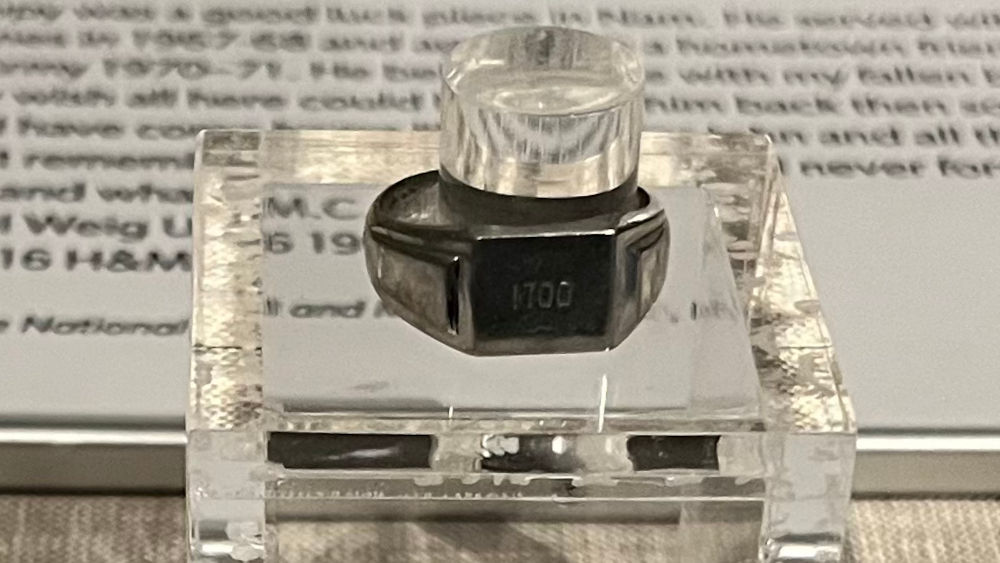
Scrap Metal Ring
This ring was reportedly made of scraps from the 1,700th American aircraft shot down over Vietnam.
Aircraft Losses to Date
- 1,120 Fixed-Wing Aircraft
- 630 Helicopters
- 3,744 Planes
- 5,607 Helicopters
- 1,000 Unmanned Aircraft
Nine Rules
For Personnel of US Military Assistance Command, VietnamThe Vietnamese have paid a heavy price in suffering for their long fight against the communists. We military men are in Vietnam now because their government has asked us to help its soldiers and people in winning their struggle. The Viet Cong will attempt to turn the Vietnamese people against you. You can defeat them at every turn by the strength, understanding, and generosity you display with the people. Here are nine simple rules:
- Remember we are guests here: We make no demands and seek no special treatment.
- Join with the people! Understand their life, use phrases from their language and honor their customs and laws.
- Treat women with politeness and respect.
- Make personal friends among the soldiers and common people.
- Always give the Vietnamese the right of way.
- Be alert to security and ready to react with your military skill.
- Don't attract attention by loud, rude or unusual behavior.
- Avoid separating yourself from the people by a display of wealth or privilege.
- Above all else you are members of the U.S. Military Forces on a difficult mission, responsible for all your official and personal actions. Reflect honor upon yourself and the United States of America.
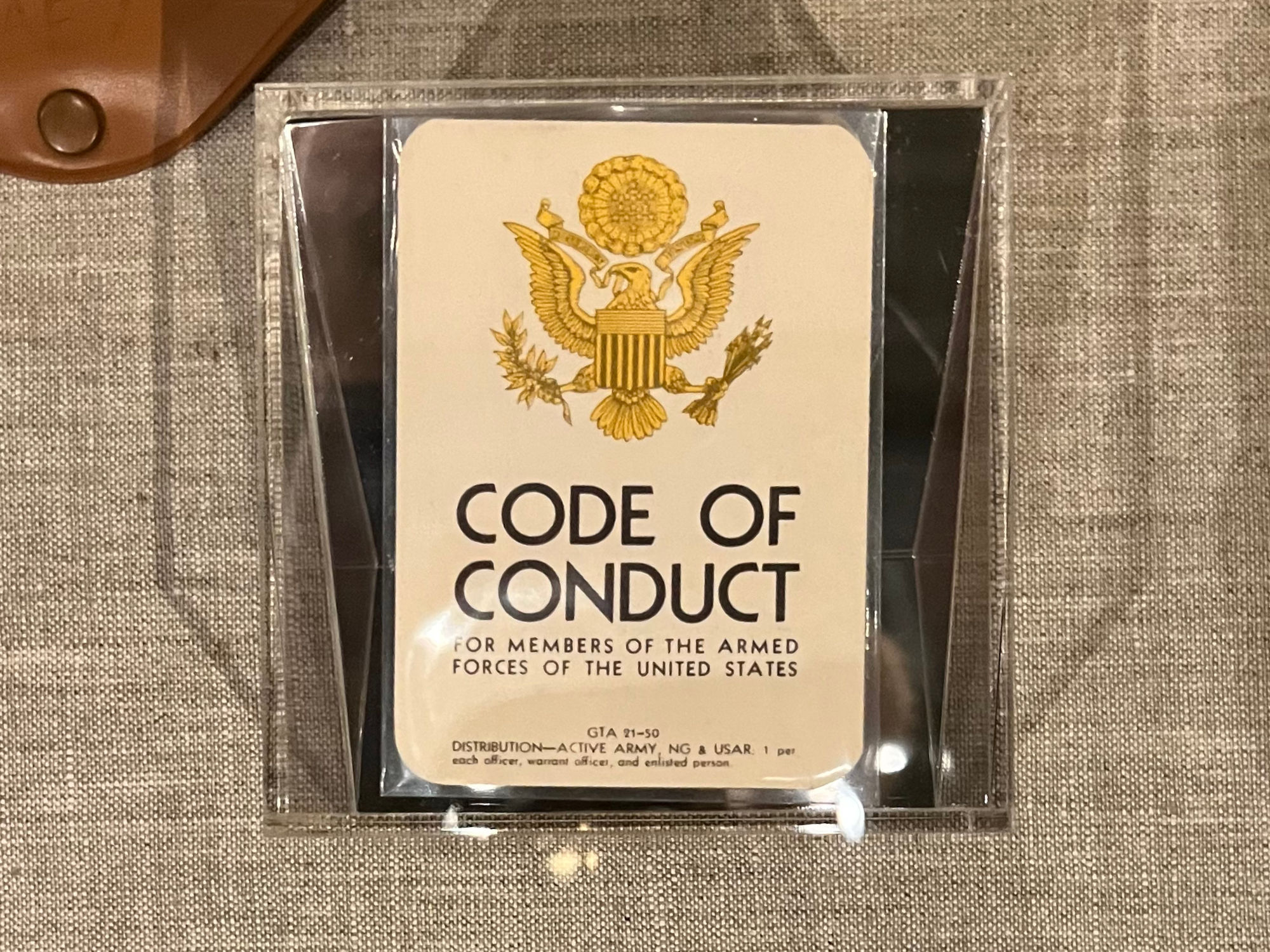
Code of Conduct
Nine Rules of Conduct Card
In 1967, General William Westmoreland ordered that all American military personnel entering Vietnam be given a pocket card explaining how to behave themselves in foreign lands. Known as the "Nine Rules of Conduct Card," the rules were developed as a way to foster positive relationships between American soldiers and South Vietnamese villagers. The U.S. Armed Forces developed these rules from Chairman Mao Zedong's "Three Rules of Discipline and Eight Points for Attention."
WIKIPEDIAThe Three Rules of Discipline and Eight Points for Attention
A military doctrine that was issued in 1928 by Mao Zedong and his associates to the Chinese Red Army during the Chinese Civil War. The contents vary slightly in different versions. One of the major distinctions of the doctrine was its respect for the civilians during wartime.Three Rules
- Prompt obedience to orders,
- No confiscation of people's property,
- Prompt delivery directly to authorities of all items confiscated from enemy.
Eight Points
- Be polite when speaking
- Be honest when buying and selling
- Return all borrowed articles
- Pay compensation for everything damaged
- Do not hit or swear at others
- Do not damage crops
- Do not harass females
- Do not mistreat prisoners
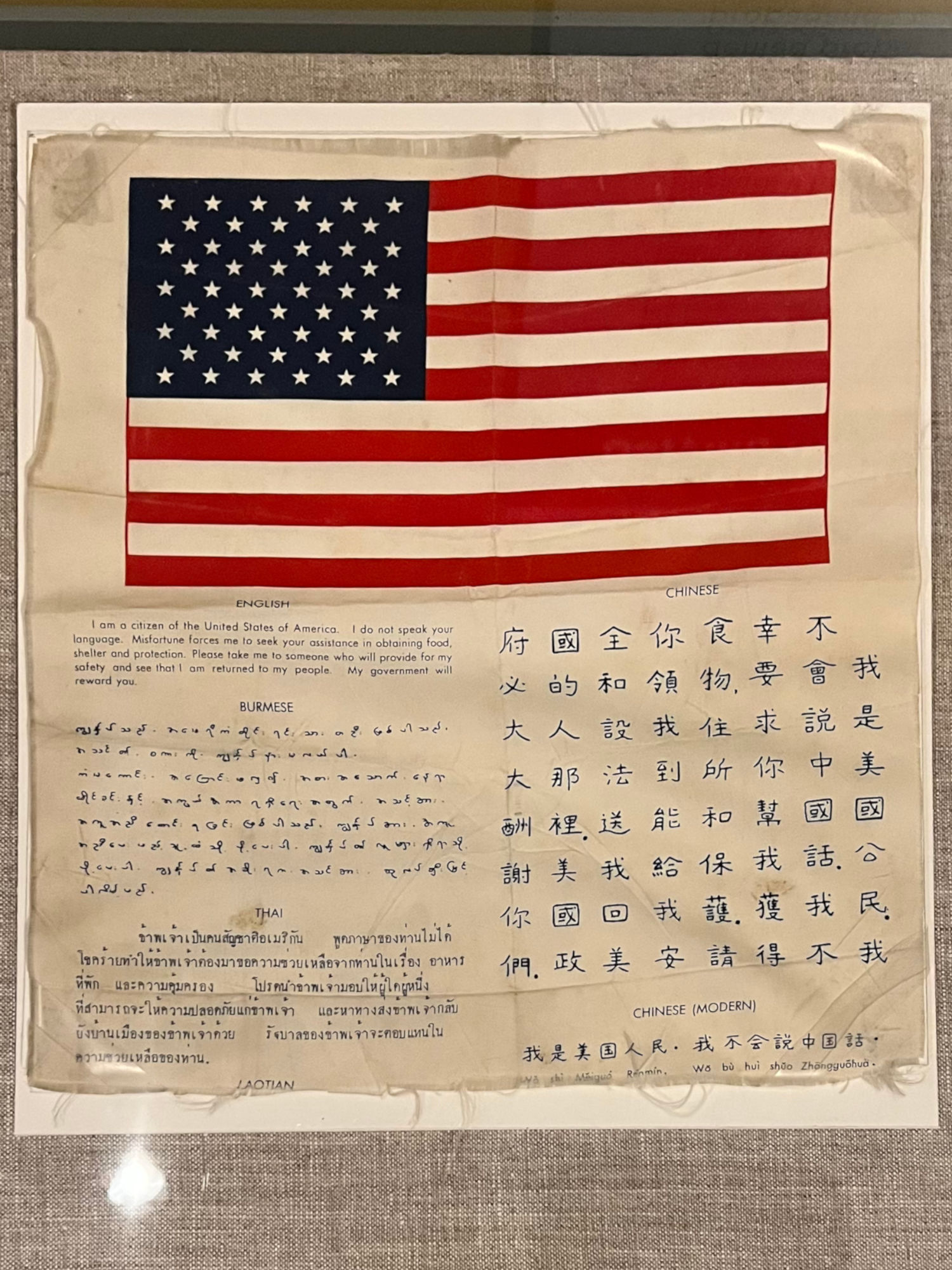
Blood Chit
Escape Flag
This United States military blood chit features the American flag. Underneath is a request for help in English, Burmese, Thai, and Chinese. A blood chit is a document that is given to civilians by military personnel in dire need of assistance.
I am a citizen of the United States of America. I do not speak your language. Misfortune forces me to seek your assistance in obtaining food, shelter and protection. Please take me to someone who will provide for my safely and see that I am returned to my people. My government will reward you
WIKIPEDIAChit
A British English term for a small document or note. Alternative names for blood chit are escape flag or identification flag.A blood chit is a notice carried by military personnel and addressed to any civilians who may come across an armed-services member - such as a shot-down pilot - in difficulties. As well as identifying the force to which the bearer belongs as friendly, the notice displays a message requesting that the service member be rendered every assistance.
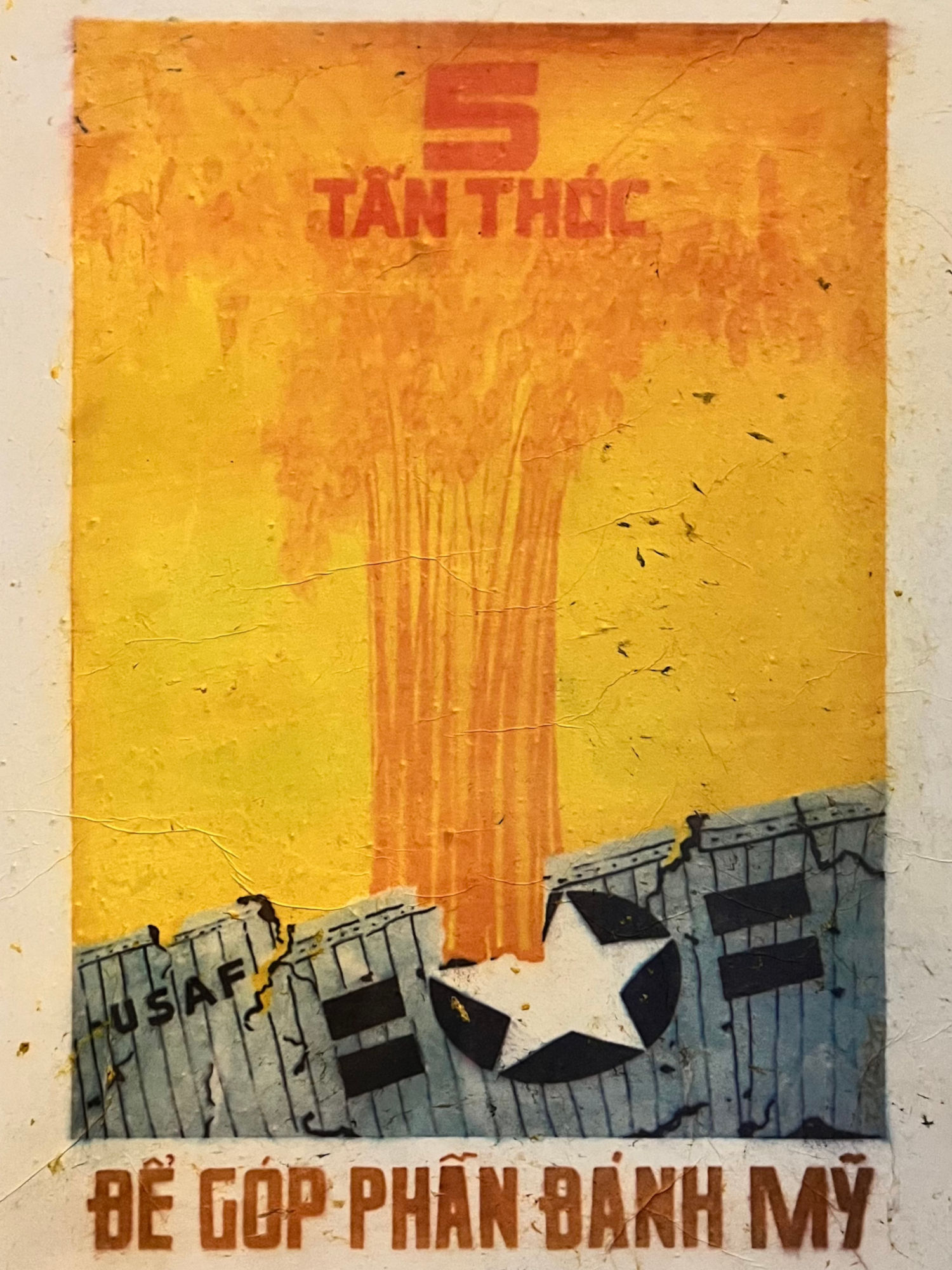
Propaganda Poster
Five tons of rice per hectare were used to fight the US Invaders
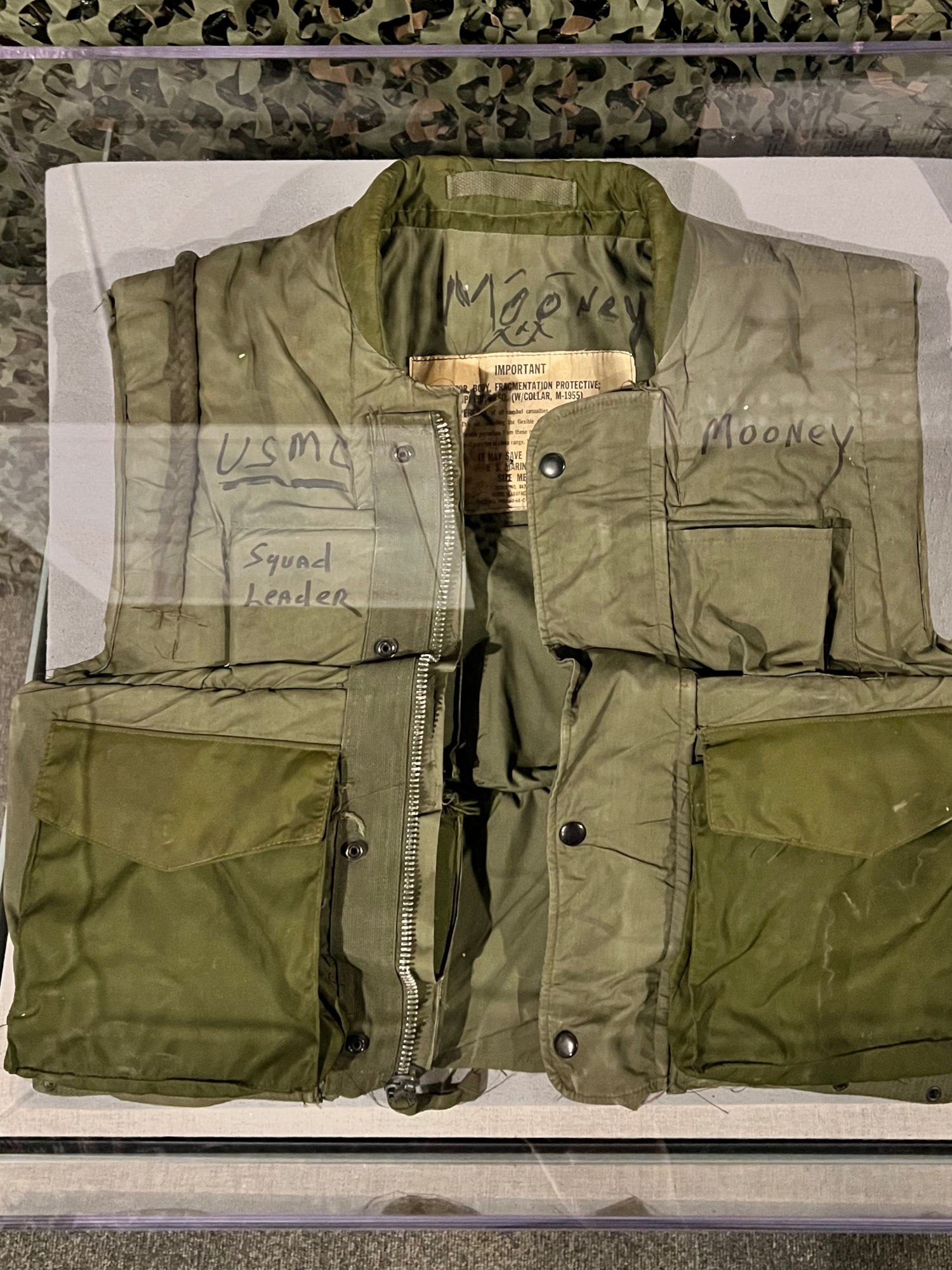
Flak Vest
Kien Hoa Province
This standard-issue United States Marine Corp M1955 flak vest belonged to Cpl. John Howard Mooney, who served with the 2nd Battalion, 7th Marines from 1966 to 1967. Cpl. Mooney was killed in action on January 1, 1967, in the Kien Hoa province of Vietnam.
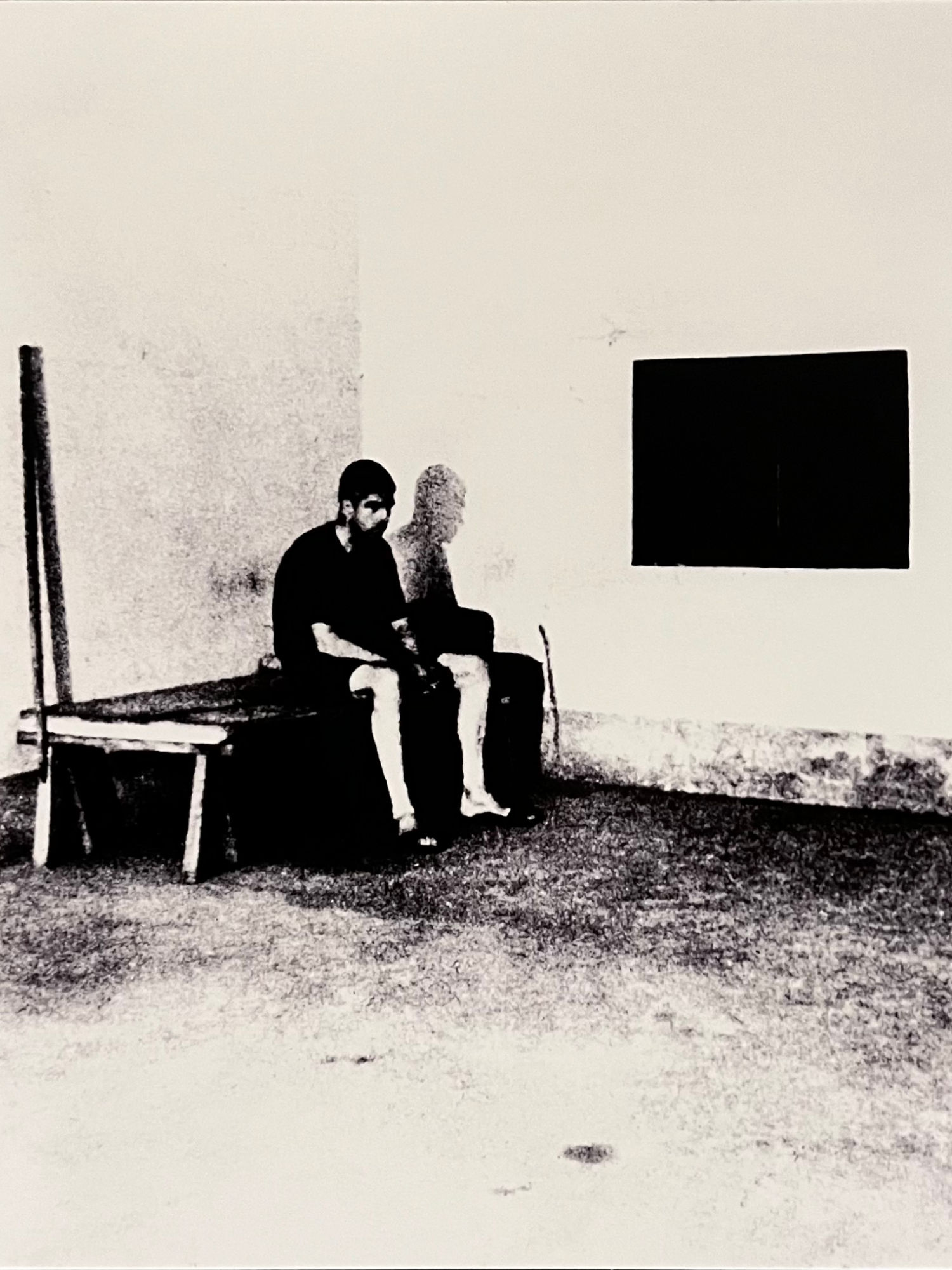
Richard Stratton
Solitary Confinement
Naval Aviator Lieutenant Commander Richard Stratton, like many of his fellow POWs, was subjected to isolation for months on end in solitary confinement.
- Shot Down January 5 1967
- POW 2,251 Days
- Released March 4, 1973
WIKIPEDIARichard Allen Stratton
He served as lieutenant commander during the Vietnam War from 1966 to 1973. He served on the USS Ticonderoga (CVA-14)/Air Wing 19/Attack Squadron VA-192. Richard flew 22 combat missions, earned two Air Medals and the Combat Action Ribbon. After capture by the North Vietnamese on January 5, 1967, he served with the Fourth Allied POW Wing, Hanoi, DRVN. He earned the Silver Star for his valor and leadership while a prisoner of war.On January 5, 1967, as part of an armed reconnaissance mission over Thanh Hoa Province, Stratton was flying an A-4 Skyhawk. The mission's aim was to bomb the My Trach ferry. When the ferry could not be found, Stratton spotted a set of barges one mile further upriver and rolled in to attack the craft with rockets. Stratton was forced to eject from his plane when he was shot down. He was captured shortly after parachuting to the ground.
Stratton was released on March 4, 1973, at Hanoi's Gia Lam Airport as part of the 2nd DRV Increment, Operation Homecoming, comprising 108 POWs on three flights. He had been a prisoner for 2,251 days.
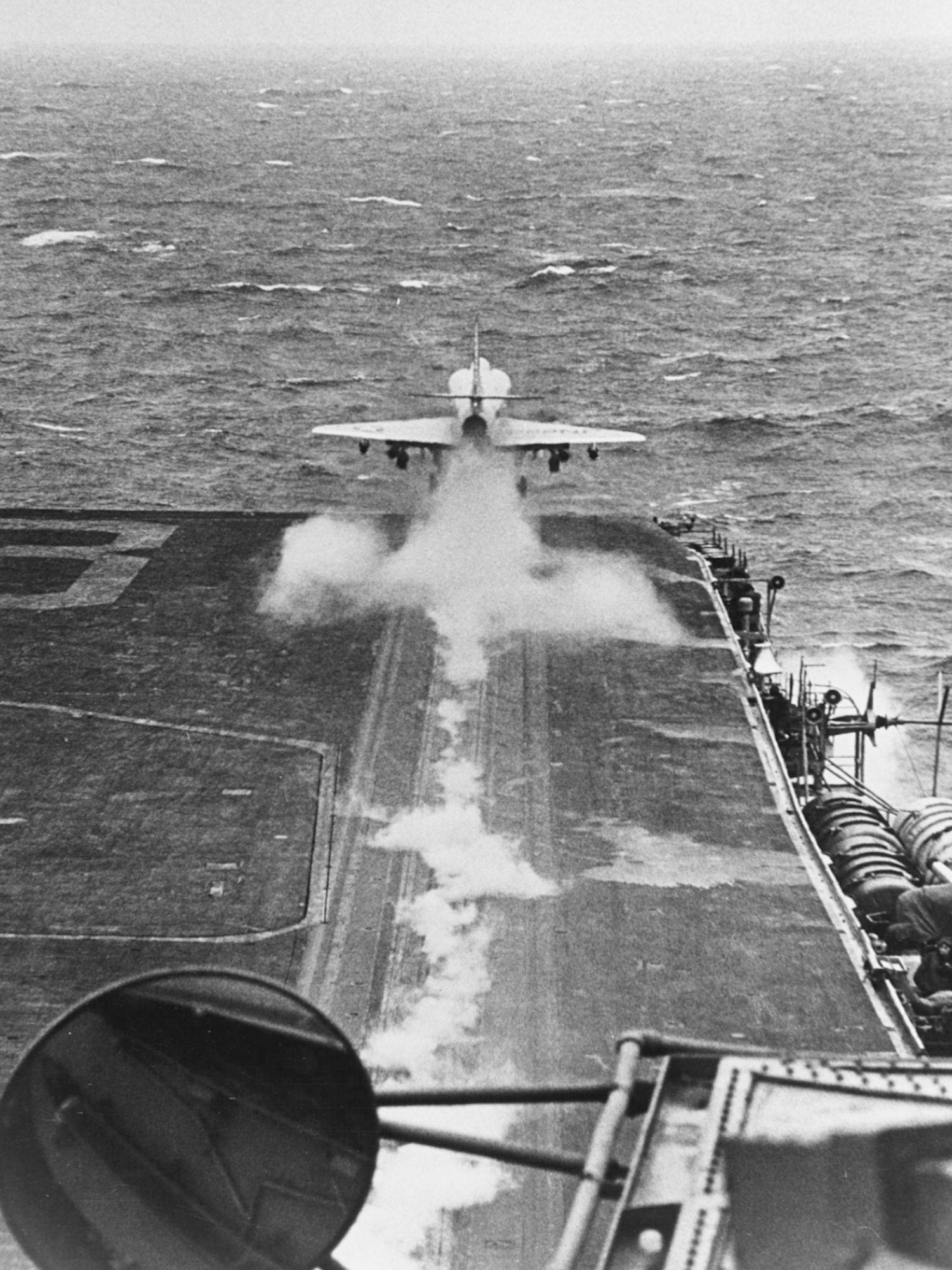
Naval Staging Ground
South China Sea
An A-4 Skyhawk leaves the deck of the USS Bon Homme Richard in the South China Sea, March 1967. The South China Sea was used as a naval staging ground for naval-based air strikes.
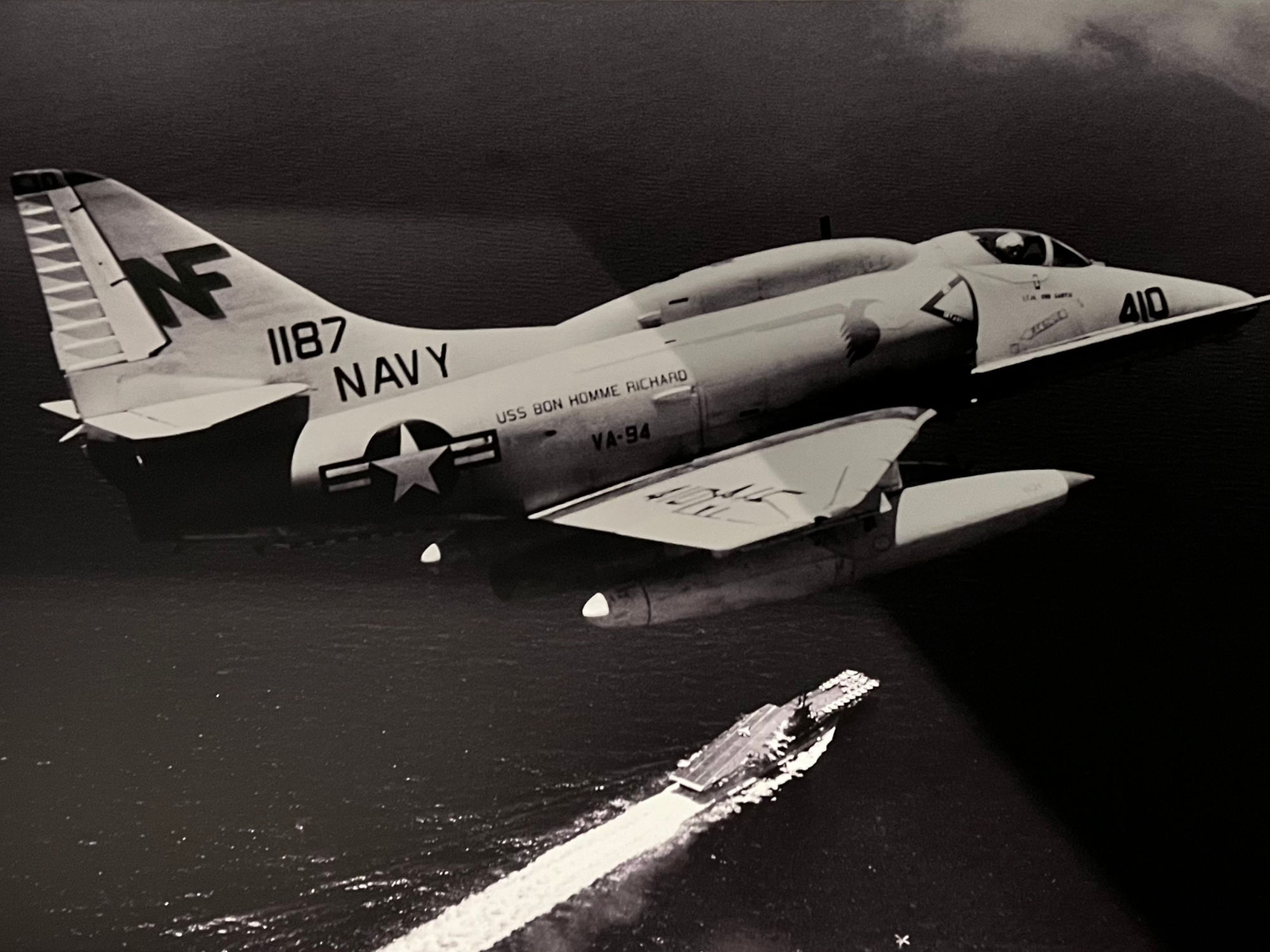
A-4 Skyhawk
South China Sea
A U.S. Navy A-4 Skyhawk over USS Bon Homme Richard.
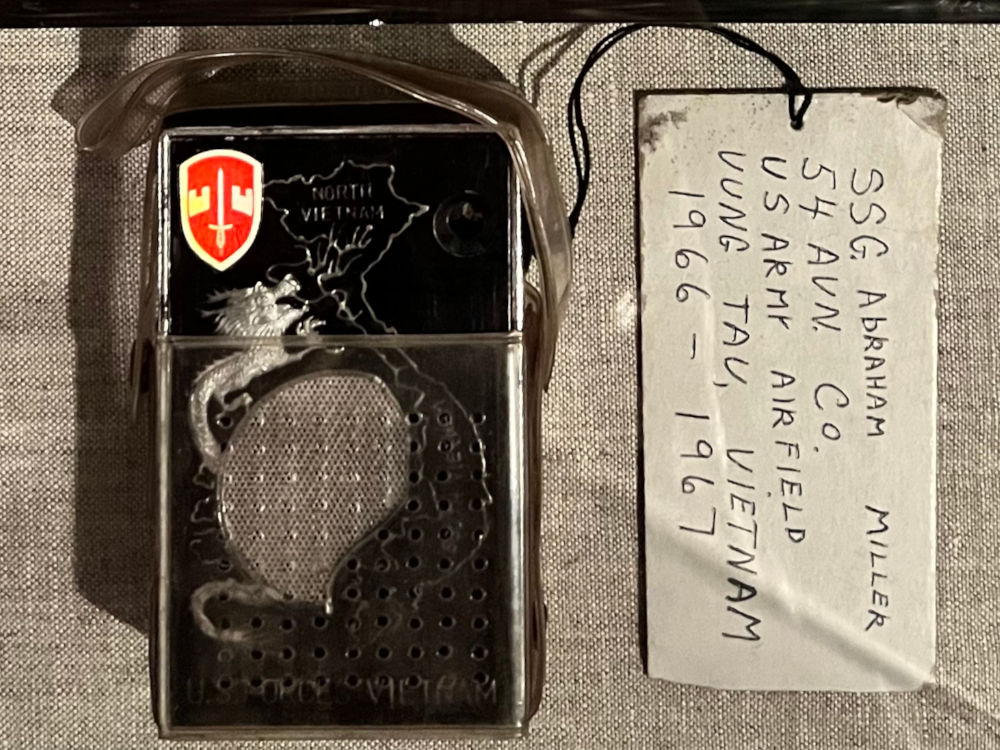
Abraham Miller
Transistor Radio
Transistor radio used by Staff Sergeant Abraham Miller during the Vietnam War while serving with the 54th Aviation Company from 1966 to 1967. Images on the front of the radio include a map of Vietnam, a dragon, and a shield of the Military Assistance Command - Vietnam. The bottom of the radio reads "U.S. Forces Vietnam."
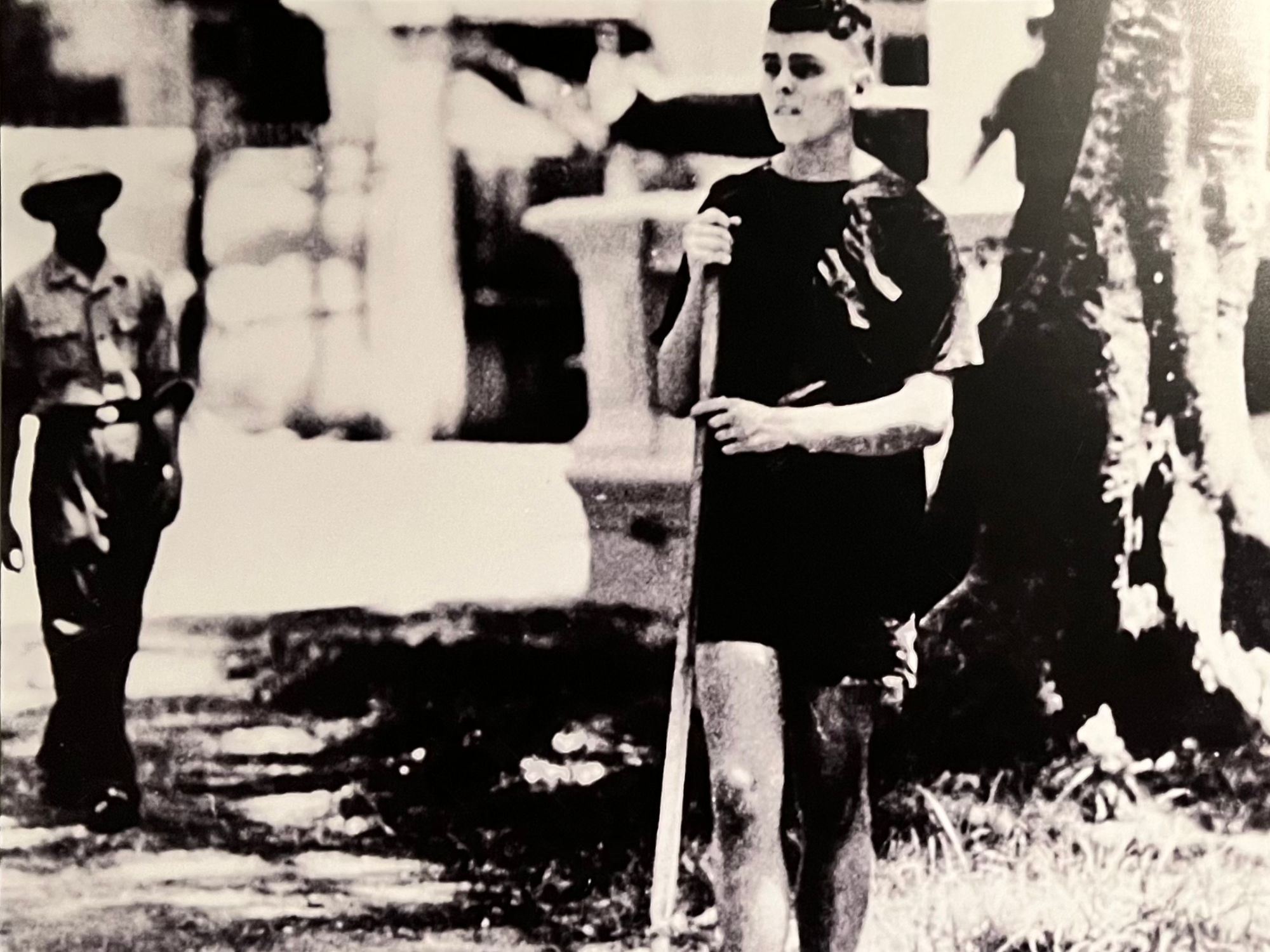
Douglas Hegdahl
Hanoi Hilton
U.S. Navy Petty Officer 2nd Class Douglas Hegdehl sweeps the courtyard of the "Hanoi Hilton".
WIKIPEDIADouglas Brent Hegdahl
Former United States Navy petty officer second class (E-5) who was held as a prisoner of war during the Vietnam War. After an early release, he was able to provide the names and personal information of about 256 fellow POWs, as well as reveal the conditions of the prisoner-of-war camp.Sometime in the early morning hours of April 6, 1967, 20-year-old Hegdahl was onboard the USS Canberra in the Gulf of Tonkin, three miles off the coast, when he was knocked overboard by the blast from a 5-inch gun mount. He swam and trod water until he was picked up several hours later by Vietnamese fishermen who treated him well. He was reported missing at the 11:30 a.m. ship's muster. After two searches of the ship, he was officially listed as "missing as a result of lost at sea." Later that day, Hegdahl was handed over to Vietnamese militiamen who clubbed him with their rifles before moving him to the infamous "Hanoi Hilton" prison.
The interrogators first believed that Hegdahl was a commando or an agent. His story of being blown overboard seemed unbelievable to the interrogators. Hegdahl thought he would be much better off if he pretended to be of low intelligence. He pretended to be unable to read or write and incapable of learning to read and write. Eventually he came to be known to the Vietnamese as "The Incredibly Stupid One", and he was given nearly free run of the camp.
Then, with the help of Joseph Crecca, a U.S. Air Force officer and fellow prisoner, Hegdahl memorized names, capture dates, method of capture, and personal information of about 256 other prisoners. Among other methods, he used the children's song Old MacDonald Had a Farm, repeated constantly, to retain the data.
Hegdahl was one of three POWs (along with Navy Lieutenant Robert Frishman and Air Force Captain Wesley Rumble) who were released on August 5, 1969, as a propaganda move by the North Vietnamese
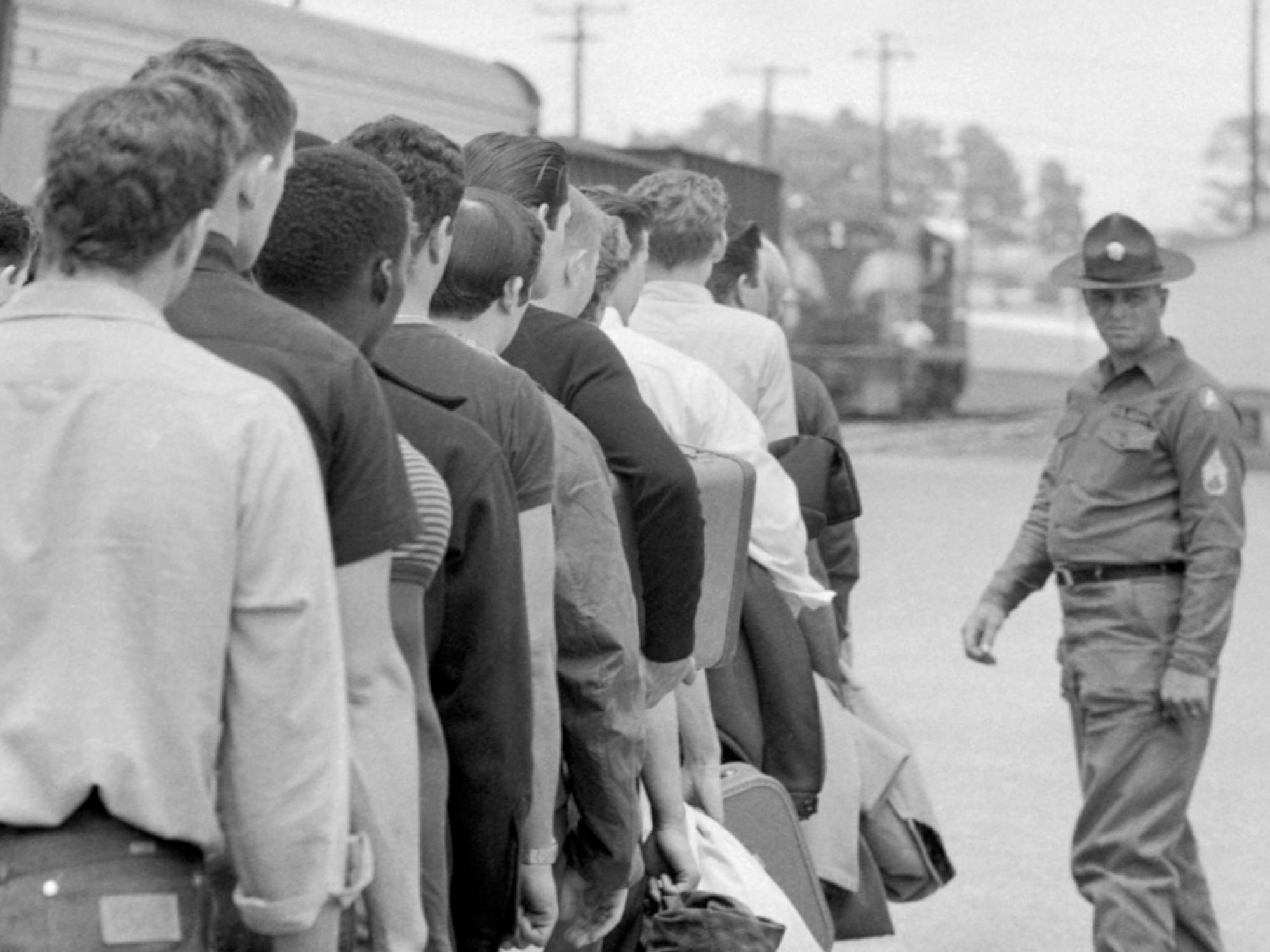
Draftees
Fort Jackson, South Carolina
Draftees line up for processing at Fort Jackson, South Carolina in May 1967.

Paul Galanti
Hanoi Hilton
U.S. Navy Commander Paul Galanti discreetly gives the interviewers the middle finger as he is forced to appear in a film for propaganda purposes.
WIKIPEDIAPaul Edward Galanti
Served on active duty from 1962 to 1982, he was a Prisoner of War from 1966 to 1973 during the Vietnam War.Following completion of advanced jet training in November 1963, he became a jet flight instructor in Pensacola as a Selective Retrained Graduate (SERGRAD) of flight training. The following year, he completed fleet replacement training in the A-4 Skyhawk at Attack Squadron 125 (VA-125) at Naval Air Station Lemoore, California. In November 1964, he joined Attack Squadron 216 (VA-216), home based at NAS Lemoore. The squadron was part of a carrier air wing aboard the aircraft carrier, USS Hancock, which departed for Southeast Asia in November 1965. Galanti flew 97 combat missions in his A-4C Skyhawk before being shot down and captured on June 17, 1966. He remained a prisoner of war of the North Vietnamese for nearly seven years and was released on February 12, 1973.
Galanti's decorations from his time in the Navy include the Silver Star, combat awards of two Legions of Merit and the Bronze Star Medal, nine combat Air Medals, and two Purple Hearts.
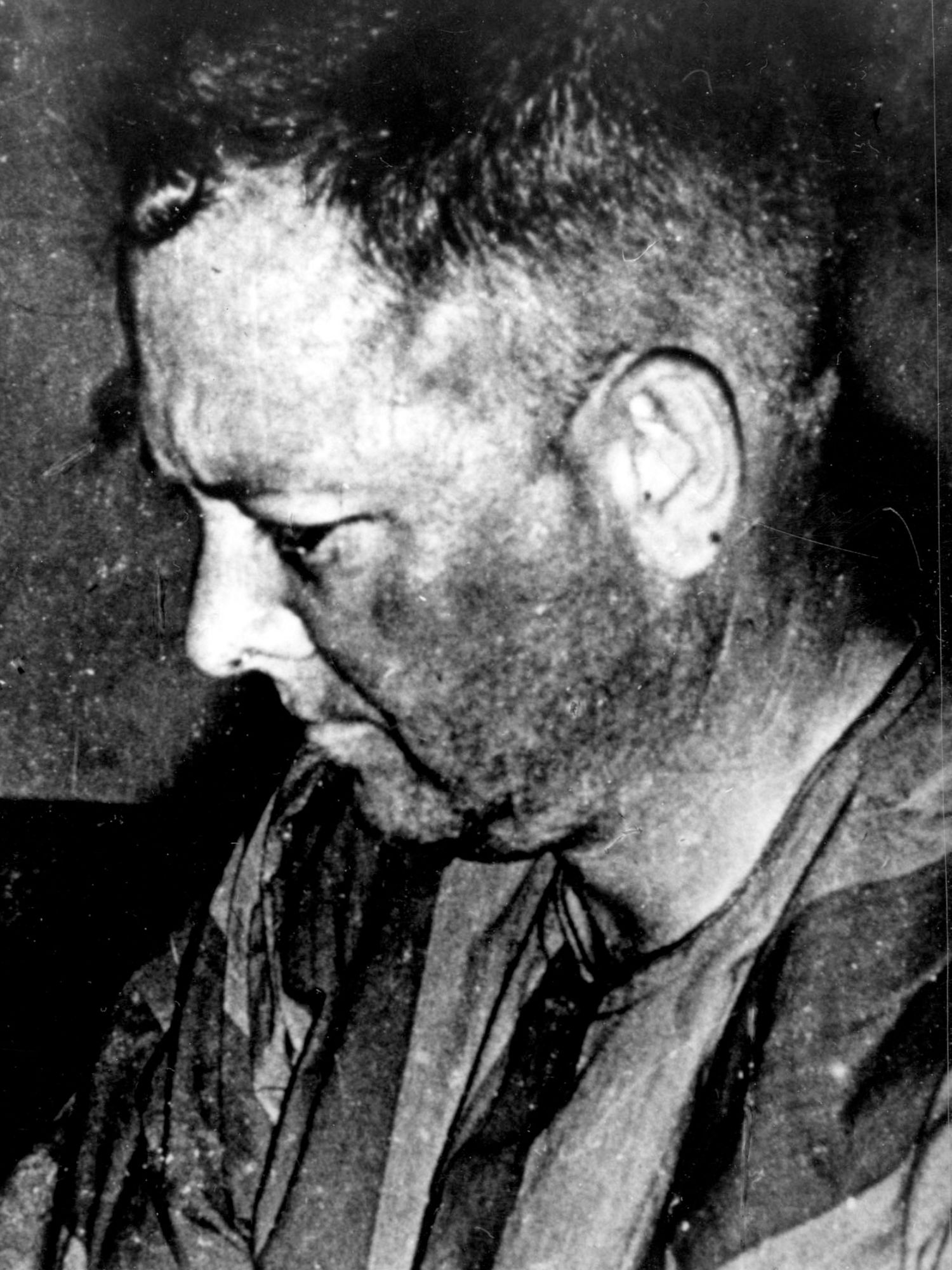
Edwin Atterberry
RF-4C Reconnaissance Aircraft Shot Down near Gia Lam North Vietnam
U.S. Air Force Captain Edwin Atterberry, captured August 12, 1967. He was beaten to death in captivity for trying to escape camp Cu Loc (The Zoo) on the outskirts of Hanoi May 18, 1969.
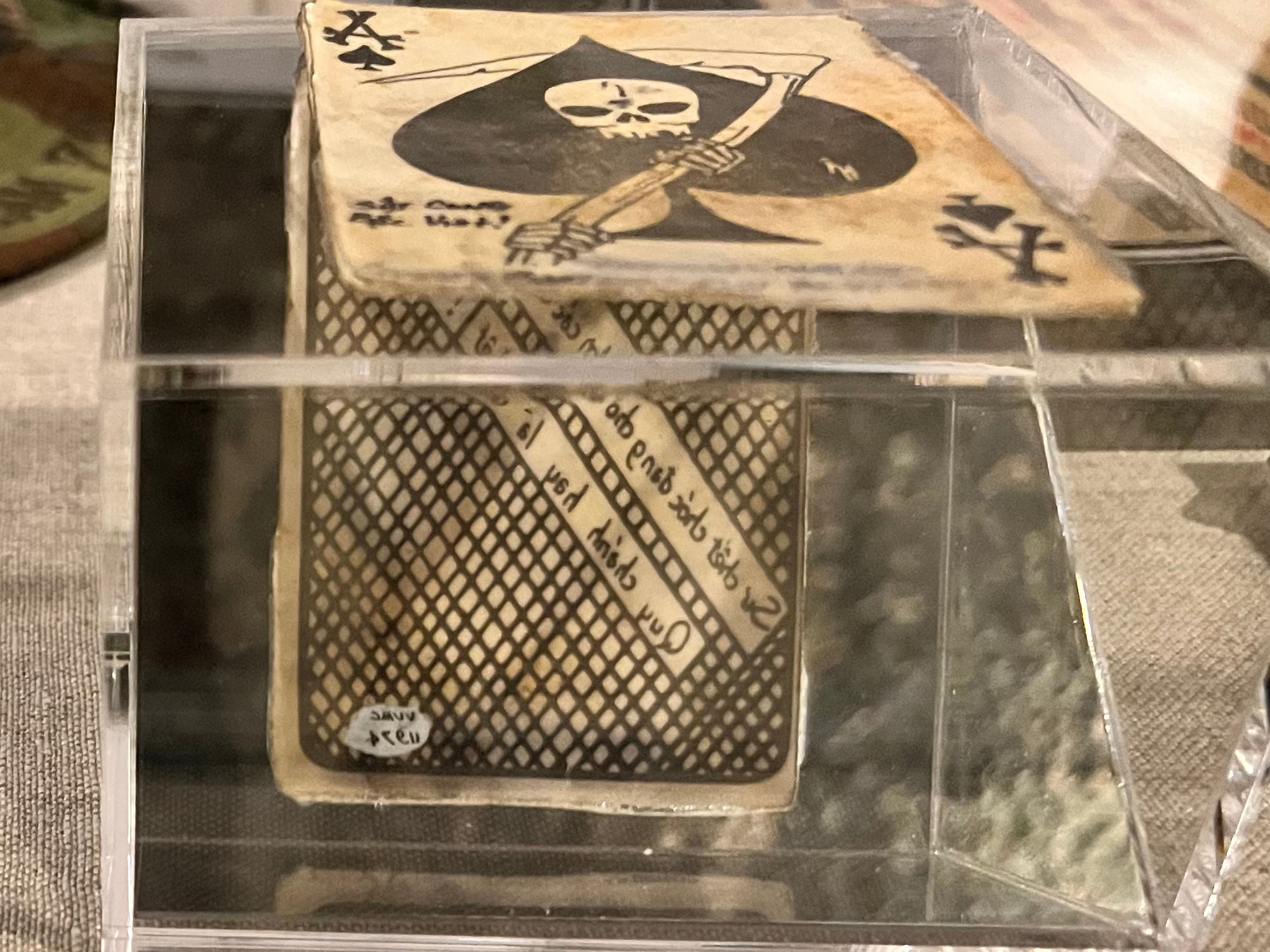
Death Card
Ace of Spades
This Ace of Spades playing card features a skull and crossbones surrounded by a black spade. The front of the card is inscribed,
Sandman, keep on getting 'em.
I only met you twice, but admired you a lot.
Cards like these were often referred to as death cards and were issued to U.S. soldiers as part of psychological warfare. A death card would be placed on a fallen combatant as a warning to other enemies.
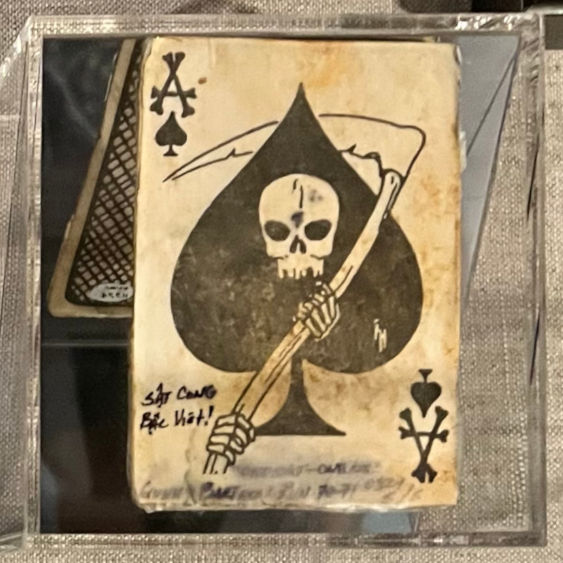
WIKIPEDIADuring the Vietnam War
The ace of spades was used as a tool of psychological warfare as it was common practice by US soldiers to leave the ace card on the bodies of killed Vietnamese.They thought that the card's connections to French colonial rule of Vietnam and putative symbolism in Vietnamese tradition to mean death and ill-fortune would frighten and demoralize Viet Cong soldiers.
This custom was said to be so common that the United States Playing Card Company was asked by Charlie Company, 2nd Battalion, 35th Infantry Regiment to supply crates of that single card in bulk. The plain white tuck cases were marked "Bicycle Secret Weapon", and the cards were deliberately scattered in villages and in the jungle during raids.
The ace of spades, while not a symbol of superstitious fear to the Viet Cong forces, did help the morale of American soldiers. Some U.S. soldiers and Marines were reportedly sticking this card in their helmet band as a sort of anti-peace sign.
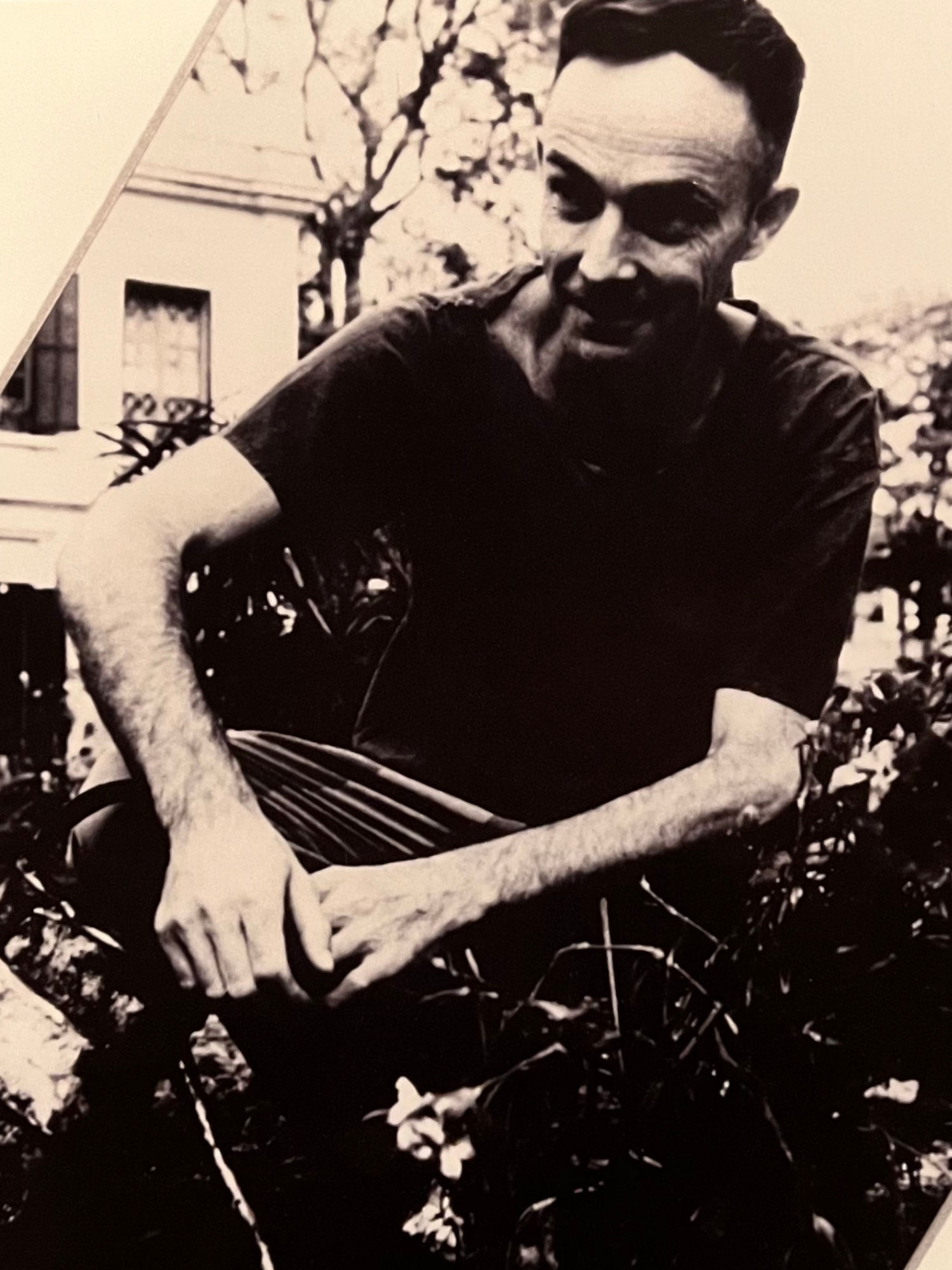
Hugh Stafford
His A-4 downed by a Surface to Air Missile over Haiphong
U.S. Navy Lieutenant Commander Hugh Stafford, who was shot down on August 31, 1967, suffered a serious injury to his left arm. Denied proper medical care, his arm atrophied, becoming visibly thinner than his right arm.
The Best and the Brightest?
In late 1972, journalist David Halberstam published The Best and the Brightest. The book spent more than 35 weeks on the New York Times Best Seller list. It explored how leaders who were thought to be among the most capable and intelligent men in the country could have led the United States into the quagmire of Vietnam.
RELATED: [https://www.amazon.com/dp/B01NAJELJ3]
Halberstam's tells a tragic story of the senior leaders and advisors chosen by President Kennedy and retained by President Johnson.
What was it about the men, their attitudes, the country, its institutions and above all the era which had allowed this tragedy to take place... They had been heralded as the ablest men to serve this country in this century.
- David Halberstam, The Best and the Brightest
In the years since the book was published the phrase, "the best and the brightest," has been viewed as ironic. How could the best and the brightest create misguided Vietnam policy?
Thirty years later, former Vietnam POW Senator John McCain wrote,
In the end, they had more confidence than vision, and that failing bred in them a fateful hubris. No irony here, but a classic tragedy.
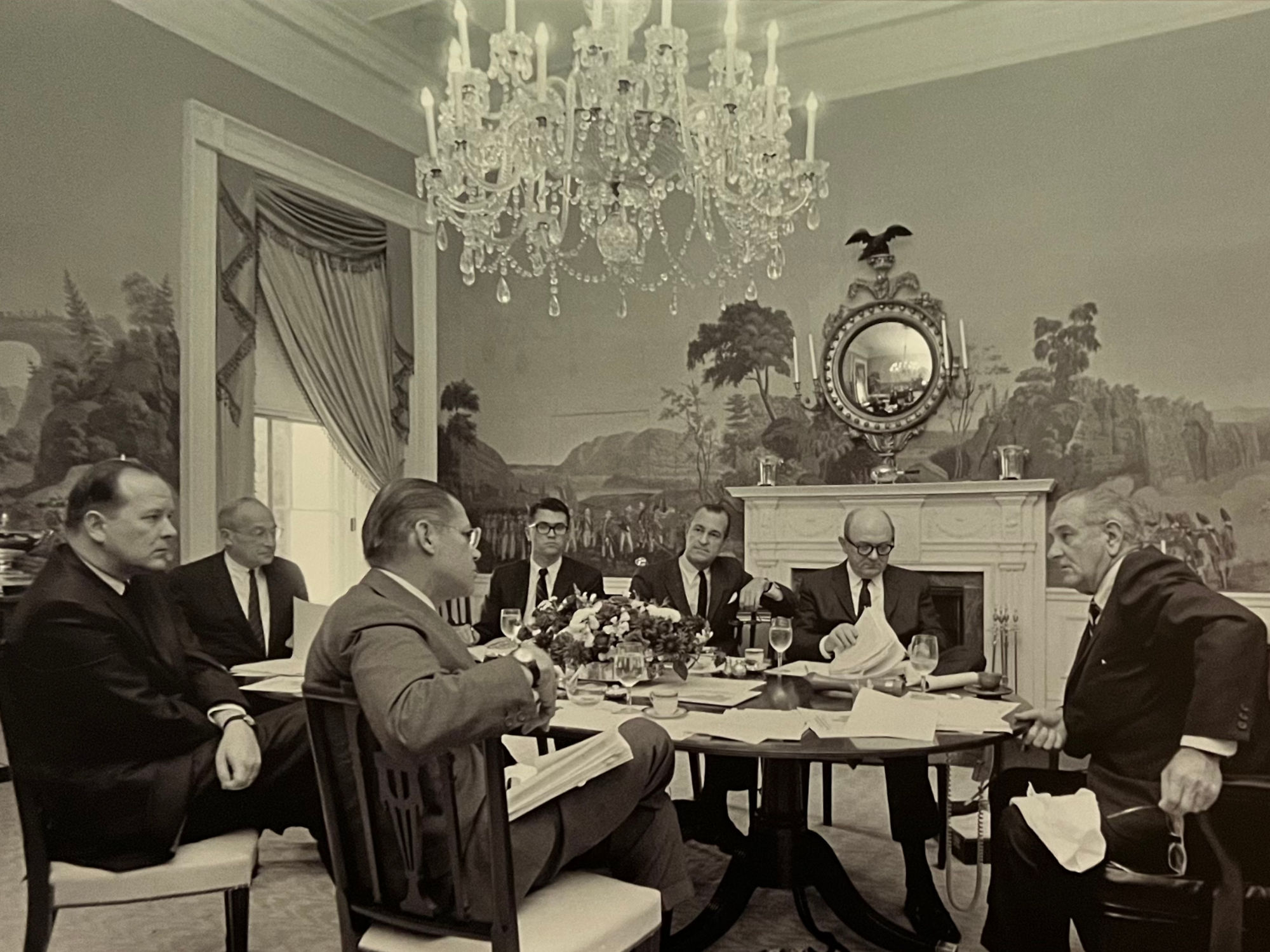
Foreign Policy Advisers
White House Dining Room
President Johnson meets at the White House with senior advisors, October 11, 1967.
- Press Secretary George Christian
- Walt Rostow
- Secretary of Defense Robert Mcnamara
- Assistant Press Secretary Tom Johnson
- Cia Director Richard Helms
- Secretary of State Dean Rusk
- President Lyndon B. Johnson
The League of Wives
Frustrated with what they felt was the Johnson administration's lack of attention for their husbands and for the plight of the POWs' families, a small group of Navy wives decided to organize. In October 1967, they established the League of Wives of American Vietnam Prisoners of War.
Under the leadership of Sybil Stockdale, the League soon became a force to be reckoned with. With a name, stationery, and bank account, the League was able to get more attention from the federal government than the women had individually.
The election of a new president in 1968 gave the members of the League hope that a new administration would be more responsive to their concerns. The wives wasted no time after President Nixon took office to make themselves known.
The League swamped the White House with telegrams urging the U.S. government to make the plight of POWs and MIAs a top priority.
The League now had the personal attention of the President of the United States. President Nixon made the return of the POWs a non-negotiable requirement for ending the war.
WIKIPEDIAThe National League of Families of American Prisoners and Missing in Southeast Asia
The National League of POW/MIA Families' origins date to groups created by Sybil Stockdale and a group of POW/MIA wives in 1966 in Coronado, California. Sybil Stockdale's husband, Navy Commander James Stockdale, was shot down in 1965 and she was determined to make the American people aware of the mistreatment of U.S. POWs. Years later Evelyn Grubb became involved because she was frustrated with the lack of information from federal officials. It was these groups that finally convinced the U.S. government to change their official stance on the POW/MIA issue in 1969. The National League of Families was incorporated nationally in 1967 and later in Washington, D.C., on May 28, 1970.
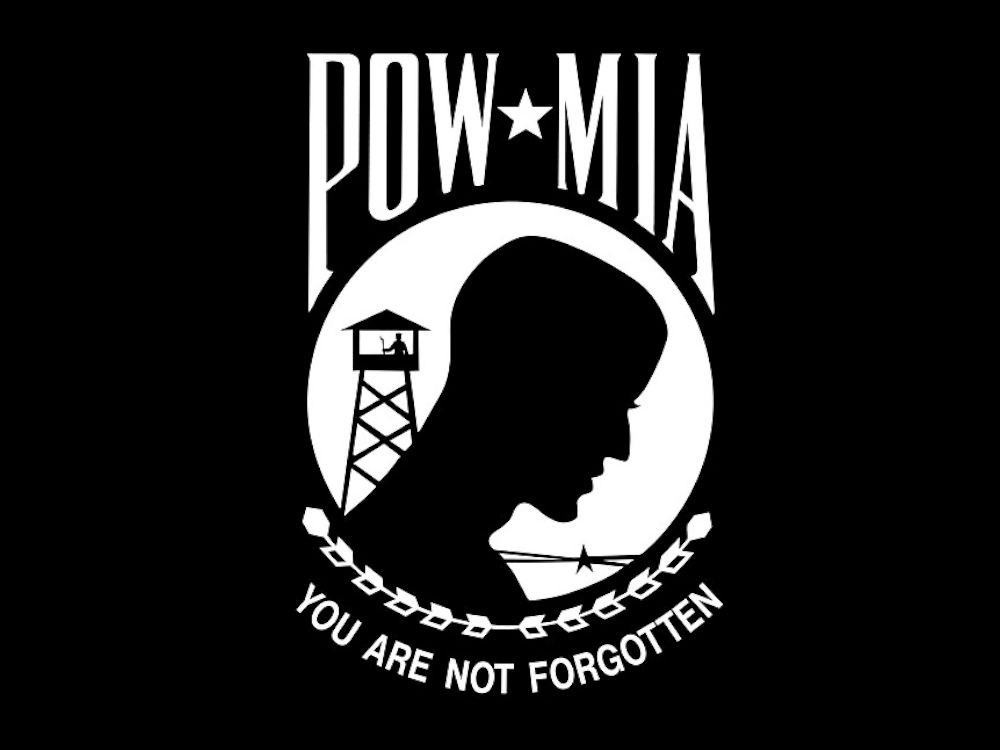
POW/MIA Flag
Then-League President and POW wife Evelyn Grubb oversaw the development of the now-famous National League of Families' POW/MIA flag in January 1972.
WIKIPEDIAAs of 2026
1,575 U.S. servicemen are still listed as Missing in Action in the Vietnam War
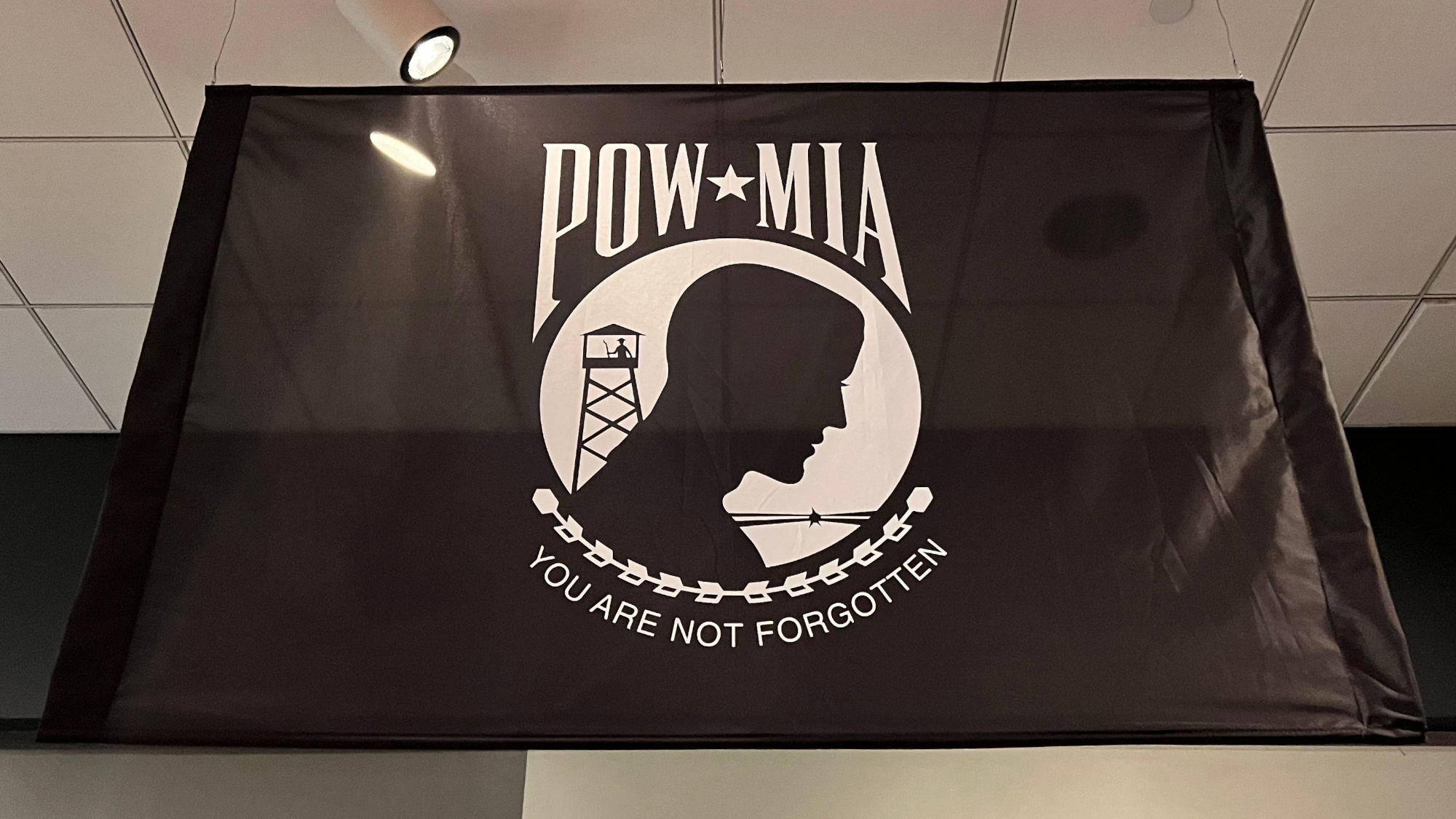
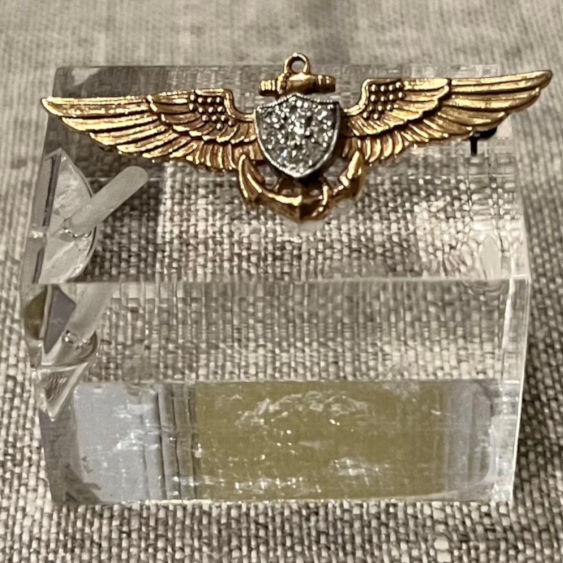
Sweetheart Pin
Sybil Stockdale
Sweetheart pins are worn by significant others of military personnel and depict the regimental or service crest of the respective soldier, sailor, or airman. This pin worn by Sybil Stockdale resembles a Naval Aviator badge.
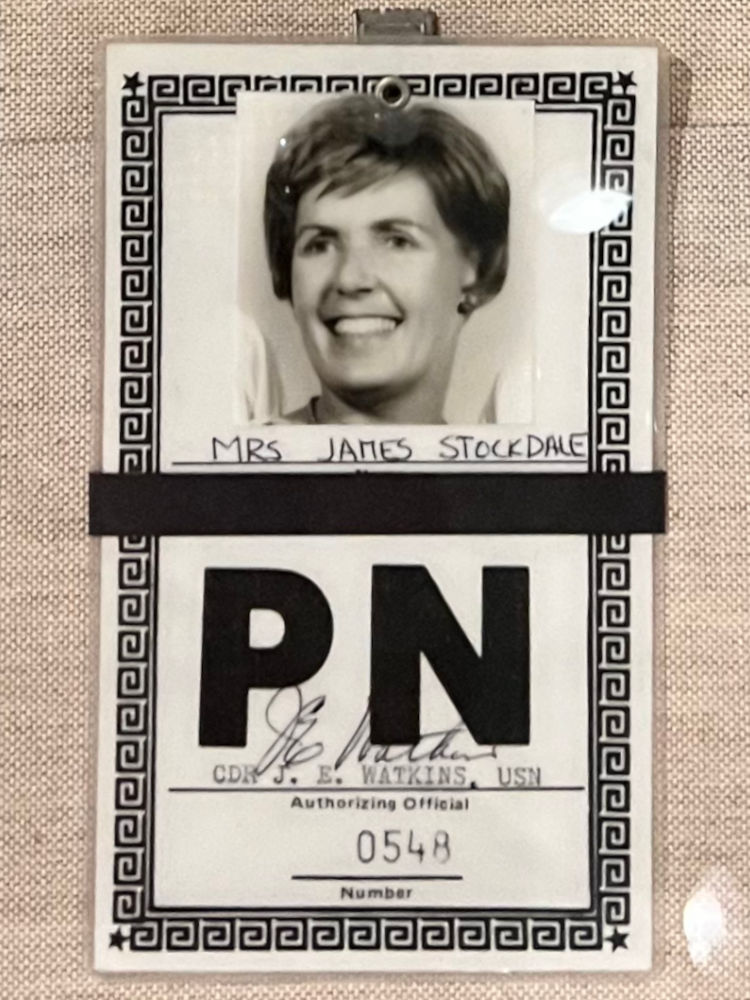
Sybil Stockdale
Hospital Visitor Badge
Sybil Stockdale helped found the National League of Families of American Prisoners and Missing in Southeast Asia, which is credited with helping end the use of torture on prisoners. The organization also helped end the U.S. Government's "keep quiet" policy, which asked POW wives to not talk about their husbands' captivity. For her efforts, Sybil Stockdale was awarded the Distinguished Public Service Award.
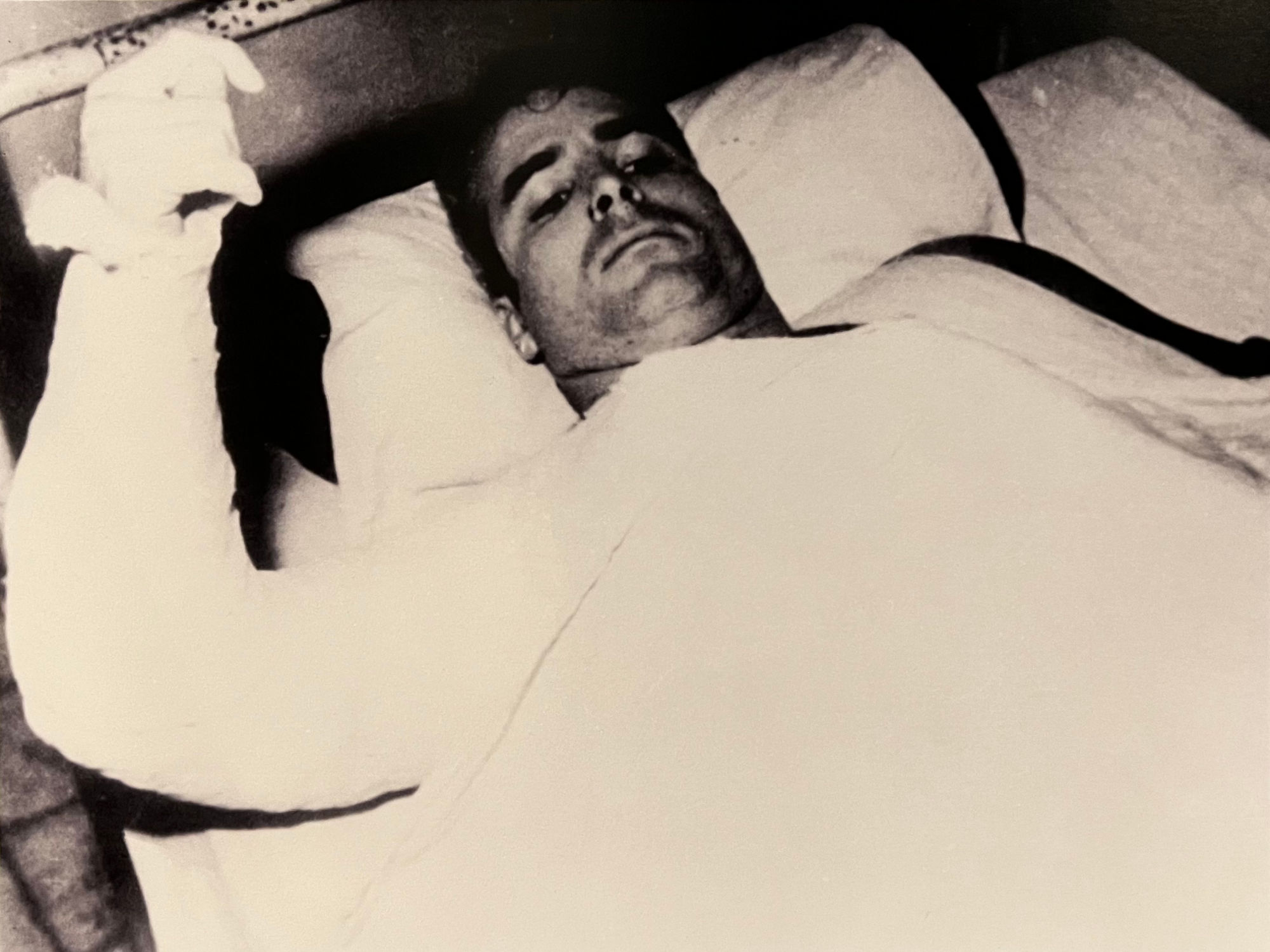
John McCain
Hanoi Hilton
Future United States Senator John McCain lays on a Hanoi Hilton medical cot with his arms in a cast. He had limited use of his arms for the rest of his life.
WIKIPEDIAJohn Sidney McCain III
McCain graduated from the U.S. Naval Academy in 1958 and received a commission in the U.S. Navy. He became a naval aviator and flew ground-attack aircraft from aircraft carriers. During the Vietnam War, he almost died in the 1967 USS Forrestal fire. While on a bombing mission during Operation Rolling Thunder over Hanoi in October 1967, McCain was shot down, seriously injured, and captured by the North Vietnamese. He was a prisoner of war until 1973. McCain experienced episodes of torture and refused an out-of-sequence early release. He sustained wounds that left him with lifelong physical disabilities. McCain was a prisoner of war in North Vietnam for five and a half years, until his release on March 14, 1973. McCain retired from the Navy as a captain in 1981 and moved to Arizona.McCain was taken prisoner of war on October 26, 1967. He was flying his 23rd bombing mission over North Vietnam when his A-4E Skyhawk was shot down by a missile over Hanoi. McCain fractured both arms and a leg when he ejected from the aircraft, and nearly drowned after he parachuted into Truc Bach Lake. Some North Vietnamese pulled him ashore, then others crushed his shoulder with a rifle butt and bayoneted him. McCain was then transported to Hanoi's main Hoa Lo Prison, nicknamed the "Hanoi Hilton"
Although McCain was seriously wounded and injured, his captors refused to treat him. They beat and interrogated him and he was given medical care only when the North Vietnamese discovered that his father was an admiral. His status as a prisoner of war (POW) made the front pages of major American newspapers.
McCain spent six weeks in the hospital, where he received marginal care. He had lost 50 pounds, he was in a chest cast, and his gray hair had turned white. McCain was sent to a different camp on the outskirts of Hanoi. In December 1967, McCain was placed in a cell with two other Americans, who did not expect him to live more than a week. In March 1968, McCain was placed in solitary confinement, where he remained for two years.
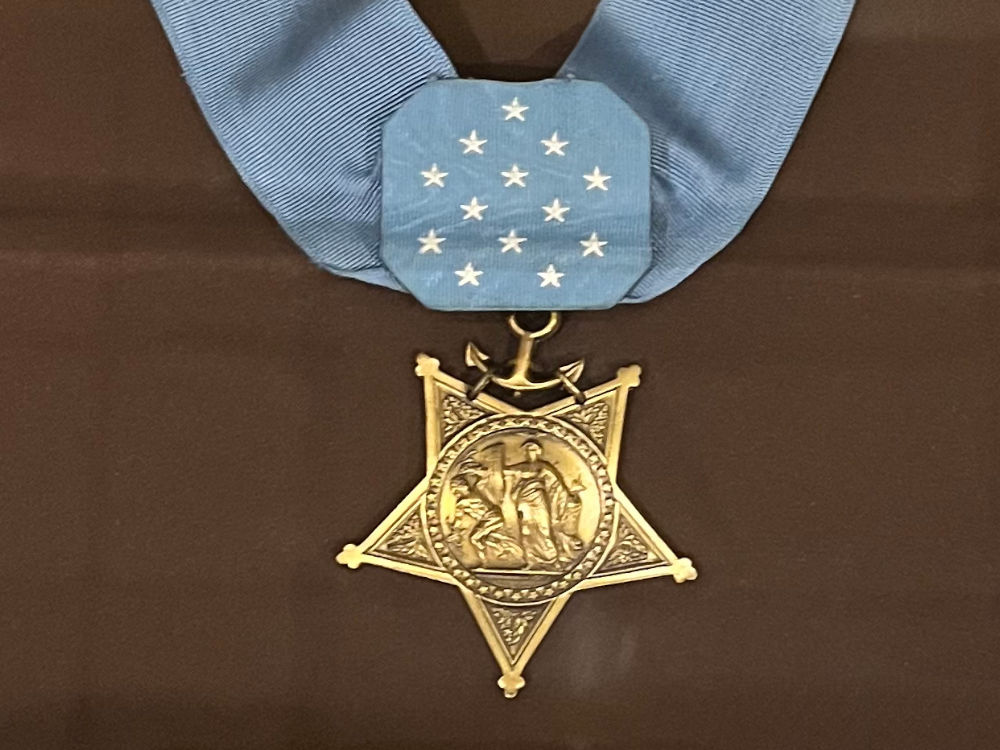
Donald Cook
Congressional Medal of Honor
Colonel Donald Cook was posthumous awarded the Congressional Medal of Honor for his gallantry and intrepidity while interned as a POW.
Colonel Cook prioritized the needs of other inmates, often at the cost of his own health, by giving them his personal drug and medicine allowance. His strict adherence to the Code of Conduct earned him the respect of not only his fellow POWs, but his captors as well. According to the Provisional Revolutionary Report list given to the U.S. in 1973, Donald Cook died of malaria on December 8, 1967.
Glasses of Donald Cook
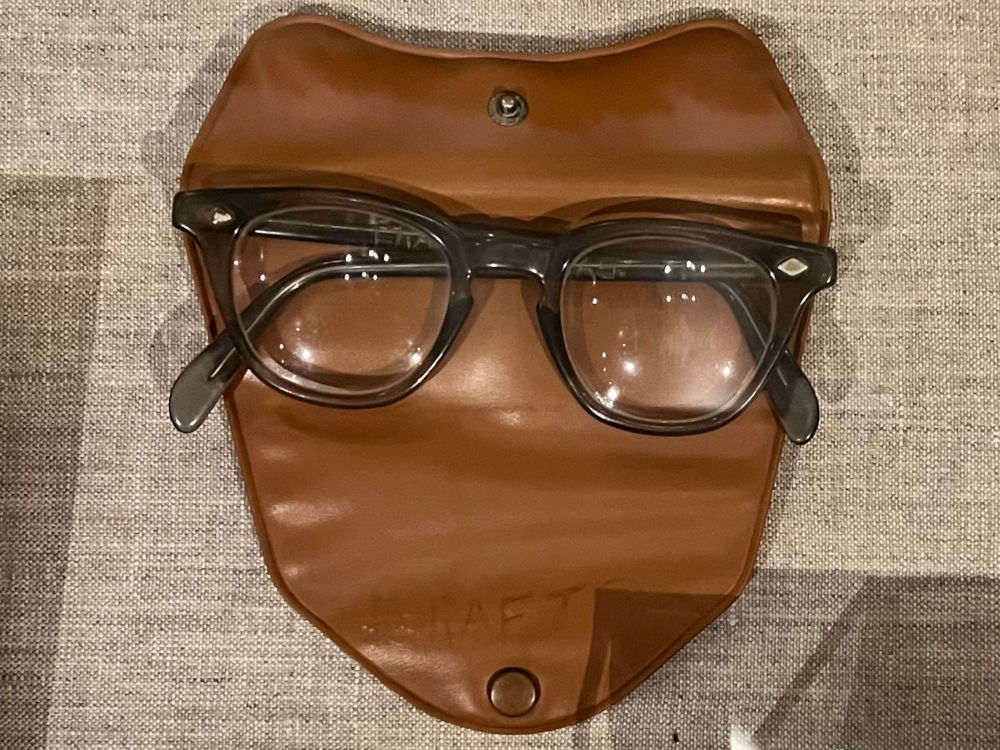
WIKIPEDIADonald Gilbert Cook
United States Marine Corps officer and a Medal of Honor recipient.In 1956 he enlisted in the Marine Corps as a private but was quickly sent for officer training at the Officer Candidates School in Quantico, Virginia.
- He was commissioned a second lieutenant in 1957.
- In 1960 he attended Army Language School in Monterey, California, studying Chinese and graduated near the top of his class.
- Lieutenant Cook was assigned to Camp H.M. Smith, Hawaii, in 1961 and was promoted to captain on March 1, 1962.
- He held a series of assignments in the Marine Corps and was sent to South Vietnam in late 1964, where he served as an advisor to the Vietnamese Marine Division until he was wounded and captured by the Viet Cong several weeks later.
He was held as a prisoner of war by the Viet Cong from December 31, 1964, until his death from malaria at age 33 on December 8, 1967, and was buried in the U Minh forest swamp by his fellow prisoners.
Cook's remains have never been recovered from the swamp and are now lost.
Christmas in Hanoi
In the North Vietnamese prison camps Christmas did not go unnoticed by the POWs or their captors. Captain Ted Ballard spent seven Christmases imprisoned. His essays, Christmas in the Dungeons of North Vietnam, recall each of those Christmas Days.
The POWs were given small gifts by their guards, such as an orange, cookie, or a few small pieces of candy. The POWs secretly exchanged small gifts they cobbled together and wrote Christmas cards to each other. One year they staged a version of the Charles Dickens classic, A Christmas Carol.
Their Christmas meal would be the best they received all year, but it was hardly a feast. In 1967, Ballard wrote,
Christmas Day we had a good dinner of meat, vegetables, and rice. In quantity it was about the size of an average American meal, but about six times our normal ration.
The Vietnamese tried to use Christmas for propaganda purposes, staging photographs that suggested that their prisoners were enjoying a festive holiday. But no one was fooled by their efforts. It was obvious by the men's gaunt and haggard appearance that they were being treated very poorly the other 364 days of the year.
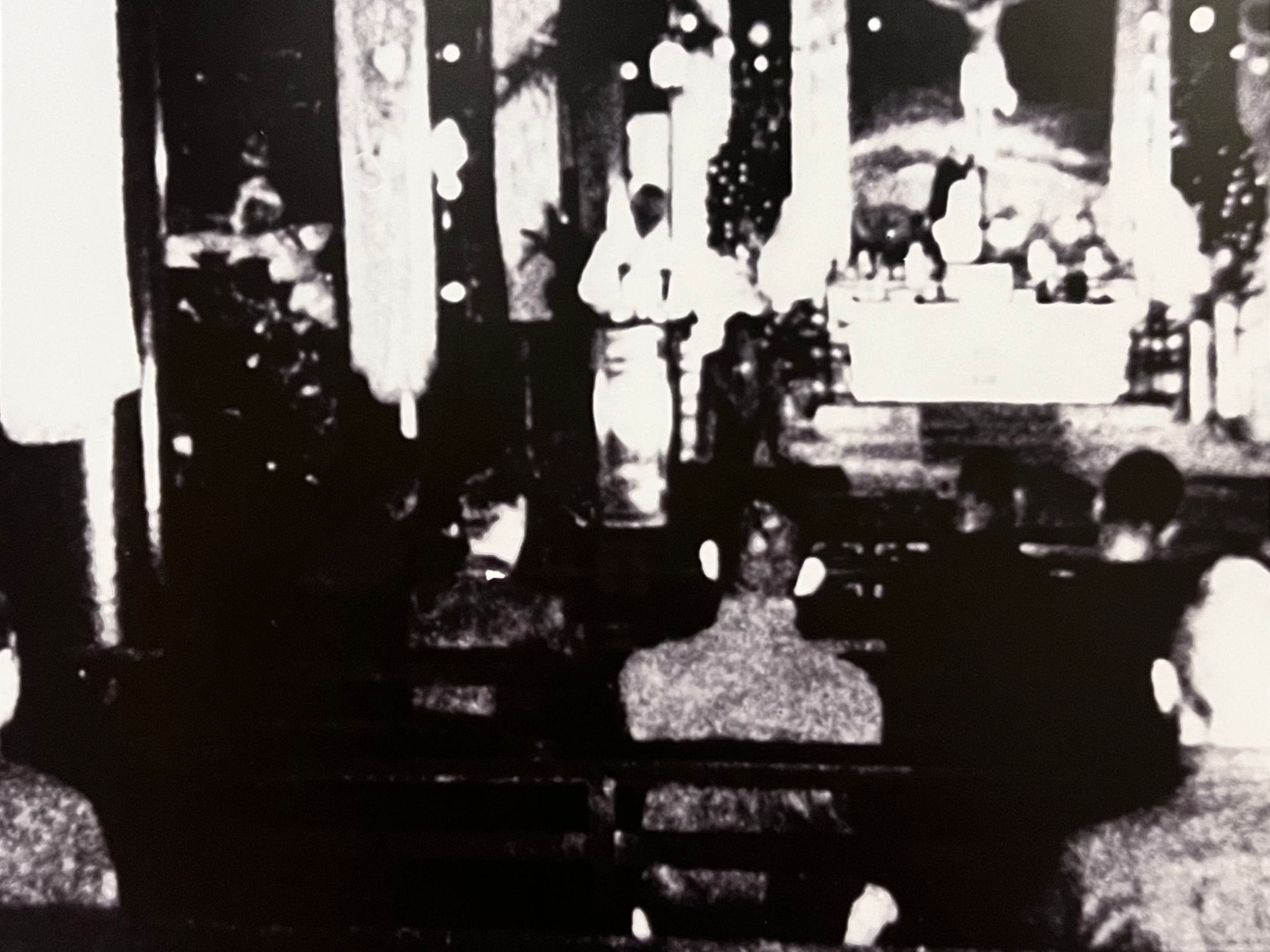
Christmas Catholic Mass
POWs gather to create a makeshift Catholic Mass in celebration of Christmas. While such celebrations were rare and simple in nature, they did a lot to boost morale.
Torture
Man's Inhumanity to Man
North Vietnam violated their 1957 agreement to abide by the Geneva Conventions, which prohibits the torture of POWS.
At dawn two Vietnamese officers casually strolled in. I told them they might kill me, but I still wasn't interested in their propaganda. They laughed and calmly said, "It's easy to die but hard to live, and we'll show you just how hard it is to live." - Lieutenant Thomas Moe, U.S. Air Force
Torture was physical and psychological. It was designed to extract military information from the POWs, get them to participate in anti-American propaganda, force them to confess to being war criminals, and break their will to resist their captors.
The methods of torture were incredibly brutal. A prisoner's arms and legs would be forcibly dislocated and then left in that condition. They were kept in iron leg stocks for days or weeks or even months. They would be subjected to long periods of interrogation and indoctrination, while forced to stand for hours on end. They would be put in solitary confinement for weeks at a time. Beaten for the slightest infraction of prison rules, some were even beaten to death.
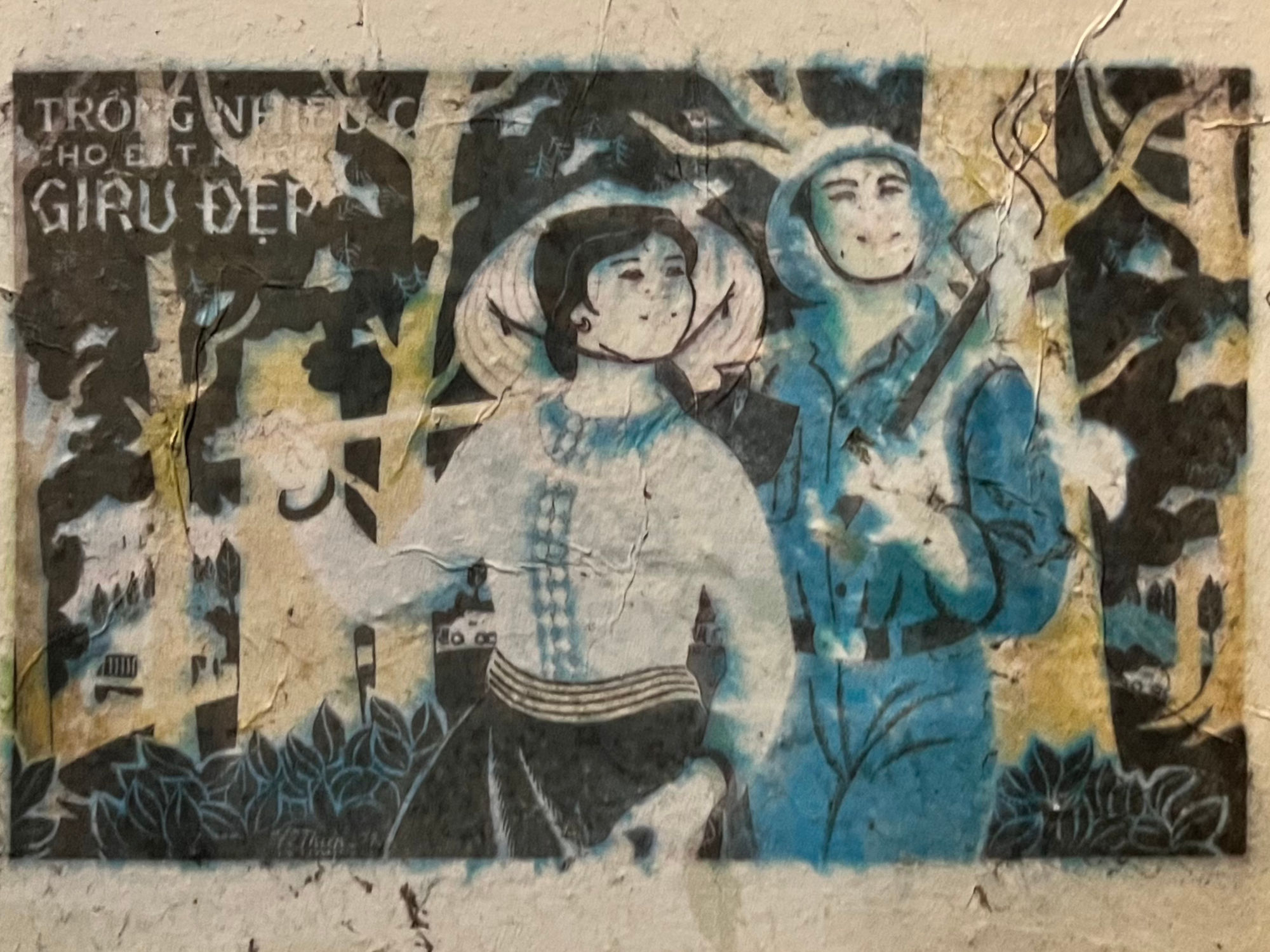
Propaganda Poster
Planting Trees for the rich and beautiful country
WIKIPEDIAAgent Orange
Operation Ranch Hand was a U.S. military operation during the Vietnam War, lasting from 1962 until 1971. Largely inspired by the British use of chemicals (Agent Orange) during the Malayan Emergency in the 1950s, it was part of the overall herbicidal warfare program during the war called "Operation Trail Dust".Ranch Hand involved spraying an estimated 19 million U.S. gallons of defoliants and herbicides over rural areas of South Vietnam in an attempt to deprive the Viet Cong of food and vegetation cover. Areas of Laos and Cambodia were also sprayed to a lesser extent.
- The "Ranch Handers" motto was "Only you can prevent a forest"
- During the ten years of spraying, over 5 million acres of forest and 500,000 acres of crops were heavily damaged or destroyed. Around 20% of the forests of South Vietnam were sprayed at least once.
- A plane sprayed a swath of land that was 260 feet wide and 9.9 miles long in about 4 1/2 minutes, at a rate of about 3 U.S. gallons per acre.
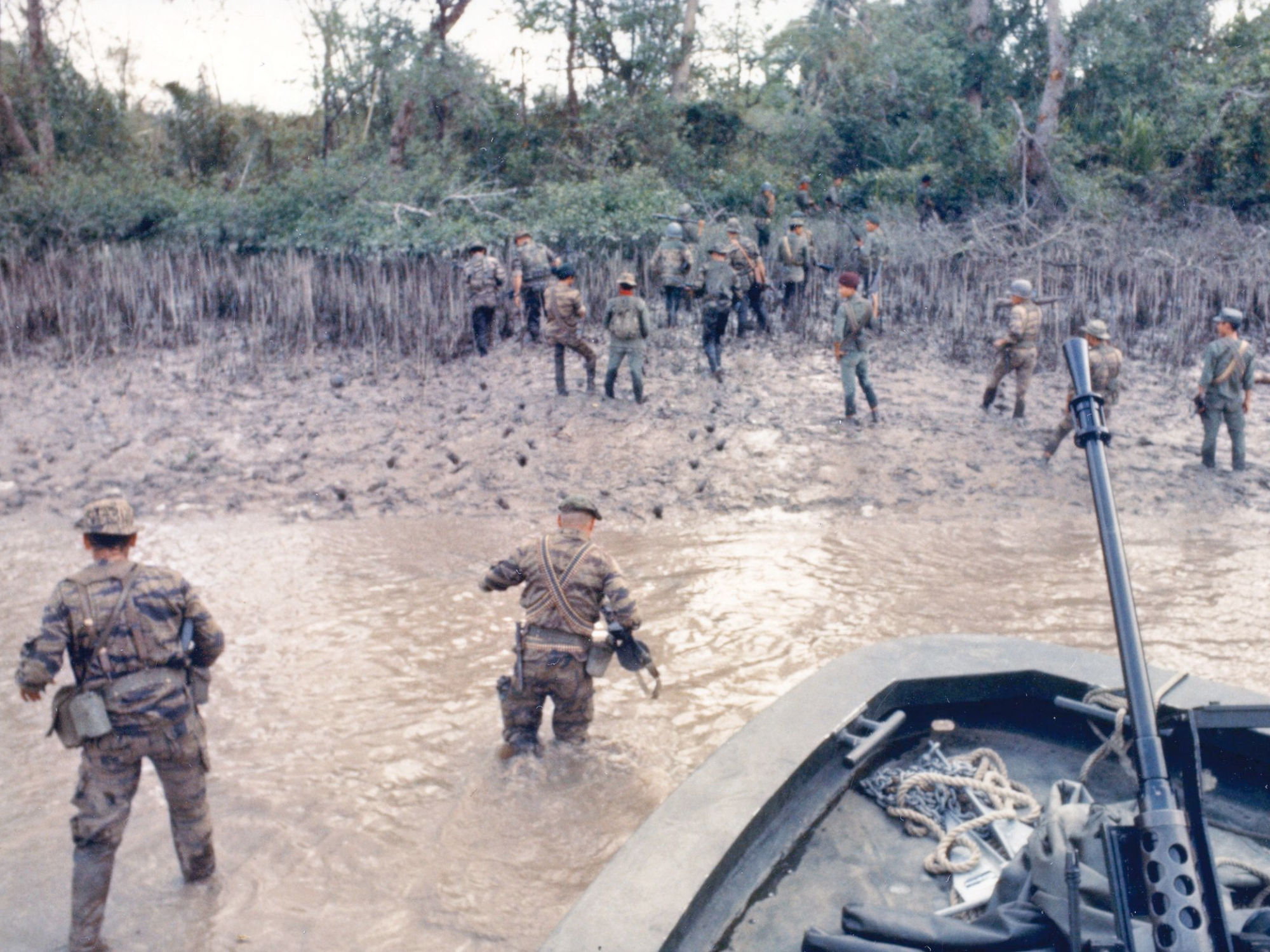
Operation Bold Dragon III
Tan Dinh Island in the Mekong Delta
U.S. Navy SEALs and South Vietnamese soldiers disembark from a patrol boat for an assault on Viet Cong positions during Operation Bold Dragon III.
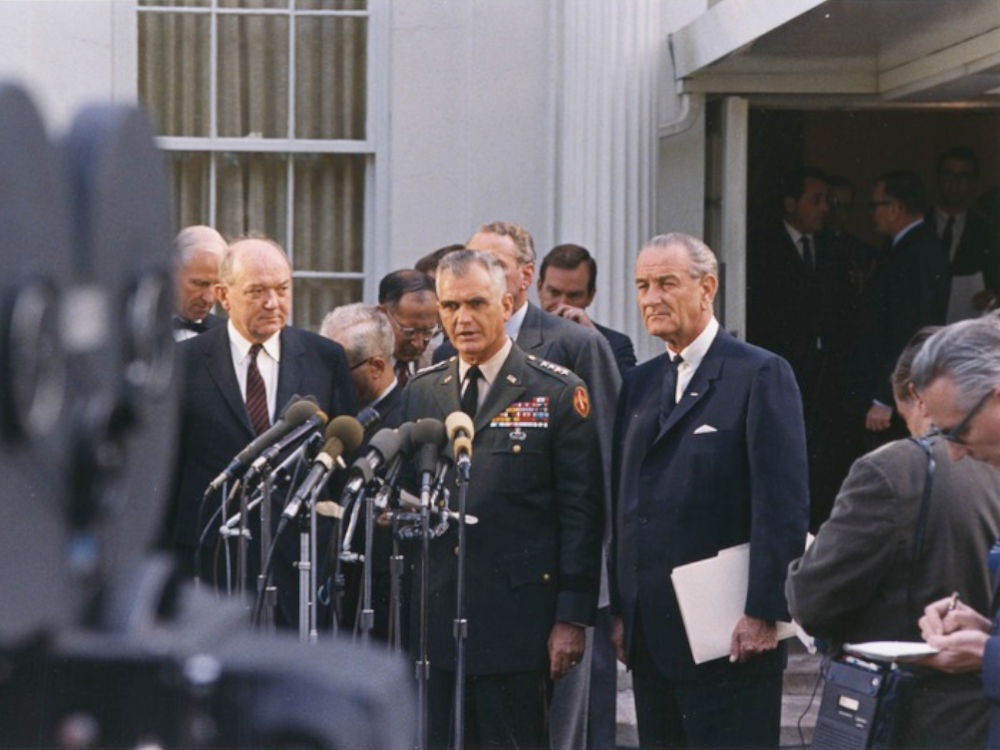
President Lyndon B. Johnson
Failed Tet Offensive
President Johnson and General William Westmoreland address reporters on April 4, 1968. Westmoreland being reassigned from U.S. Military Commander in Vietnam to Army Chief of Staff after failed Tet Offensive.
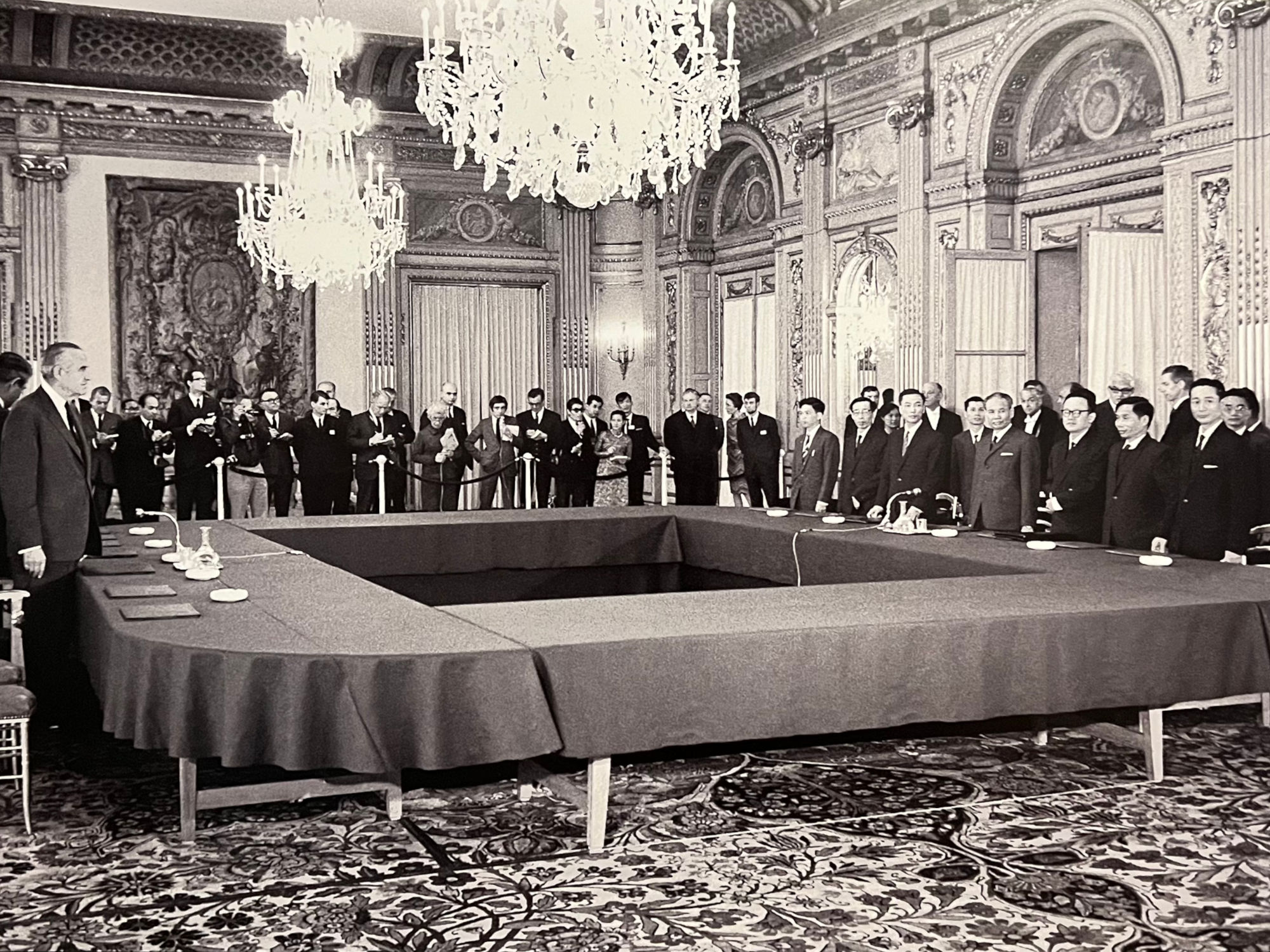
Paris Peace Talks
Paris, France
American and North Vietnamese negotiators open peace talks in Paris, France on May 13, 1968.
- On The Left: Chief U.S. Negotiator William Averell Harriman
- On The Right: The North Vietnamese Delegation
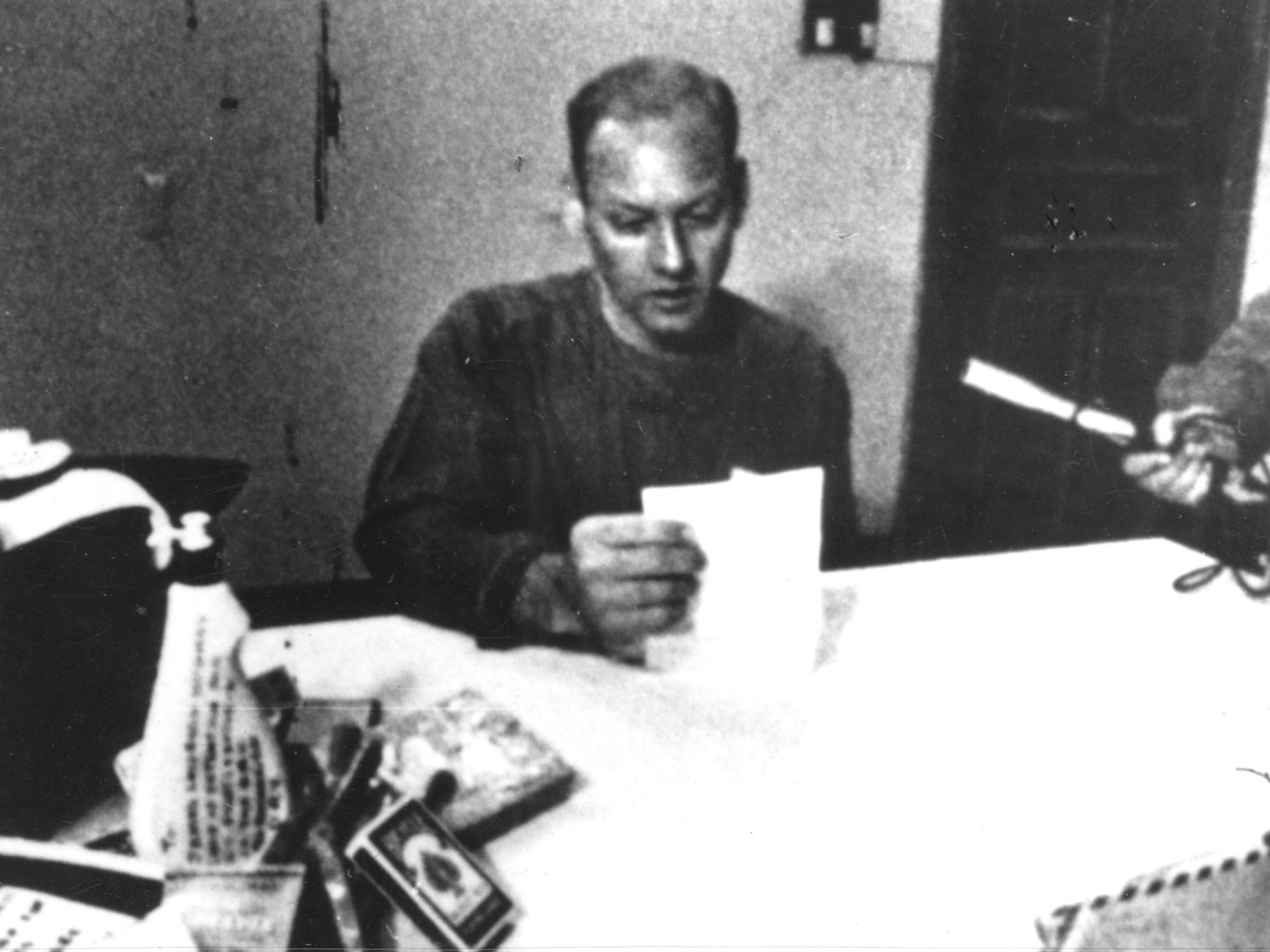
Propaganda
Hanoi Hilton Hoa Lo Prison
U.S. Air Force Major Roger Ingvalson reads Christmas cards he received as part of a North Vietnamese propaganda film. His wife, Jacqueline, died from multiple sclerosis complicated by pneumonia while he was held as a POW.
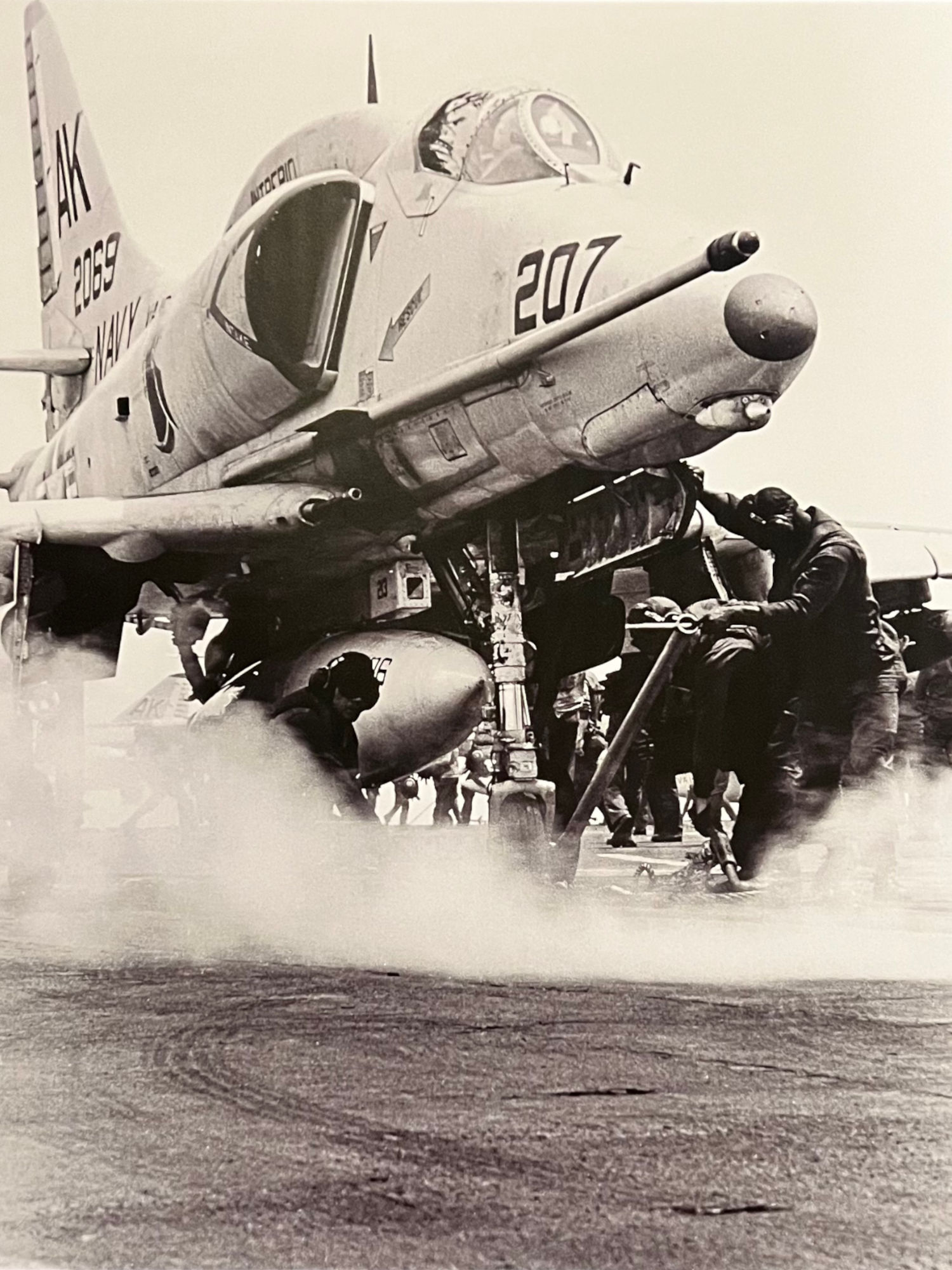
A-4F Skyhawk
Gulf of Tonkin
An A-4F Skyhawk is brought to the launching position on a steam catapult aboard USS Intrepid in the Gulf of Tonkin, September 1968. Such catapult systems were used to help accelerate a plane to adequate lift-off velocity.
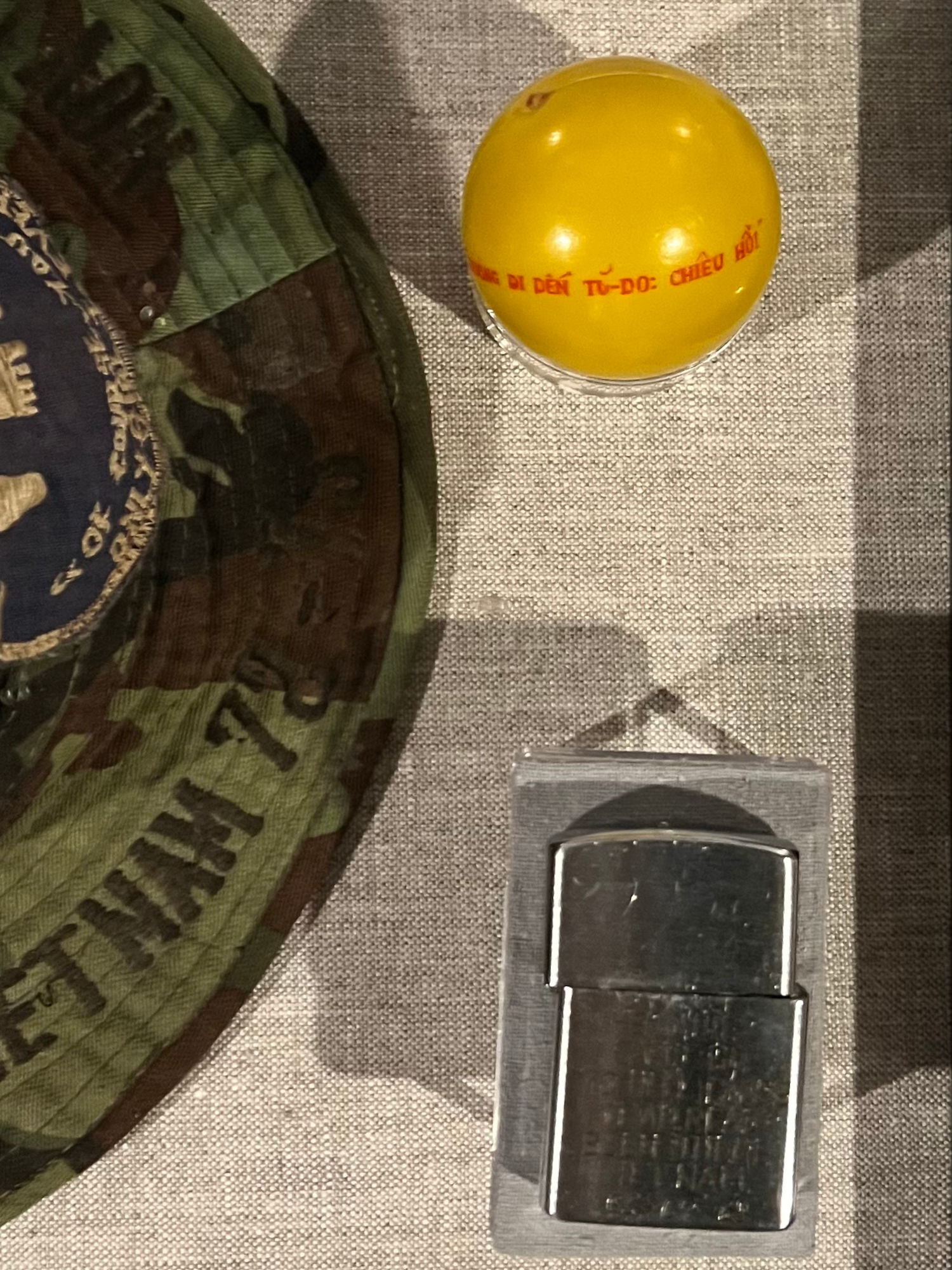
Psyops Yellow Plastic Ball
The Road to Freedom: Chieu Hoi
Psychological operations (PSYOPS) are performed to sway the beliefs and actions of foreign governments and individuals. Approximately 60,000 of these plastic balls were delivered to USMC helicopter squadrons stationed in Vietnam. The hope was that local children would find and show these balls to their parents, who would be swayed by the message printed on them. The phrase "Duong Di Den To-Do: Chieu Hoi" roughly translates to "Come over to our side."
A Different Kind of Peace
The military and political objectives of the United States in Vietnam were unlike those in both World War I and World War II. In those wars, the United States and its allies sought absolute victory over their enemies.
- World War I "The War to End All Wars," officially concluded on June 28, 1919 with the signing of the Treaty of Versailles.
- World War II The United States entered World War Il in December 1941, following the surprise attack on Pearl Harbor. In response, President Franklin D. Roosevelt asked Congress for a declaration of war against Japan. Germany and Italy, Japan's Axis allies, then declared war on the United States.
RELATED: [https://www.eatlife.net/wwii.php]- World War II ended in Europe on May 8, 1945, with Germany's surrender.
- World War II ended in the Pacific on September 2, 1945, when Japan signed the instrument of surrender on the deck of the battleship USS Missouri in Tokyo Bay.
In Vietnam, the United States did not seek the surrender of Hanoi.
Similar to the Korean War, the United States sought a negotiated peace which would leave Vietnam divided. North Vietnam would be governed by communists. South Vietnam would be anti-communist. This had a decided effect on America's military strategy.
The United States should seek a negotiated end to the war. Our goal should not be a military victory in the conventional sense, not unconditional surrender by the other side, but a durable peace.
Richard Nixon, Nixon on the Issues, 1968
Negotiating the Shape of the Negotiating Table
- May 1968
Representatives of the United States and North Vietnam met in Paris, France to begin negotiations to end the war. South Vietnam was not included in these initial talks. - October 31, 1968
In a televised nationwide address, President Johnson announced the halt of all bombing of North Vietnam by the United States. - November 6, 1968
Just six days later, he also announced that South Vietnam and the National Liberation Front (NLF) would be "free to participate" at the next scheduled meeting between the United States and North Vietnam. The NLF was a communist political organization. Its military arm, the Viet Cong, was supported by the North Vietnamese government. - November 8, 1968
Two days later, the South Vietnamese government said it would not participate in the expanded talks. It opposed the inclusion of the NLF because it was not a national government. - November 26, 1968
The South announced that it was "prepared to participate" in talks, even with the NLF participating.
Both the United States and South Vietnam objected to a square table. They did not want the NLF to appear to be on equal footing with the three governments.
- January 16, 1969
After weeks of talks the four parties agreed the negotiations would take place at a circular table, unadorned with flags or nameplates.
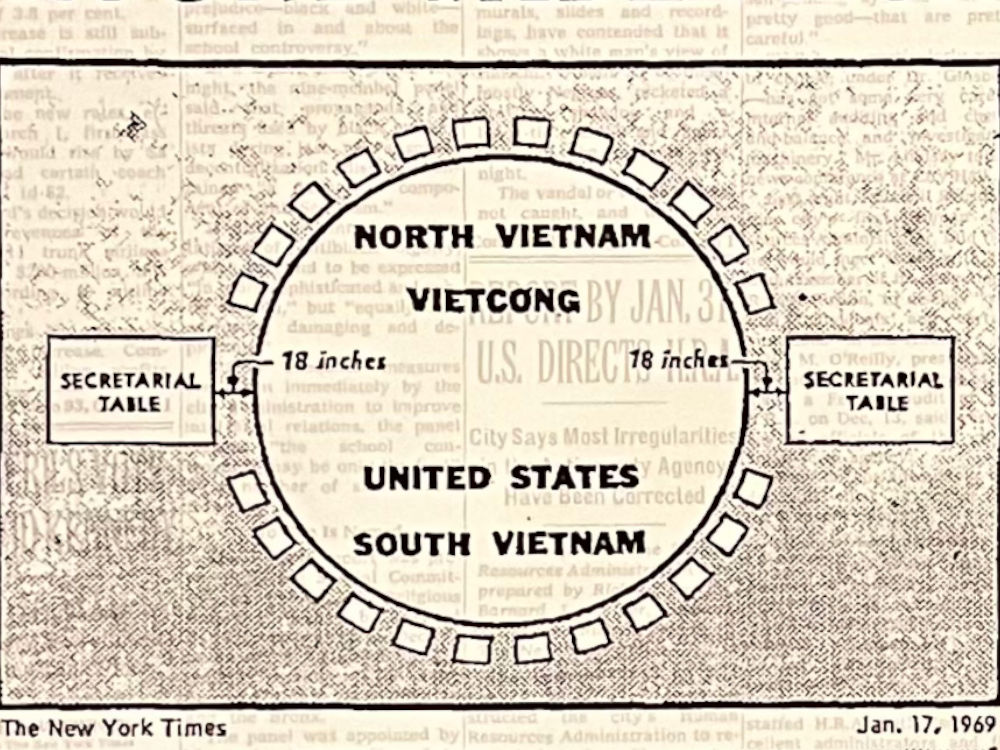
- January 18, 1969
Two days later, the talks began.
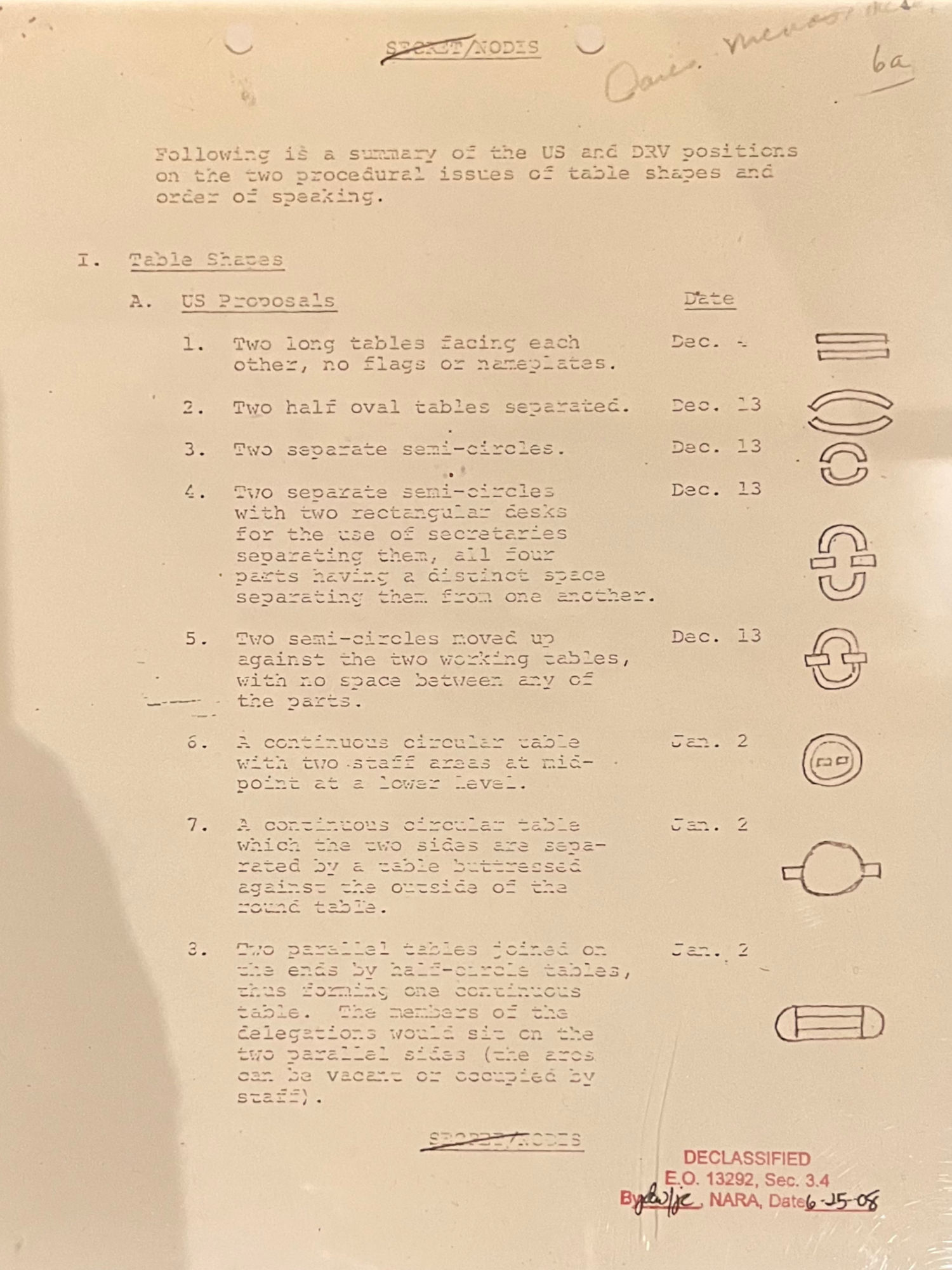
Table Shapes
Following is a summary of the U.S. and DRV positions on the two procedural issues of table shapes and order of speaking.
U.S. Proposals
- Dec. 4 Two long tables facing each other, no flags or nameplates.
- Dec. 13 Two half oval tables separated.
- Dec. 13 Two separate semi-circles.
- Dec. 13 Two separate semi-circles with two rectangular desks for the use of secretaries separating them, all four parts having a distinct space separating them from one another.
- Dec. 13 Two semi-circles moved up against the two working tables, with no space between any of the parts.
- Jan. 2 A continuous circular table with two staff areas at midpoint at a lower level.
- Jan. 2 A continuous circular table which the two sides are separated by a table buttressed against the outside of the round table.
- Jan. 2 Two parallel tables joined on the ends by half-circle tables, thus forming one continuous table. The members of the delegations would sit on the two parallel sides (the arcs can be vacant or occupied by staff).
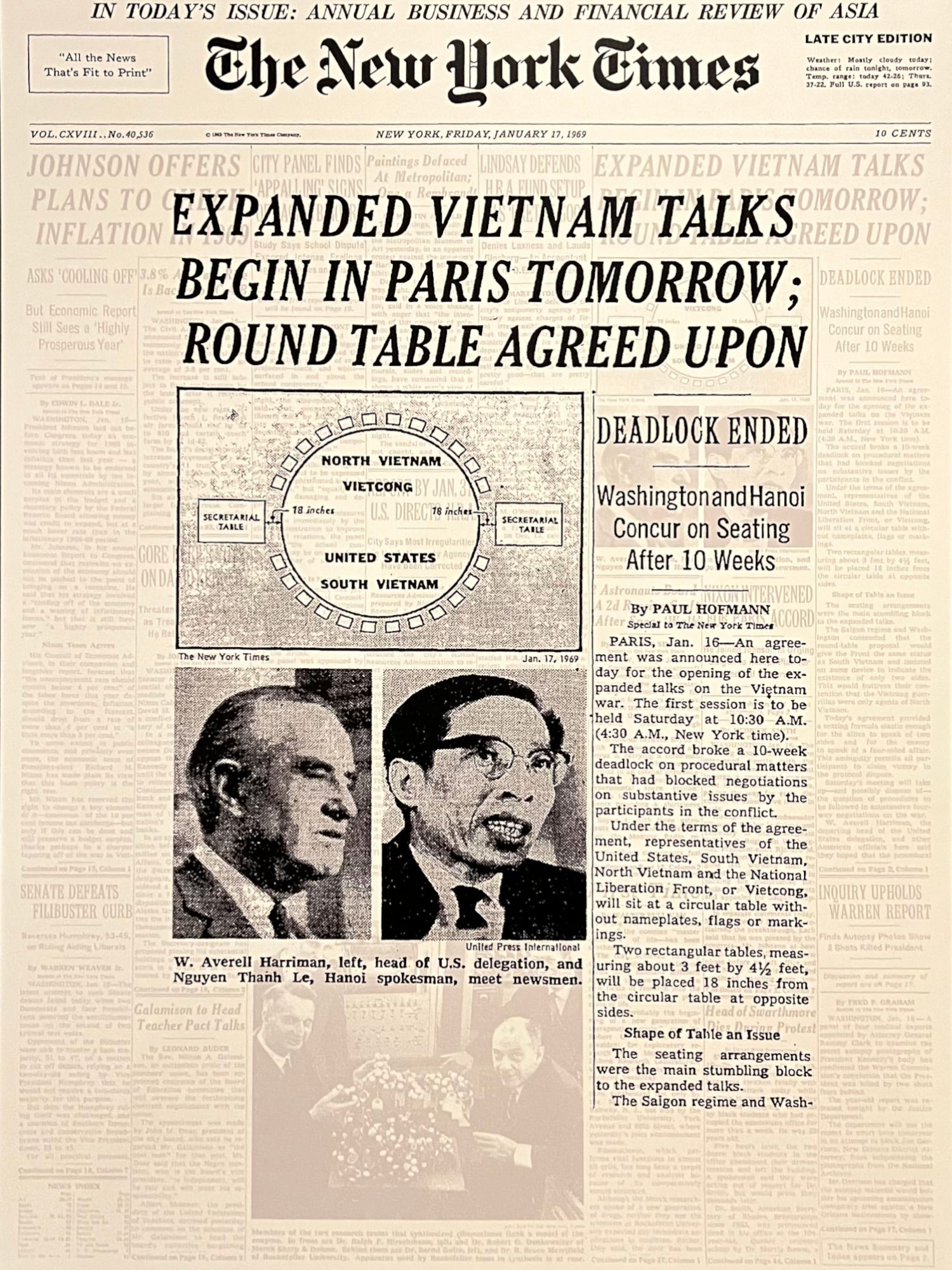
New York Times
The front page of the January 17, 1969, edition of the New York Times
Shows the proposed shape of the negotiation table for the first peace talks among the United States, South Vietnam, North Vietnam, and National Liberation Front.
Deadlock Ended
Washington and Hanoi Concur on Seating After 10 Weeks
By PAUL HOFMANN
PARIS, Jan. 16 - An agreement was announced here today for the opening of the expanded talks on the Vietnam war. The first session is to be held Saturday at 10:30 A.M. (4:30 A.M., New York time).
The accord broke a 10-week deadlock on procedural matters that had blocked negotiations on substantive issues by the participants in the conflict.
Under the terms of the agreement, representatives of the United States, South Vietnam, North Vietnam, and the National Liberation Front or Vietcong, will sit at a circular table without nameplates, flags, or markings.
Two rectangular tables, measuring about 3 feet by 4 1/2 feet, will be placed 18 inches from the circular table at opposite sides.
Shape of Table an Issue
The seating arrangements were the main stumbling block to the expanded talks.
The Saigon regime and Wash-
| PRE-VIETNAM WAR: | |
|---|---|
| PAGE 1 | |
| What is a POW? | |
| 1775 | American Revolution POWs |
| 1812 | War of 1812 POWs |
| 1865 | Civil War POWs |
| 1917 | World War I POWs |
| 1920 | Ho Chi Minh |
| 1941 | World War Ii POWs |
| 1942 | World War II Japanese Internment |
| 1945 | Brief History of Vietnam |
| 1947 | Truman Doctrine |
| 1949 | Geneva Conventions |
| 1950 | Korean War POWs |
| 1954 | Indochina Communist Expansion |
| 1954 | 17th Parallel |
| 1955 | POW Code of Conduct |
| 1963 | Tiger Cages |
| THE NIXON YEARS: | |
|---|---|
| PAGE 3 | |
| 1968 | 1968 Campaign |
| Requirements For Peace | |
| 1969 | Alive or Dead? |
| Ross Perot's Christmas Delivery | |
| 1970 | Missing in Action |
| The Camps | |
| POW / MIA Bracelets | |
| 1971 | Write Hanoi |
| Live From Space | |
| 1972 | Air War in Vietnam |
| Operation Linebacker II | |



